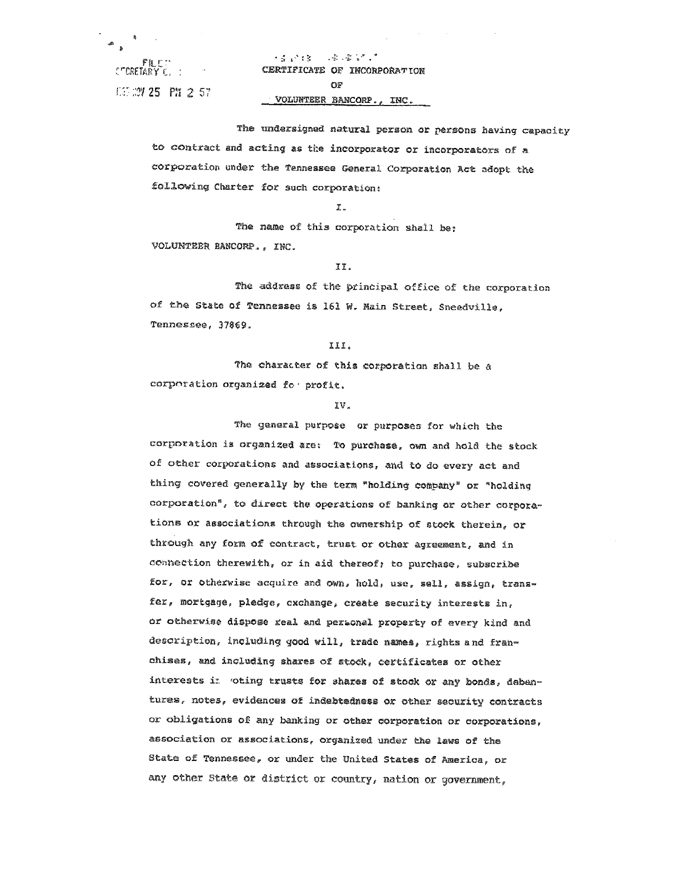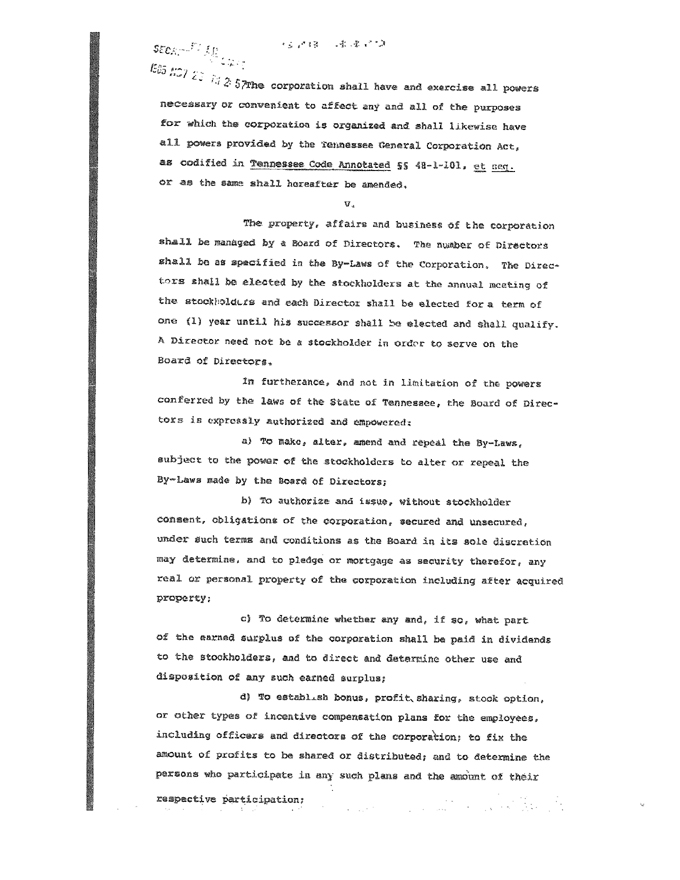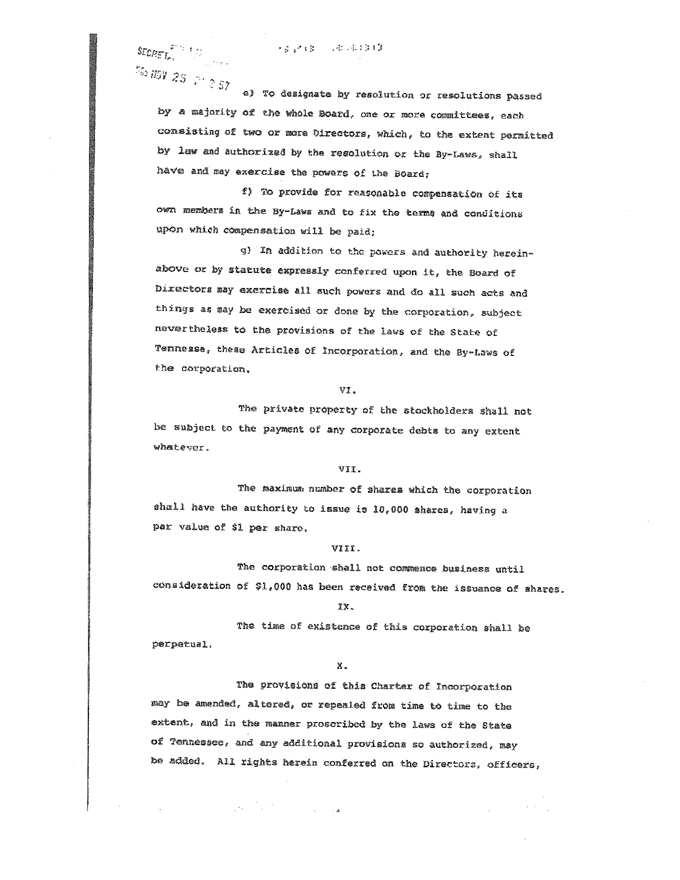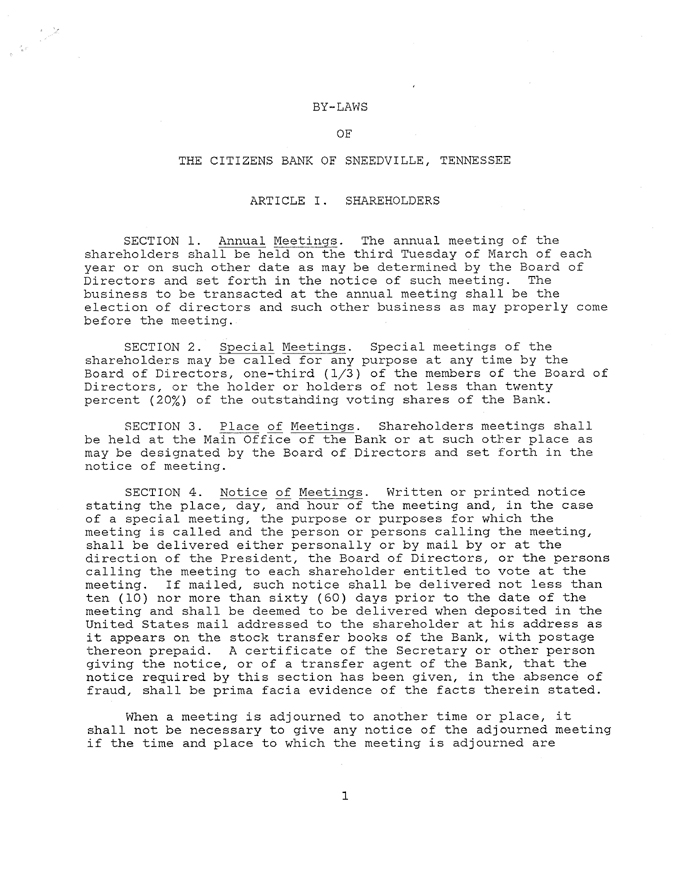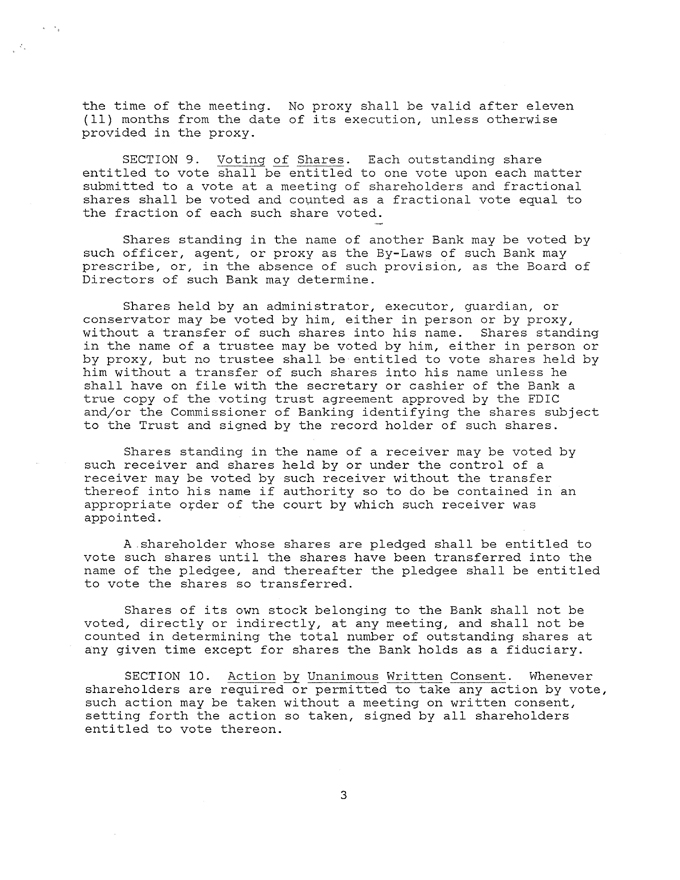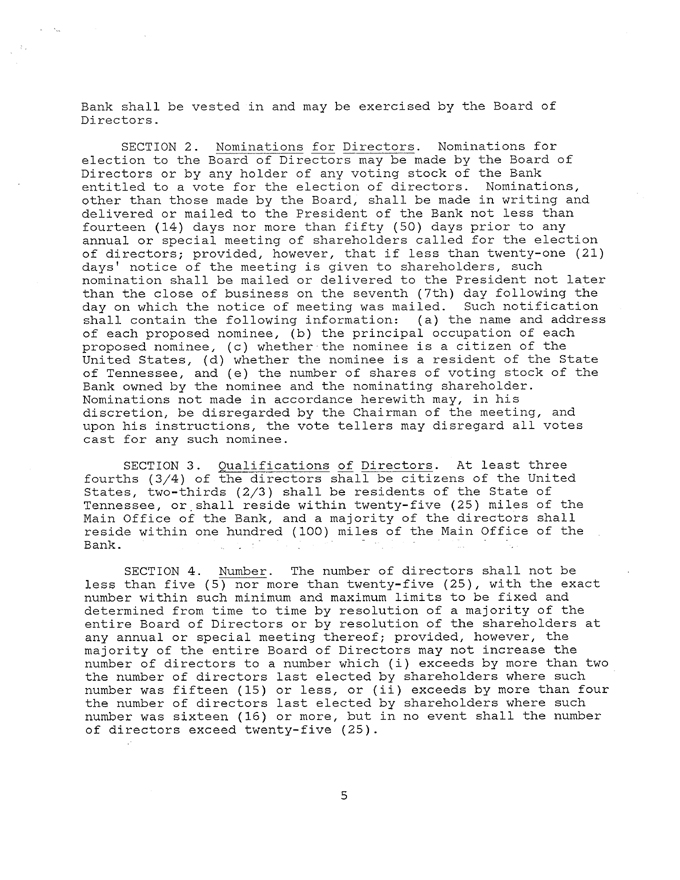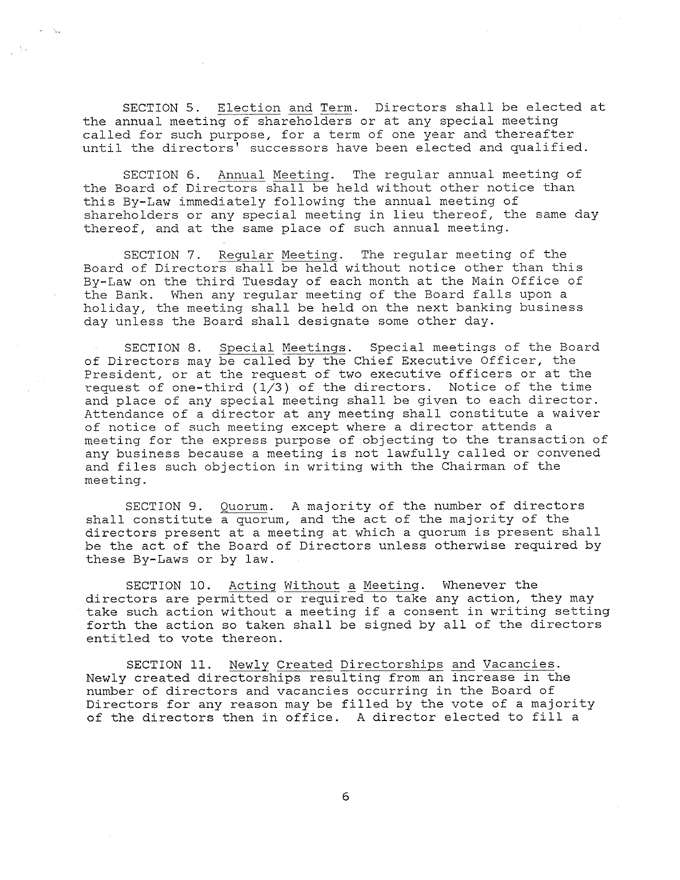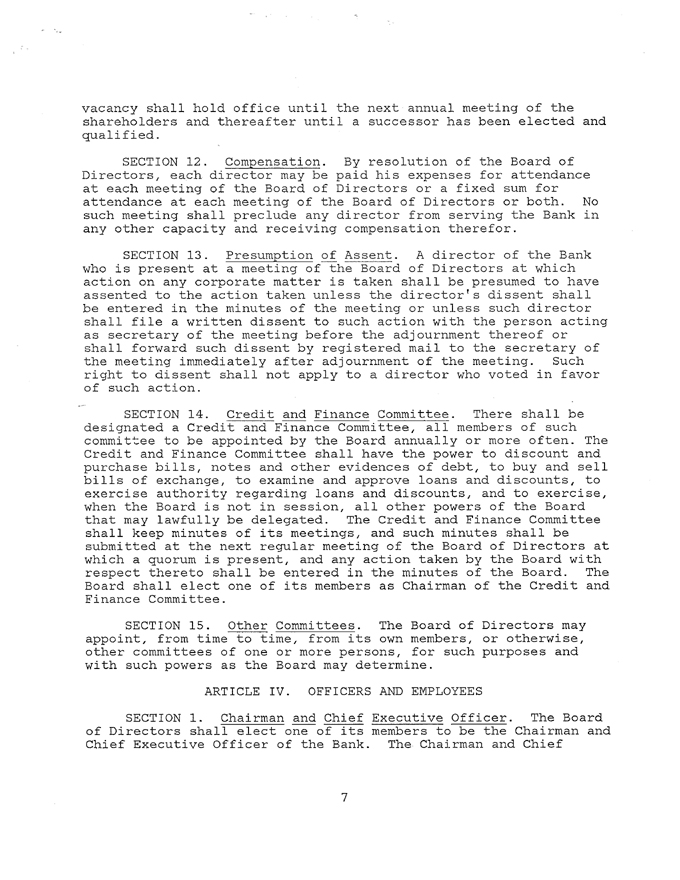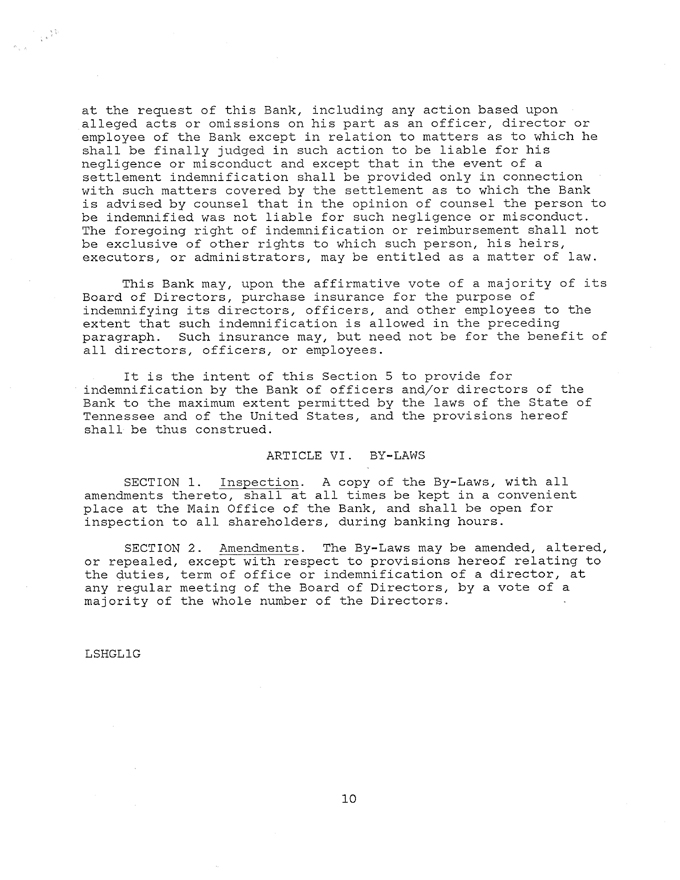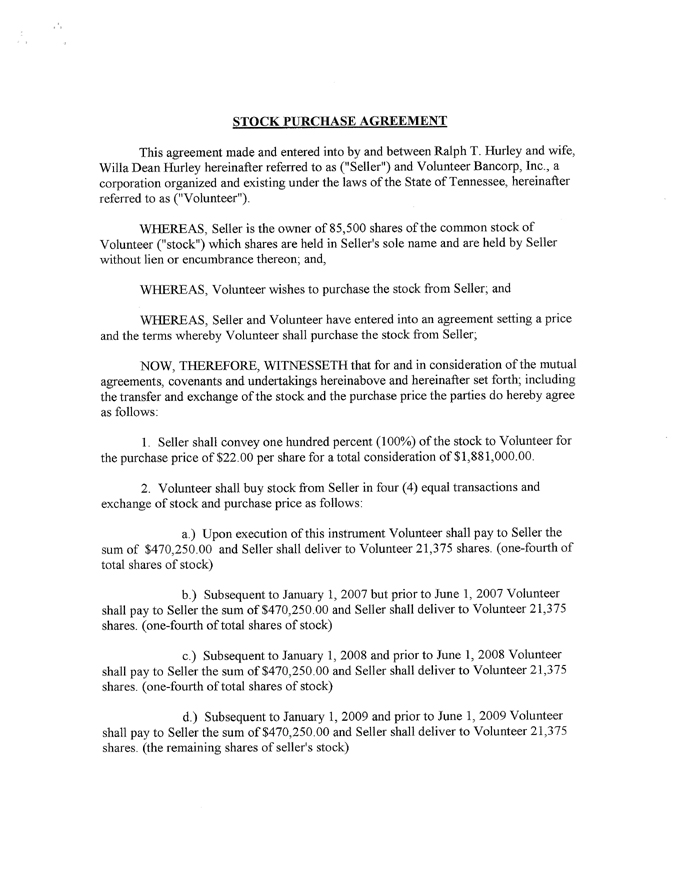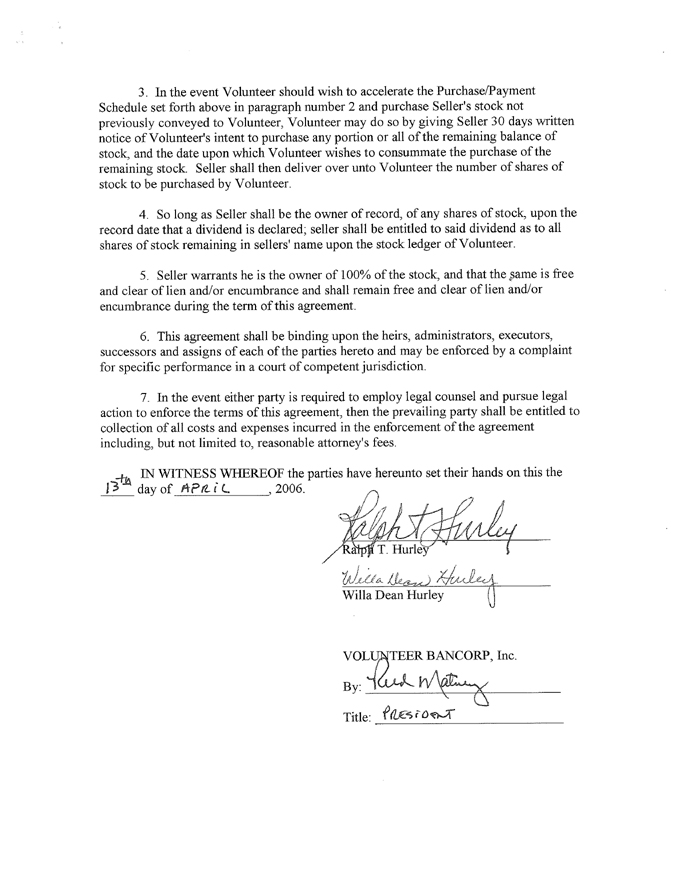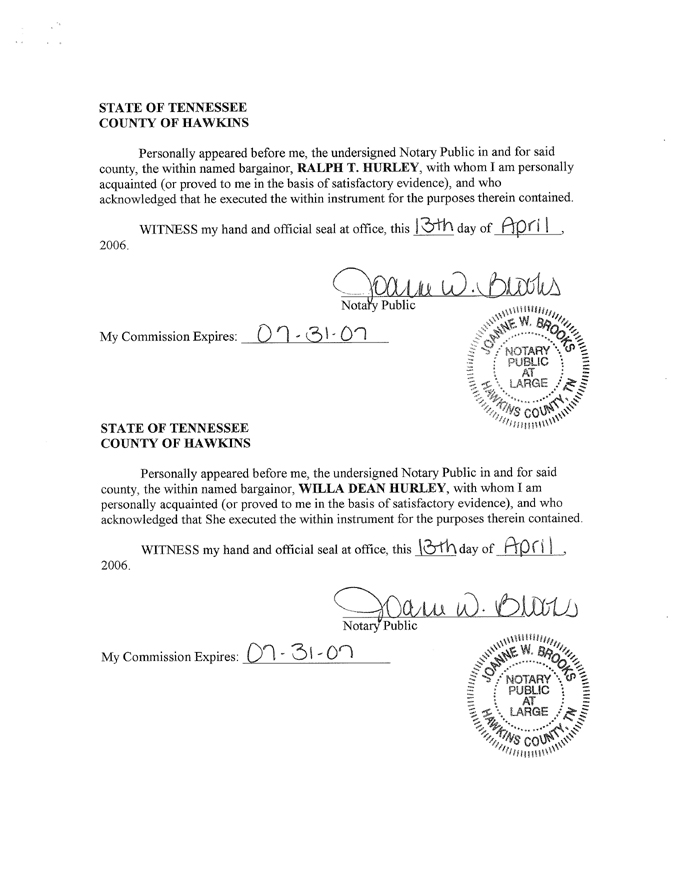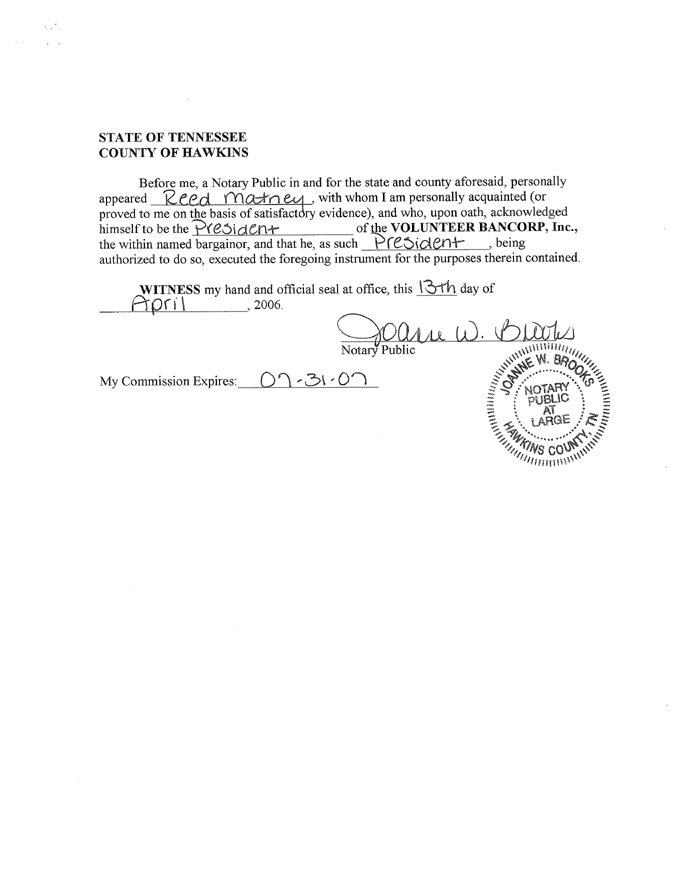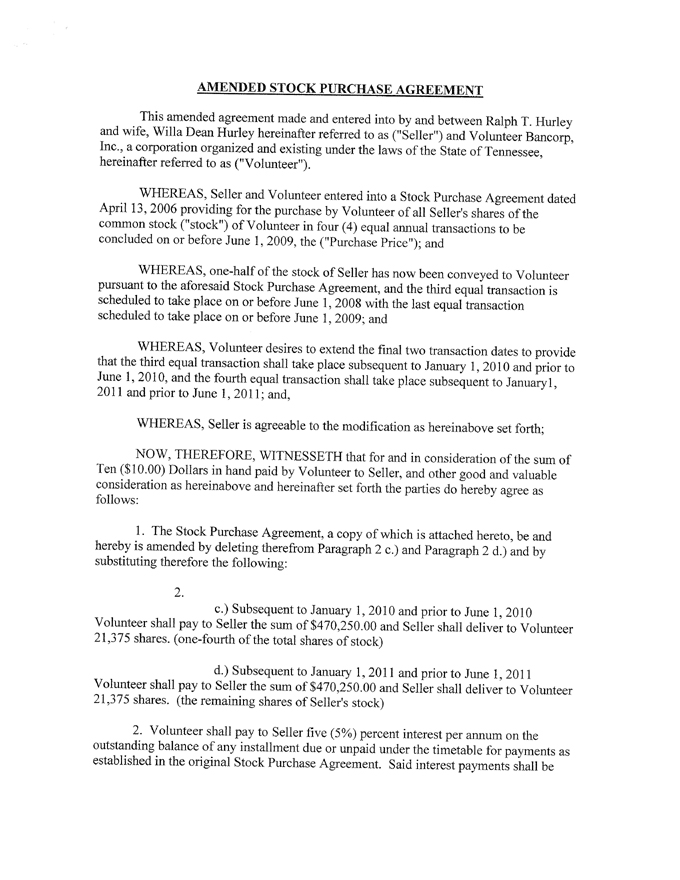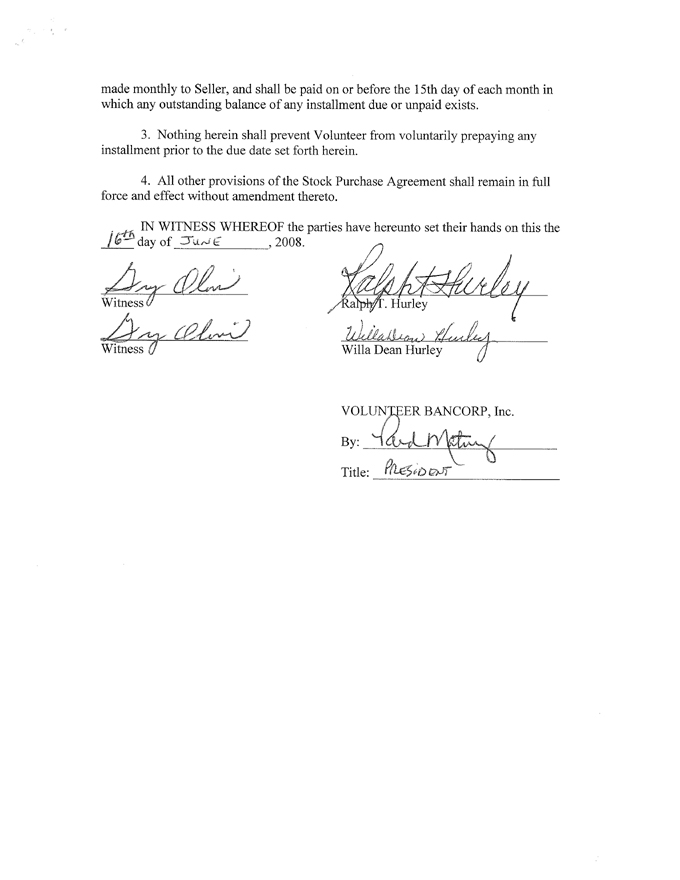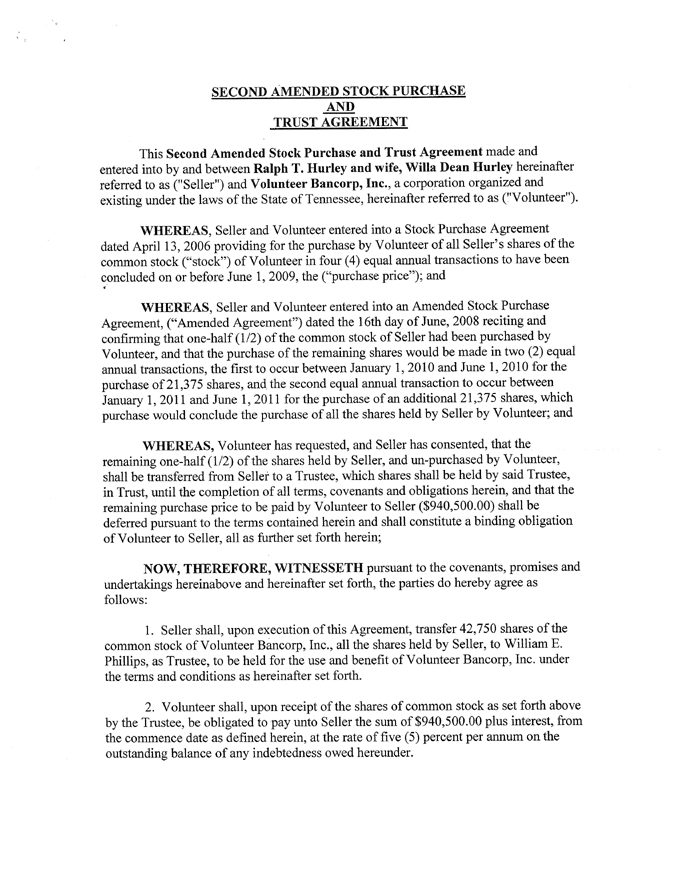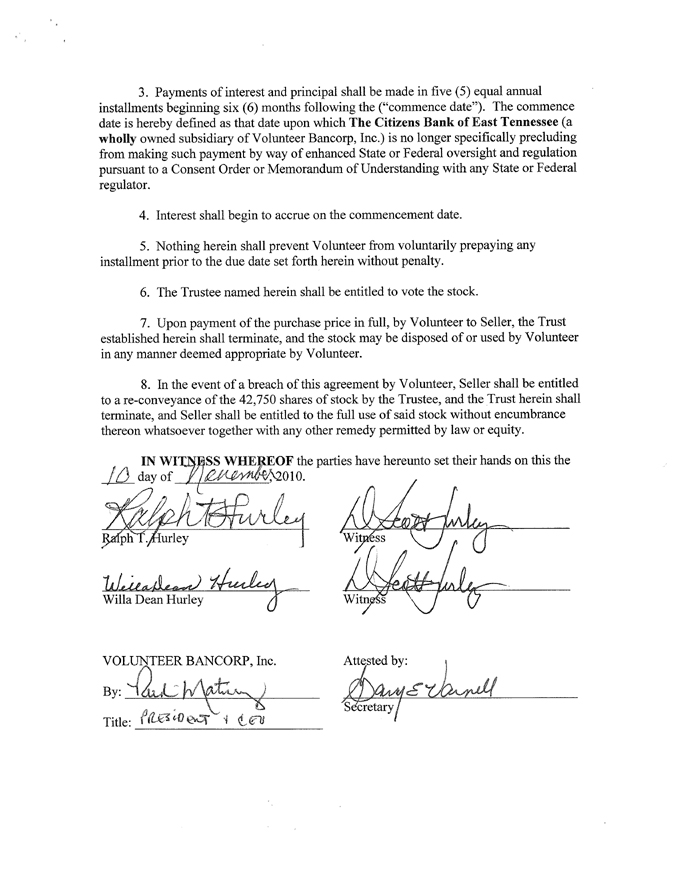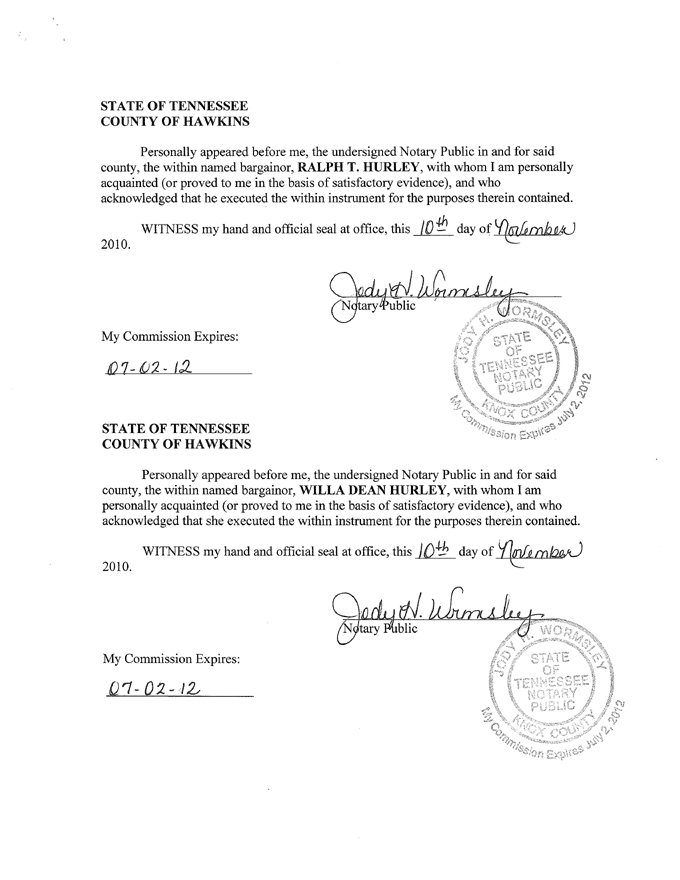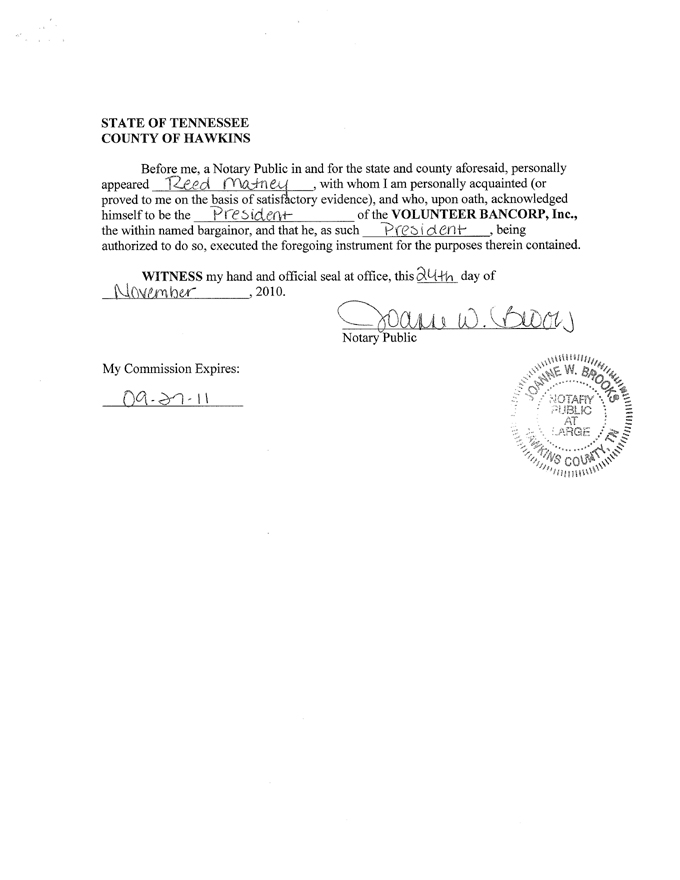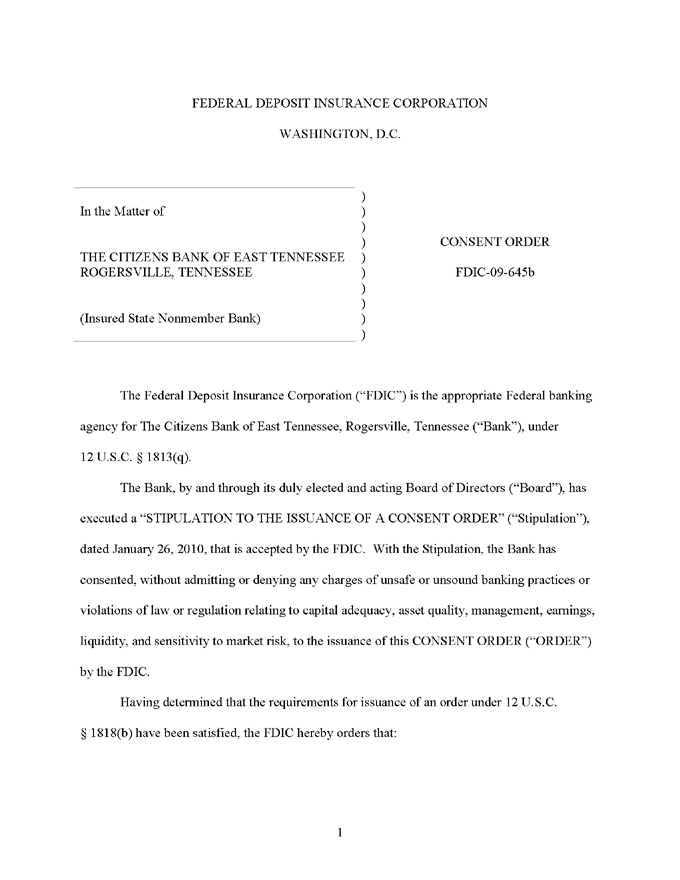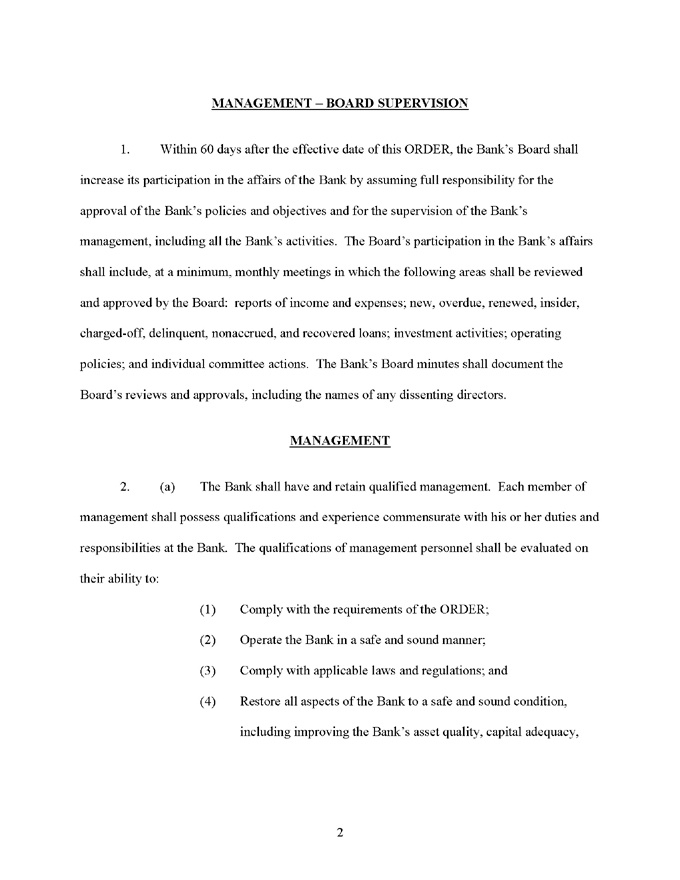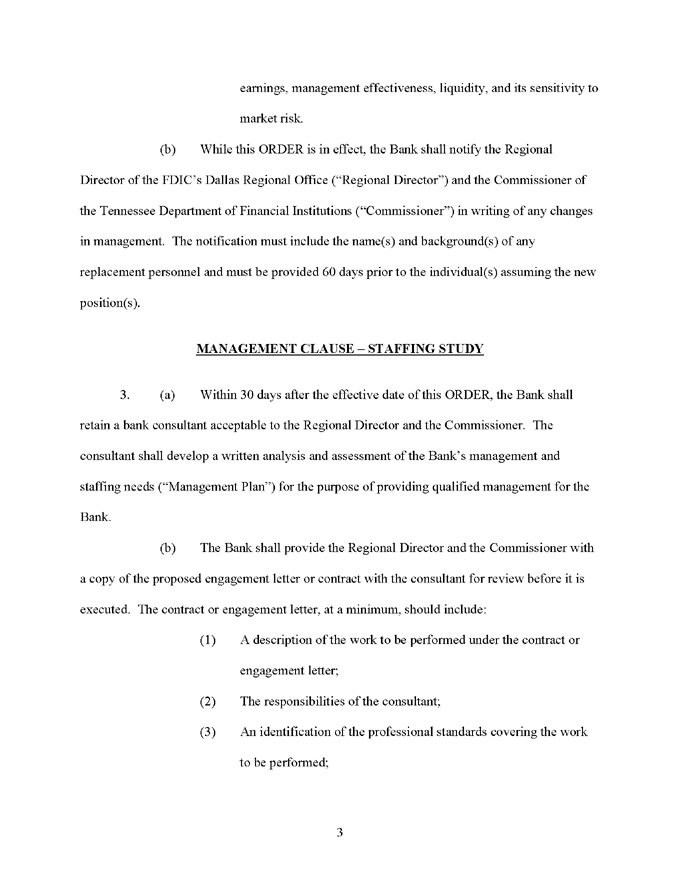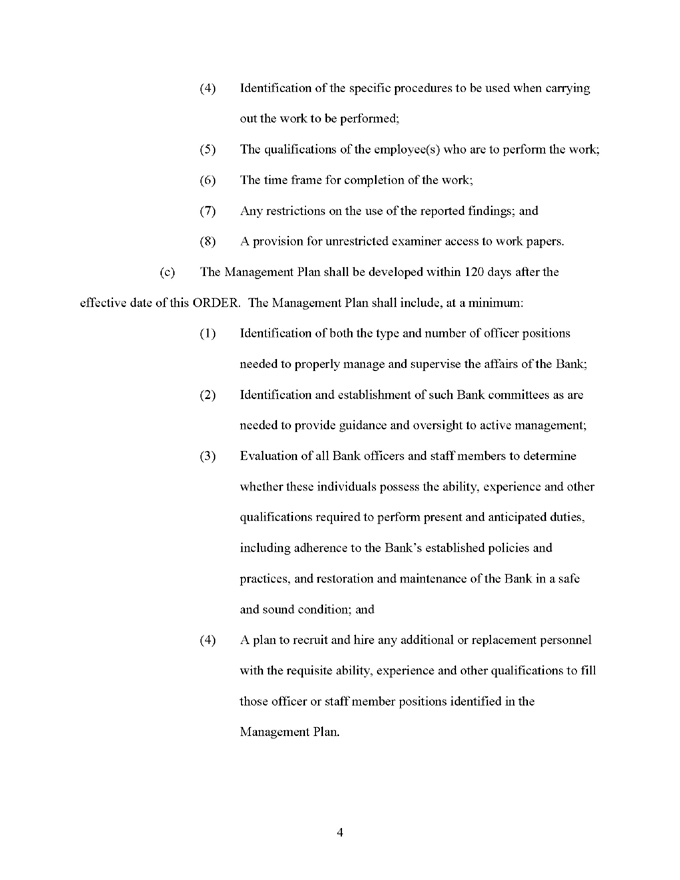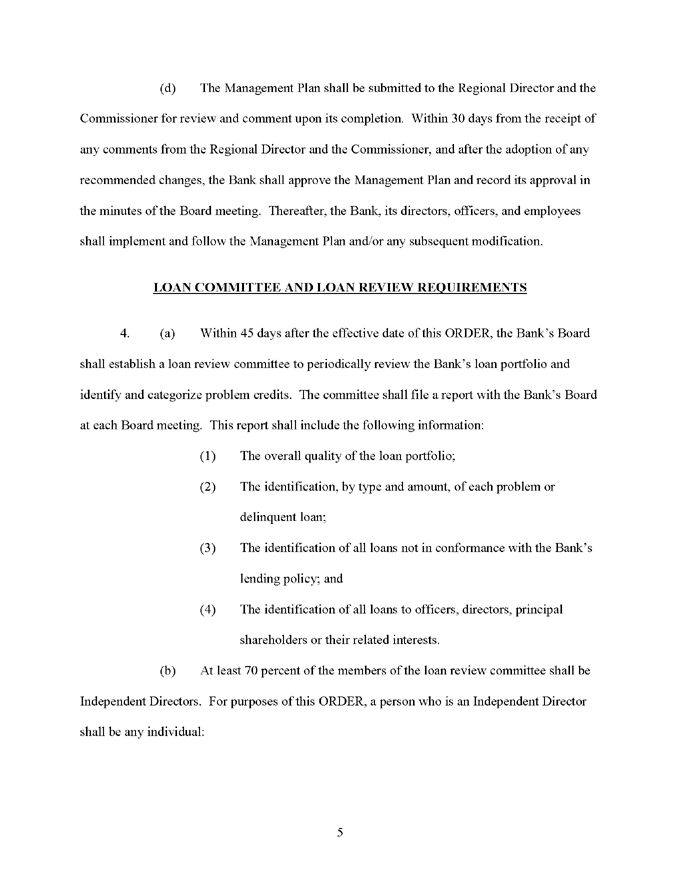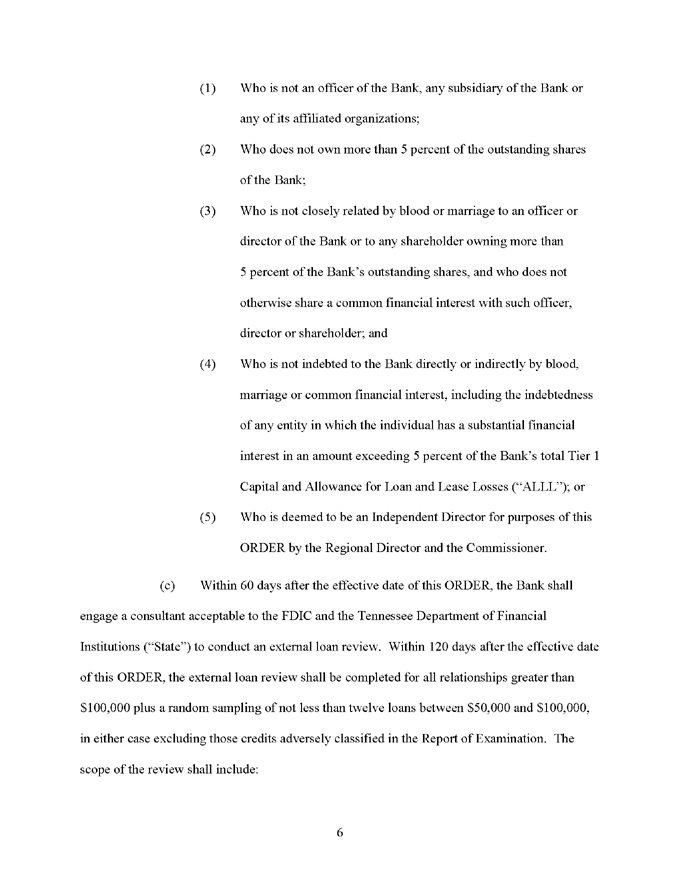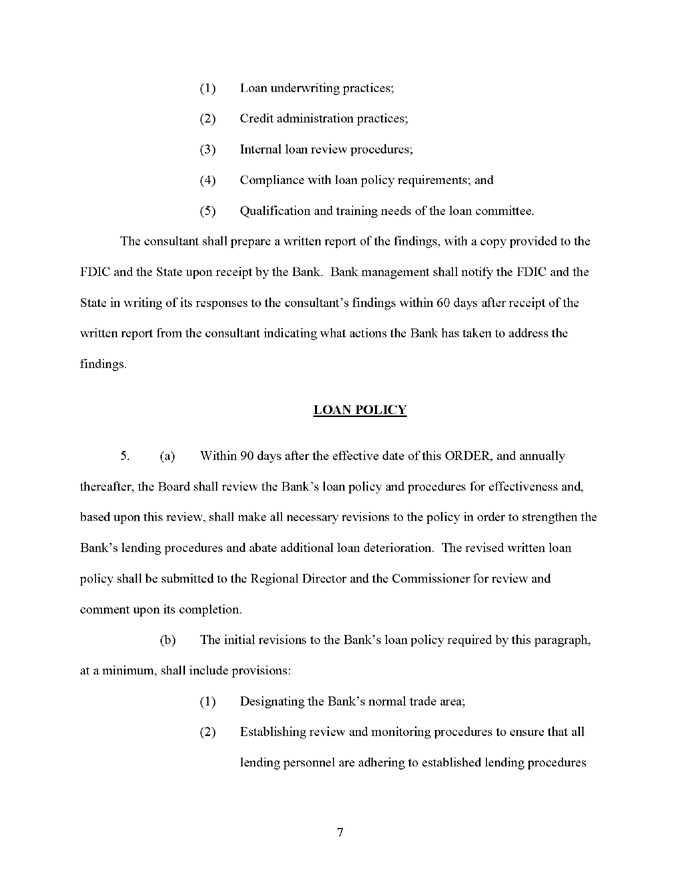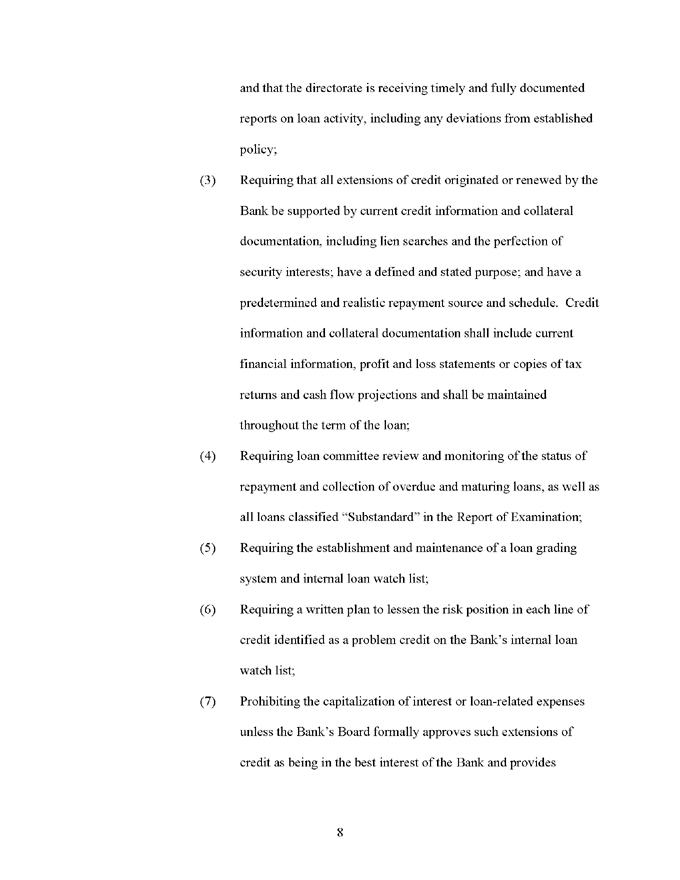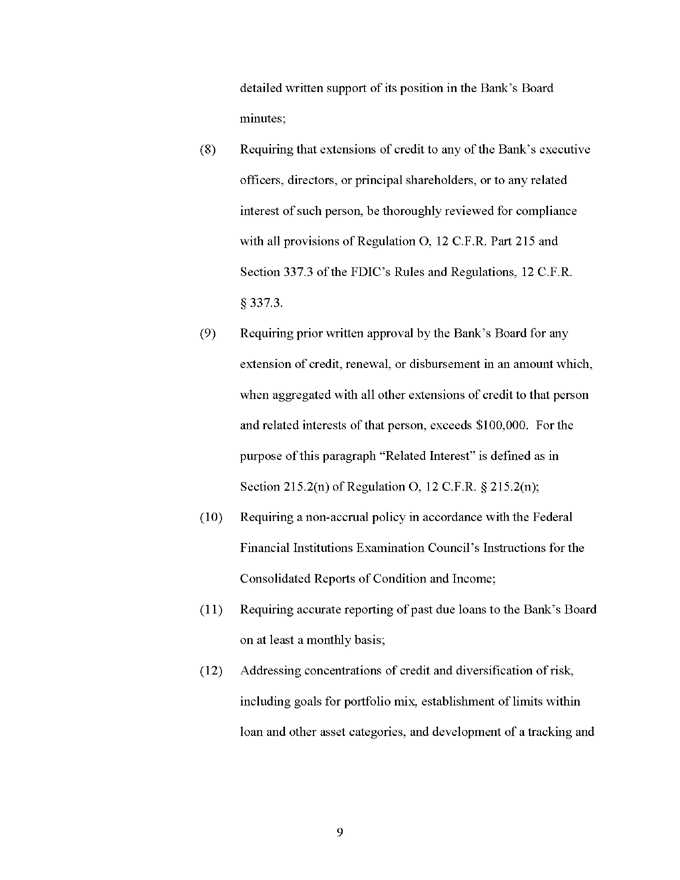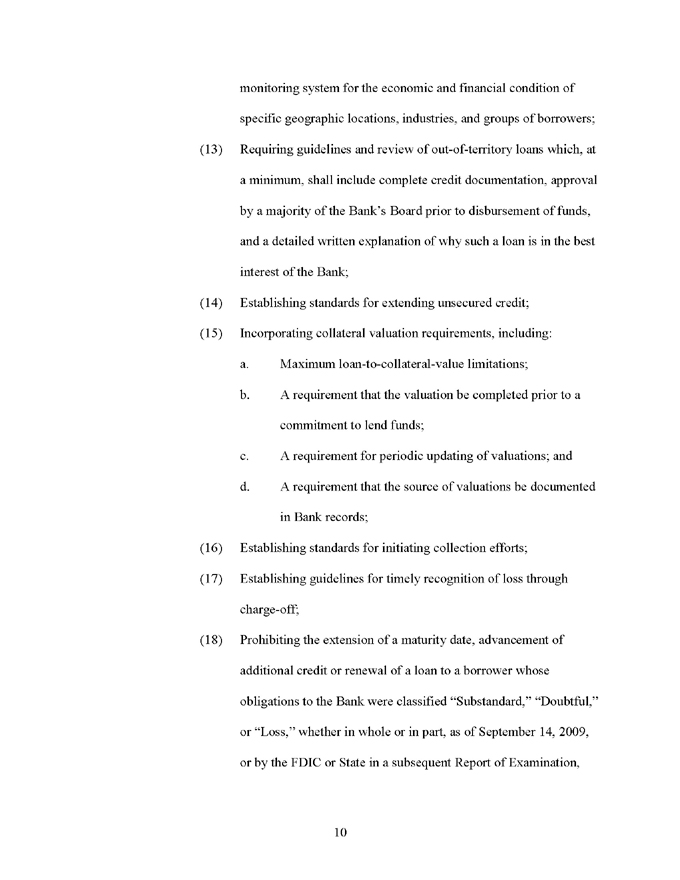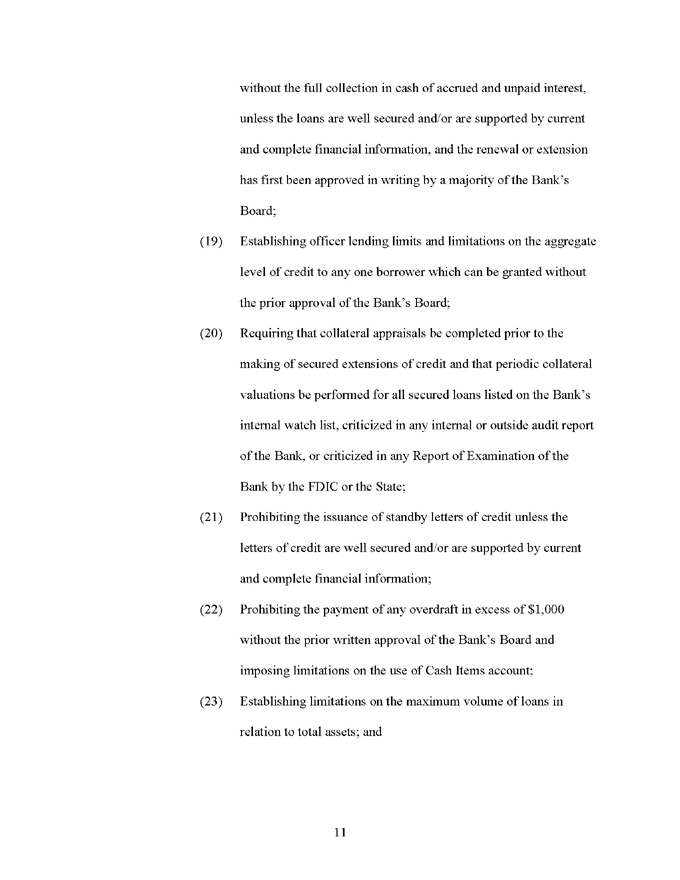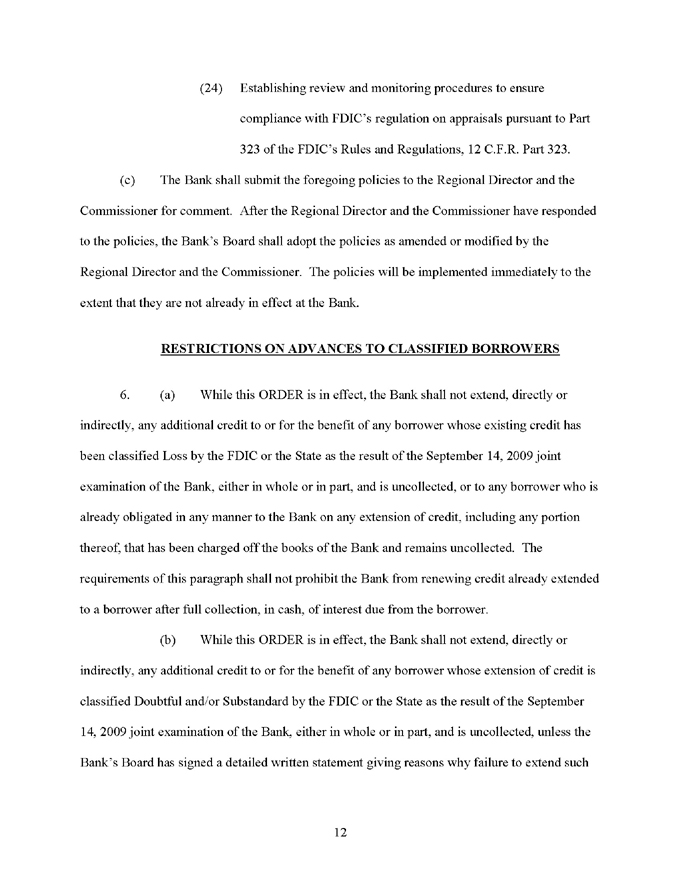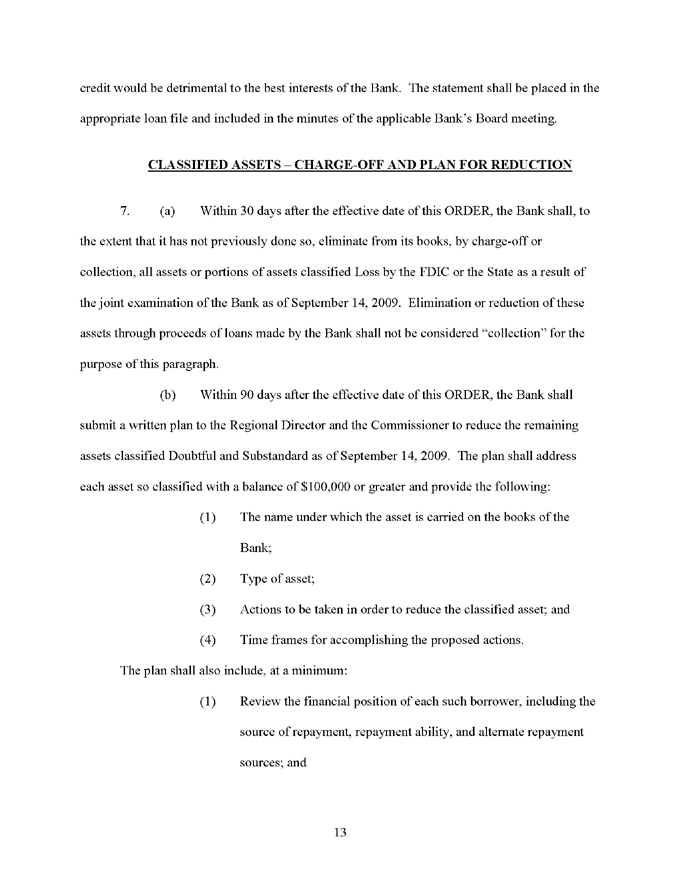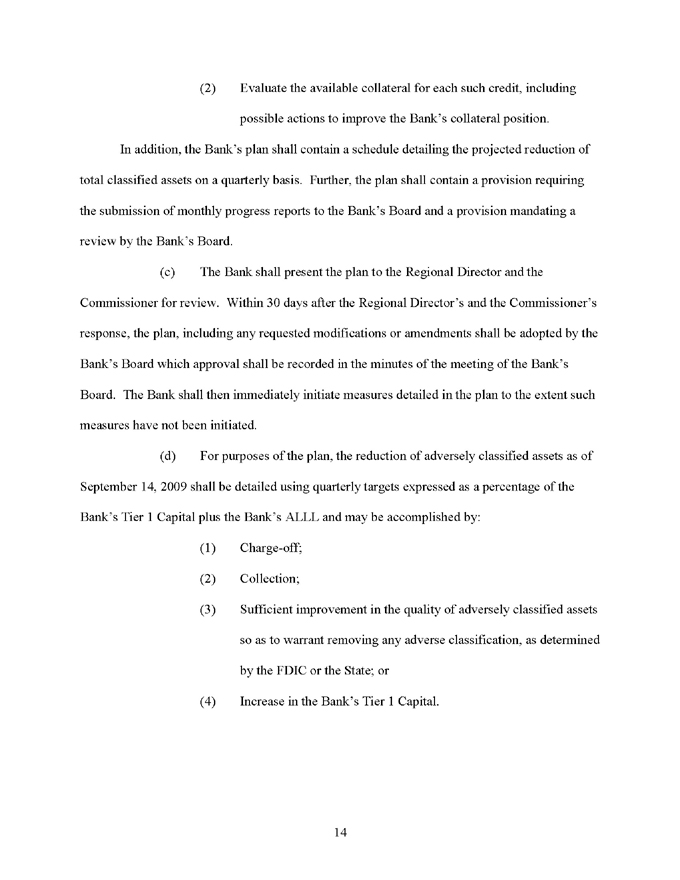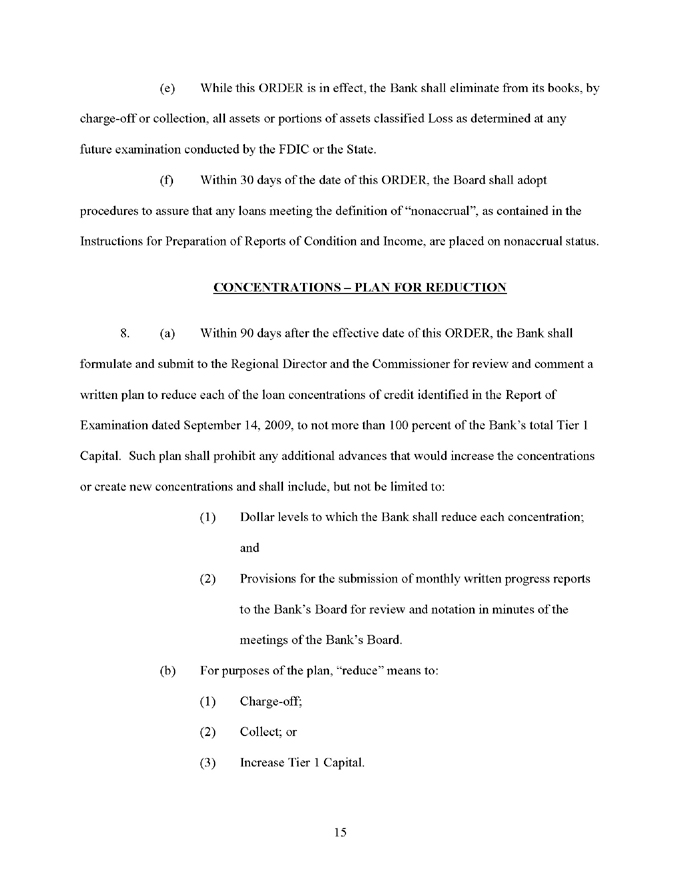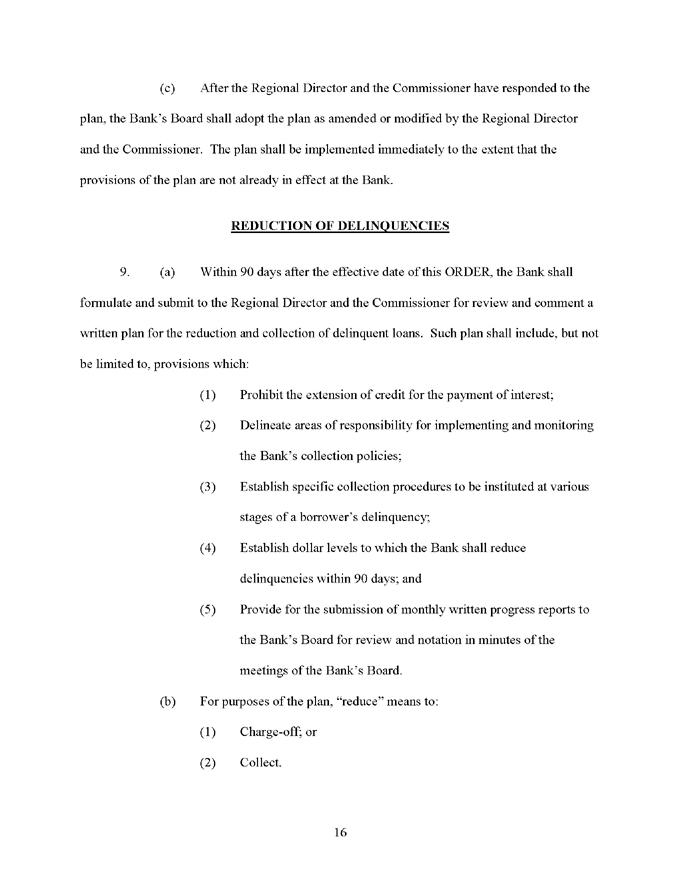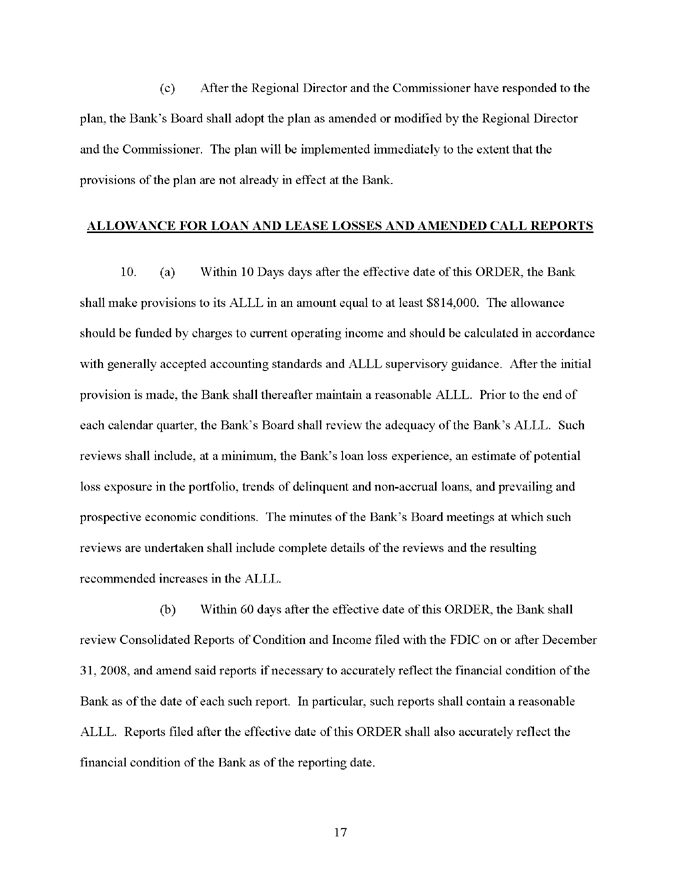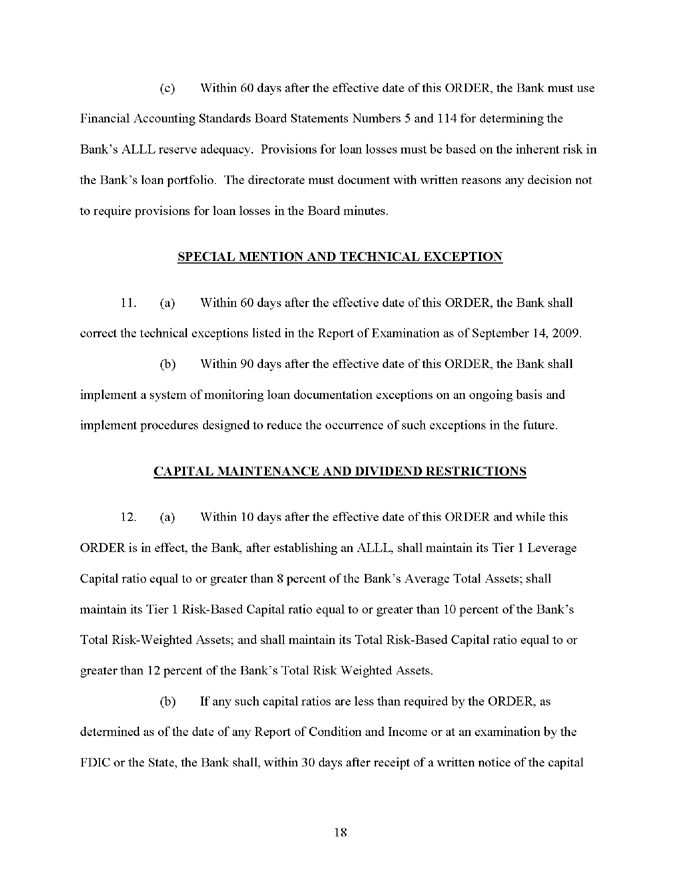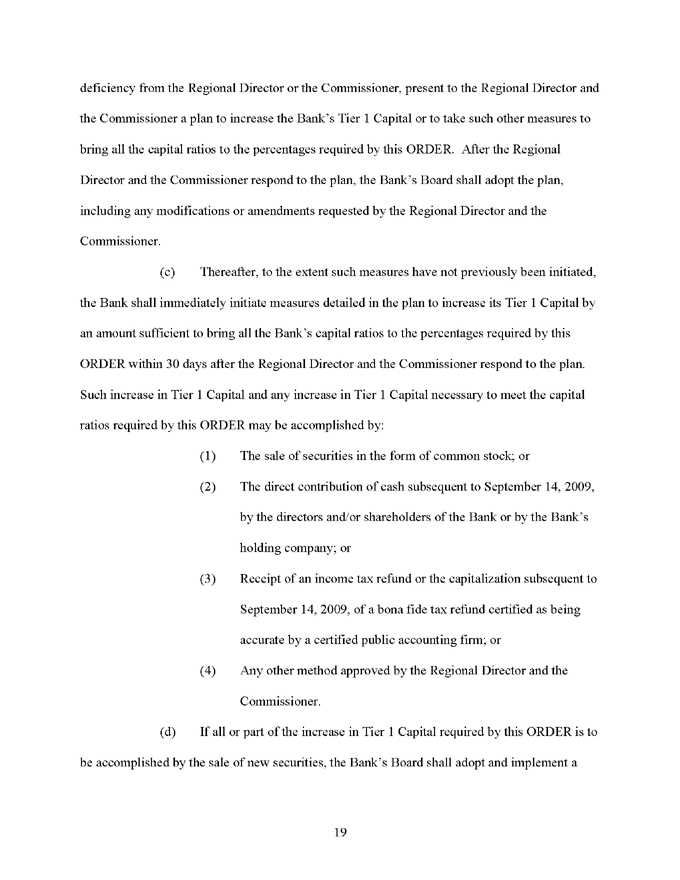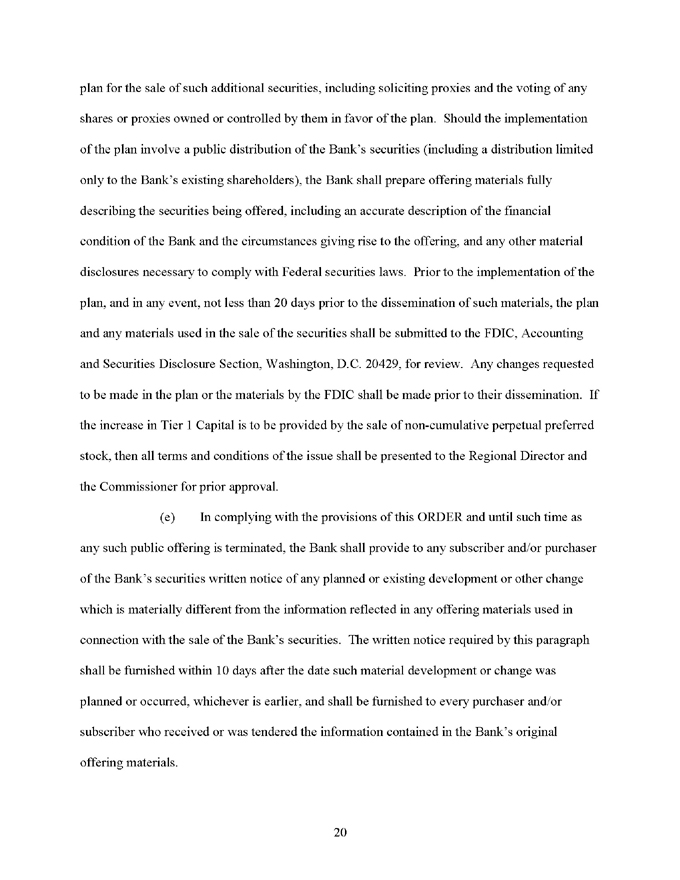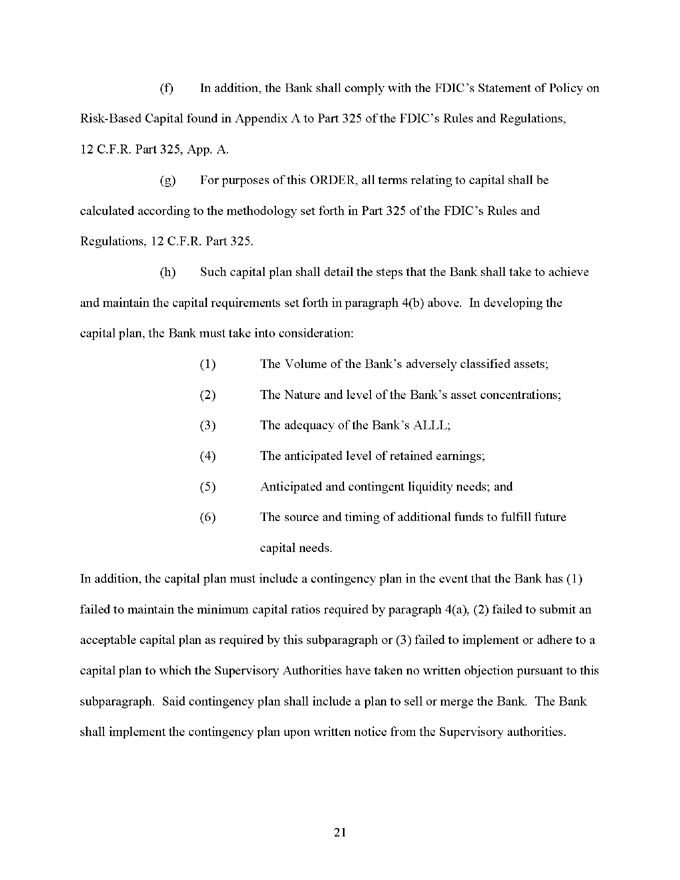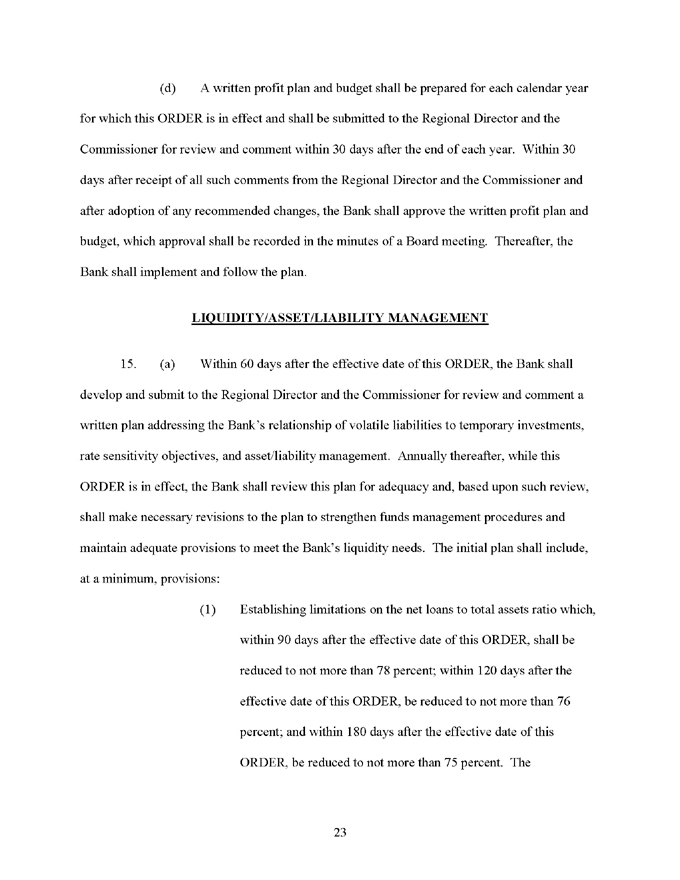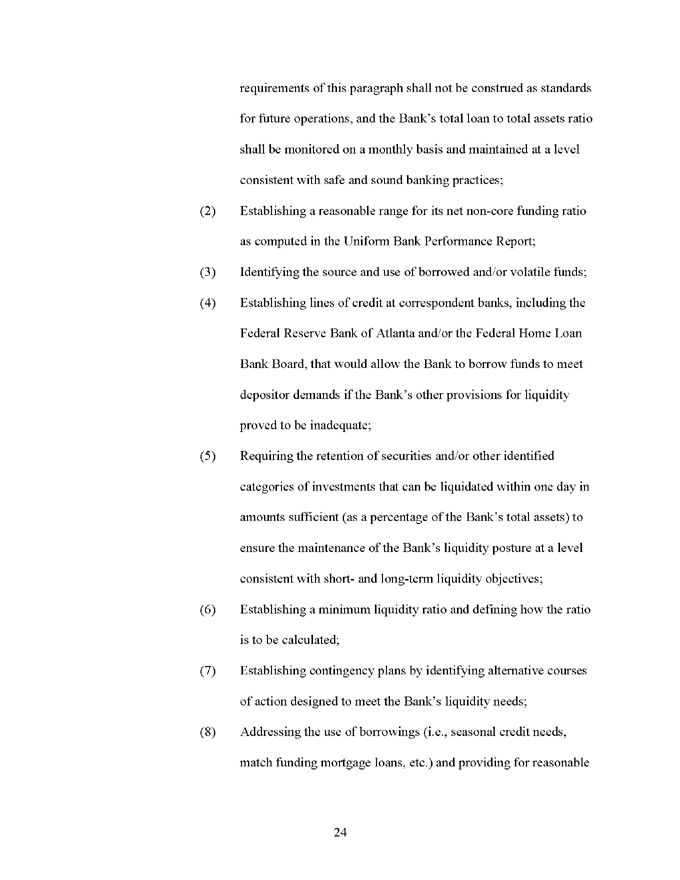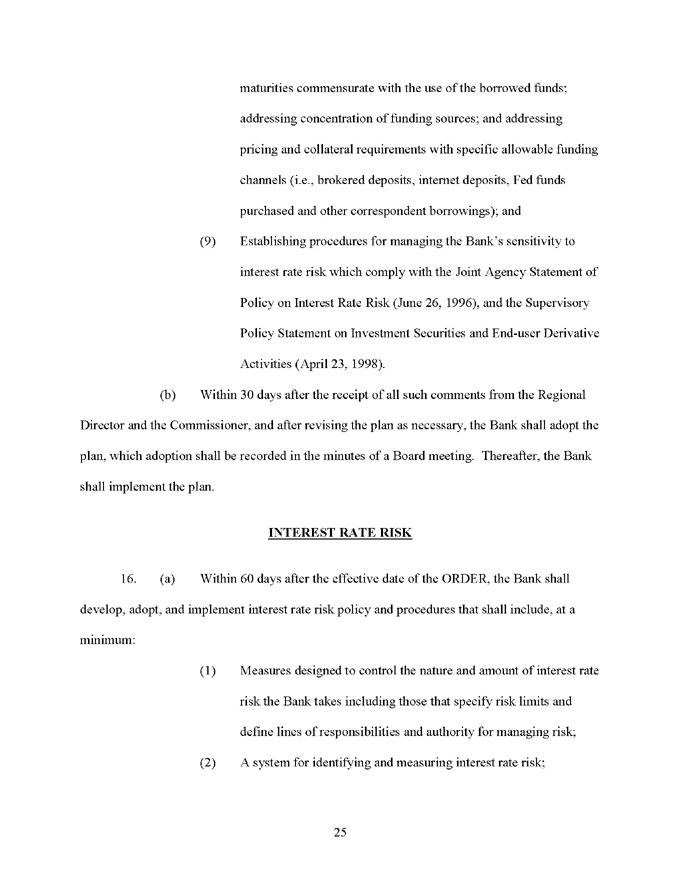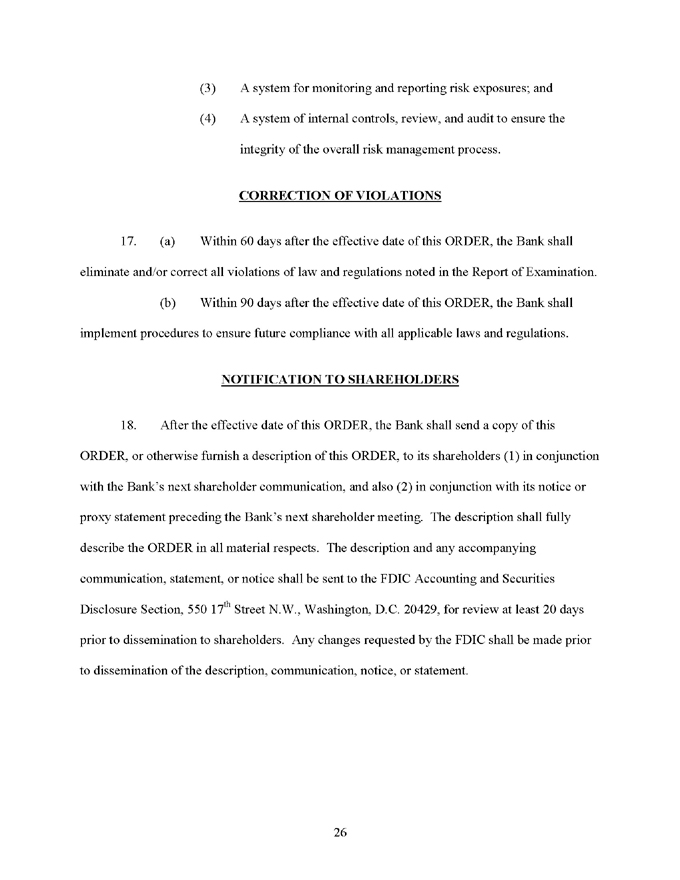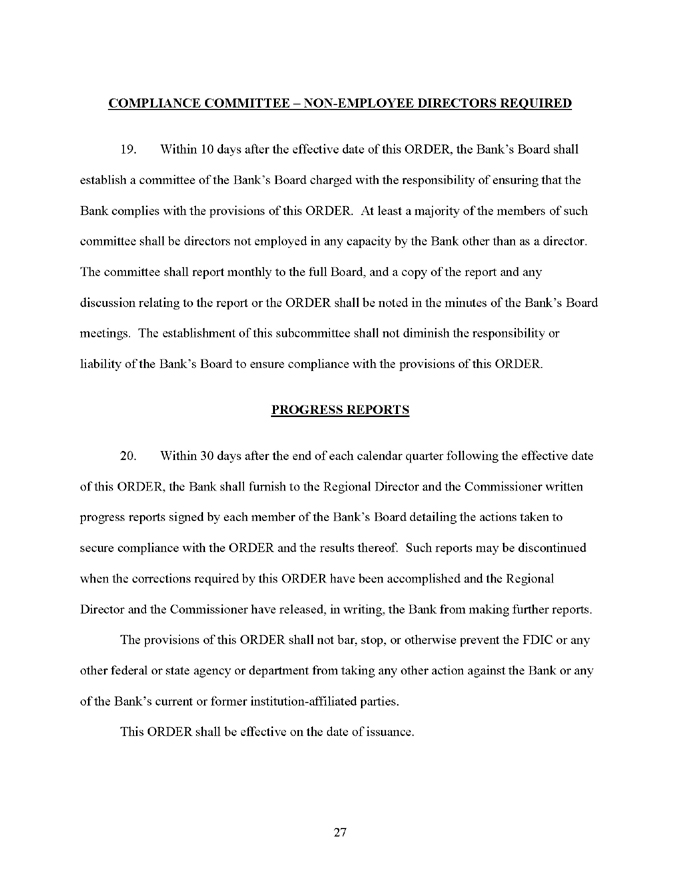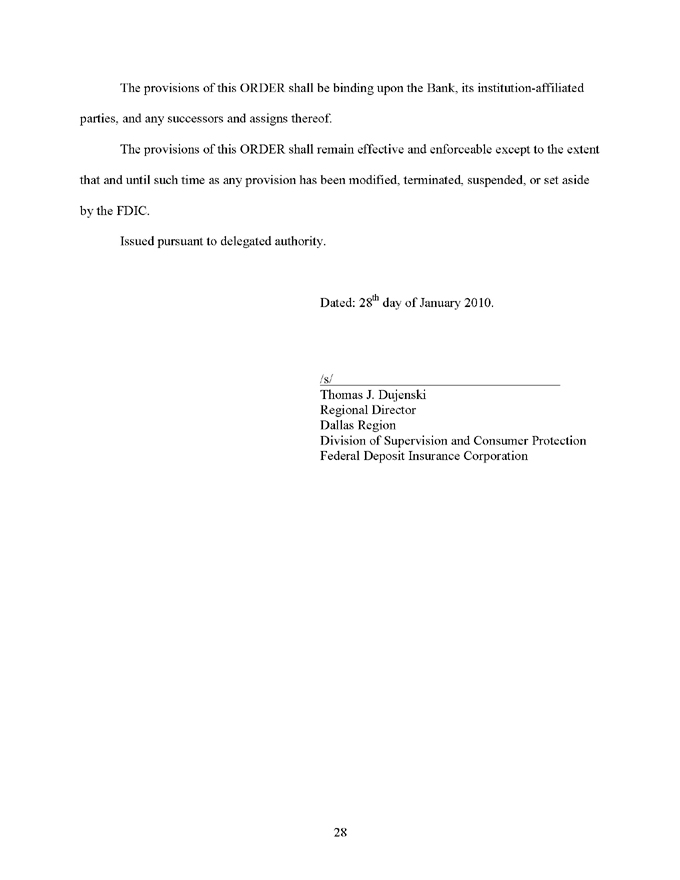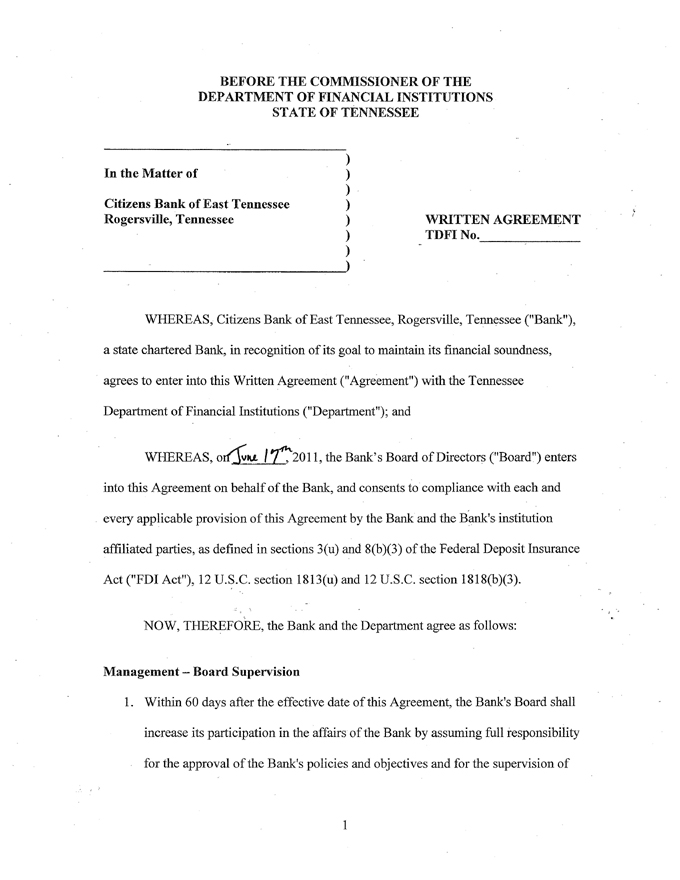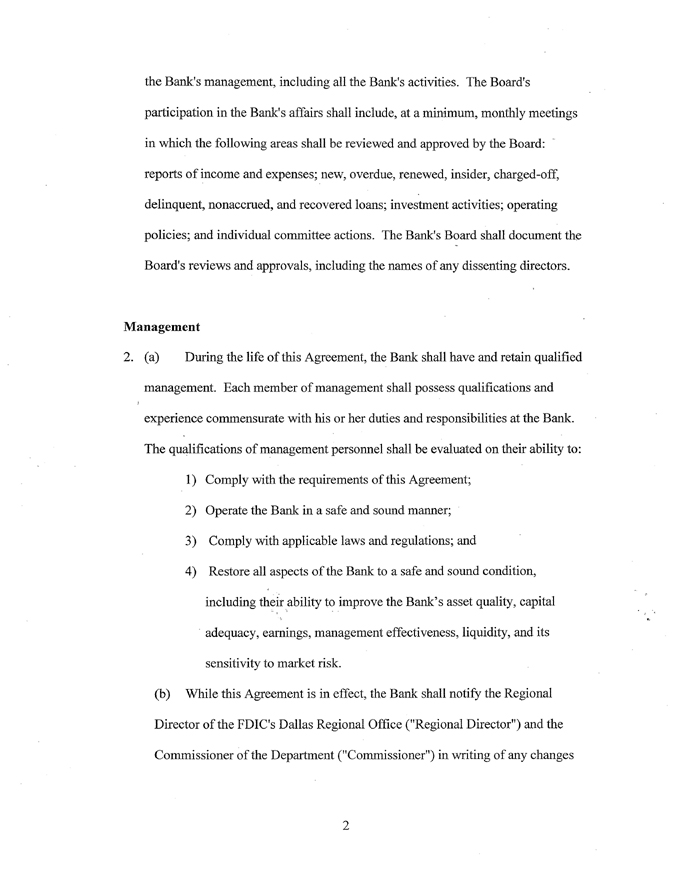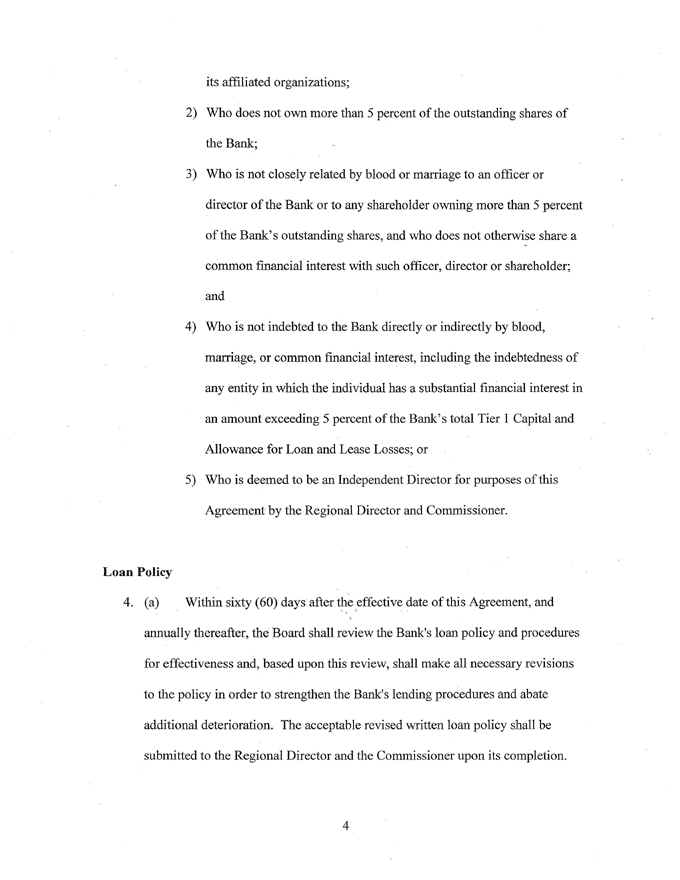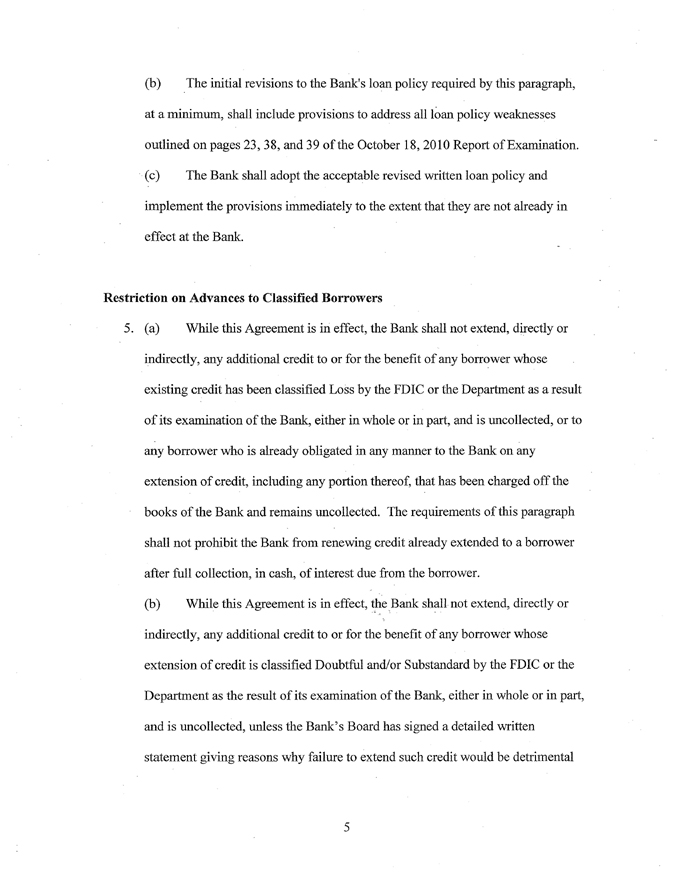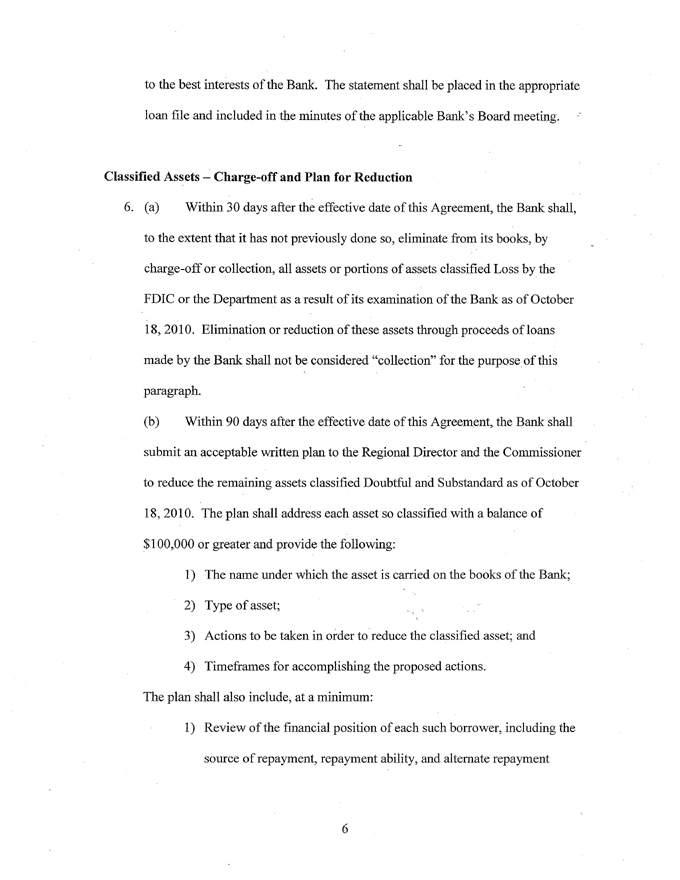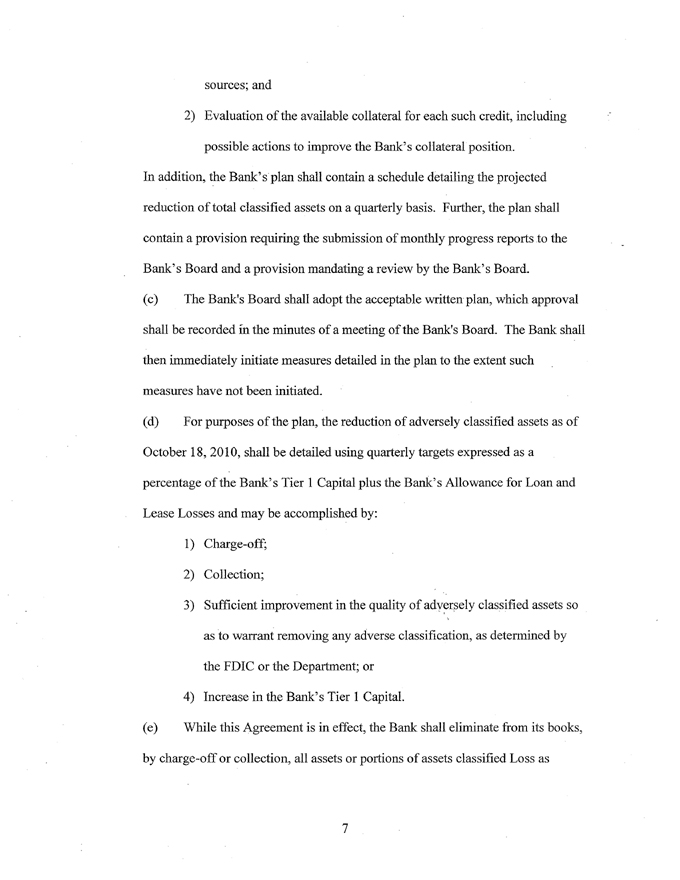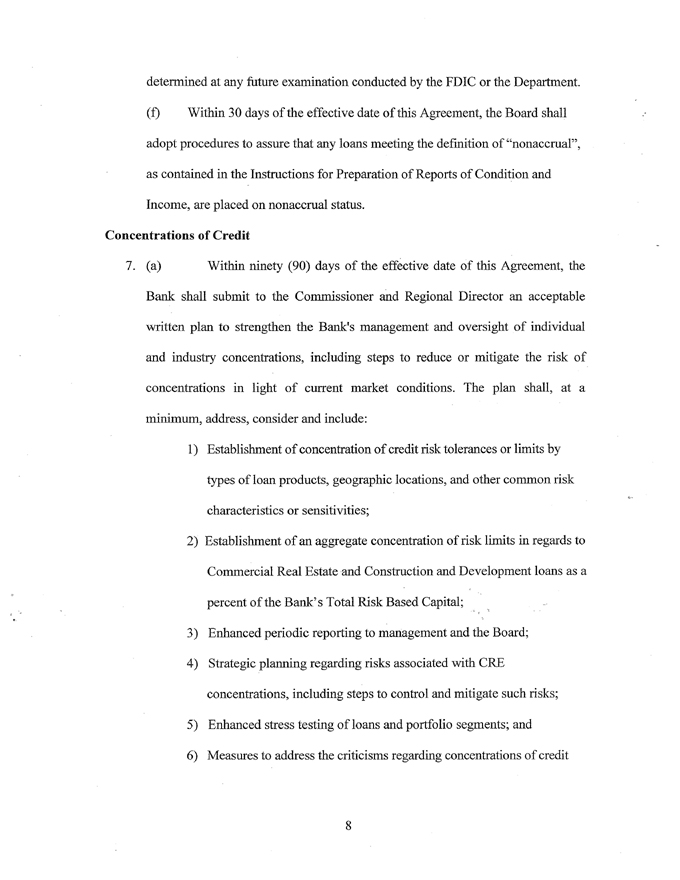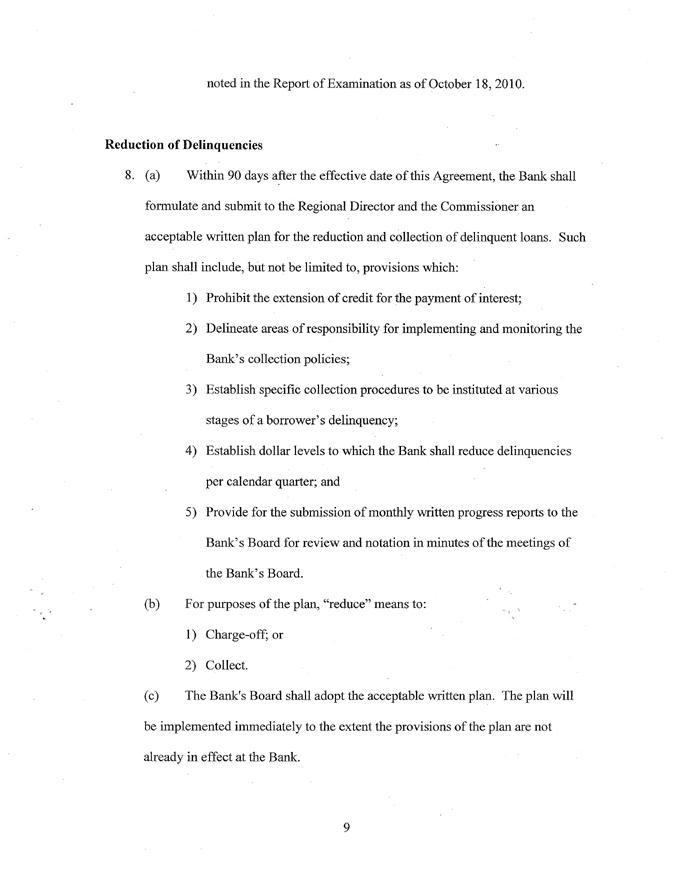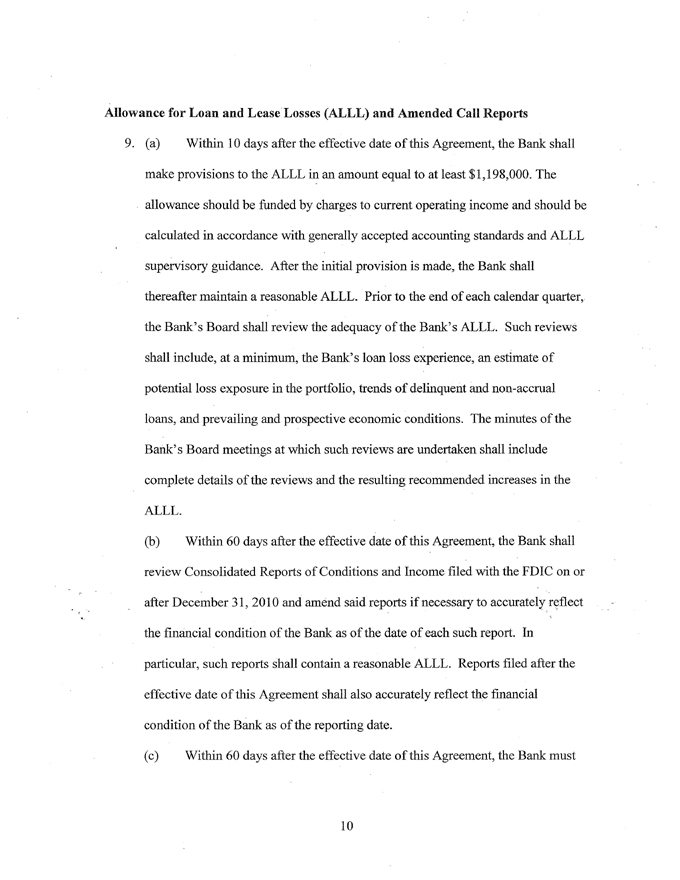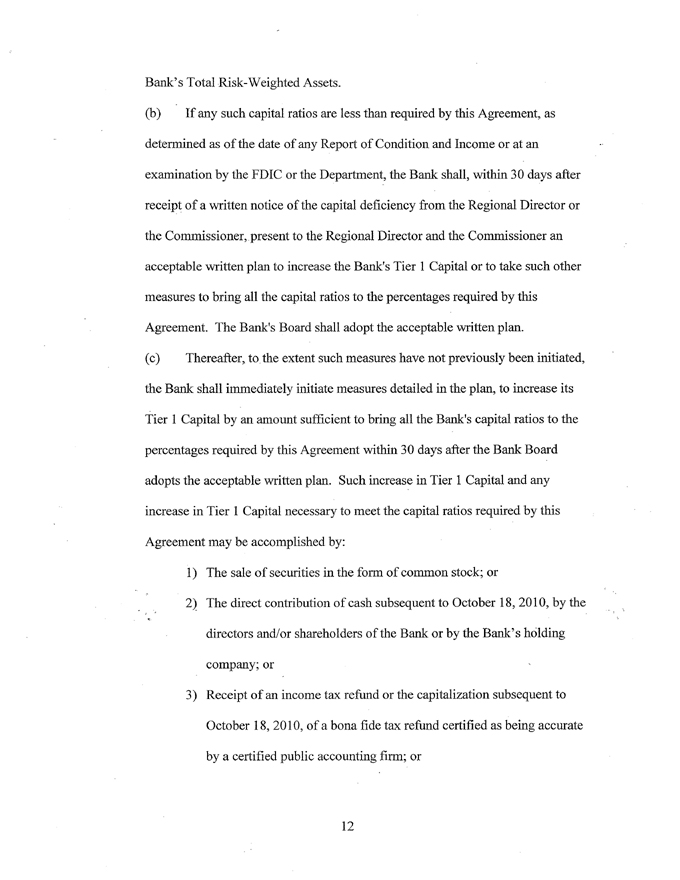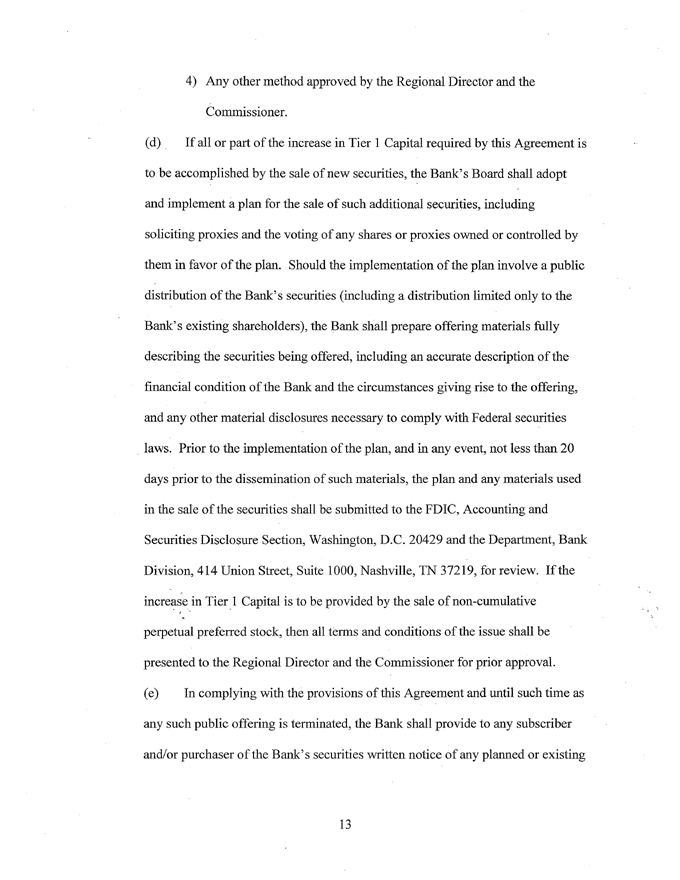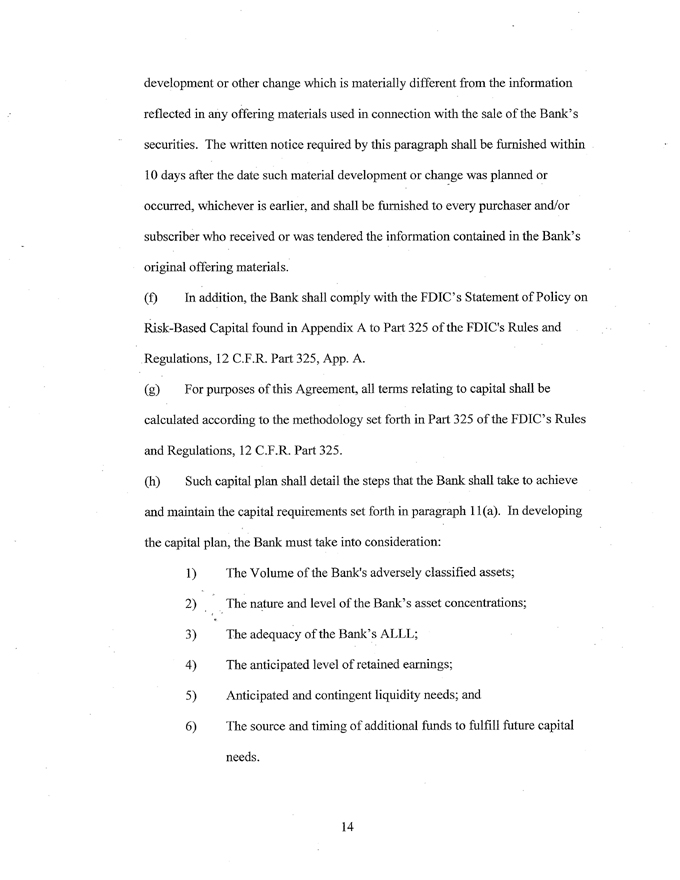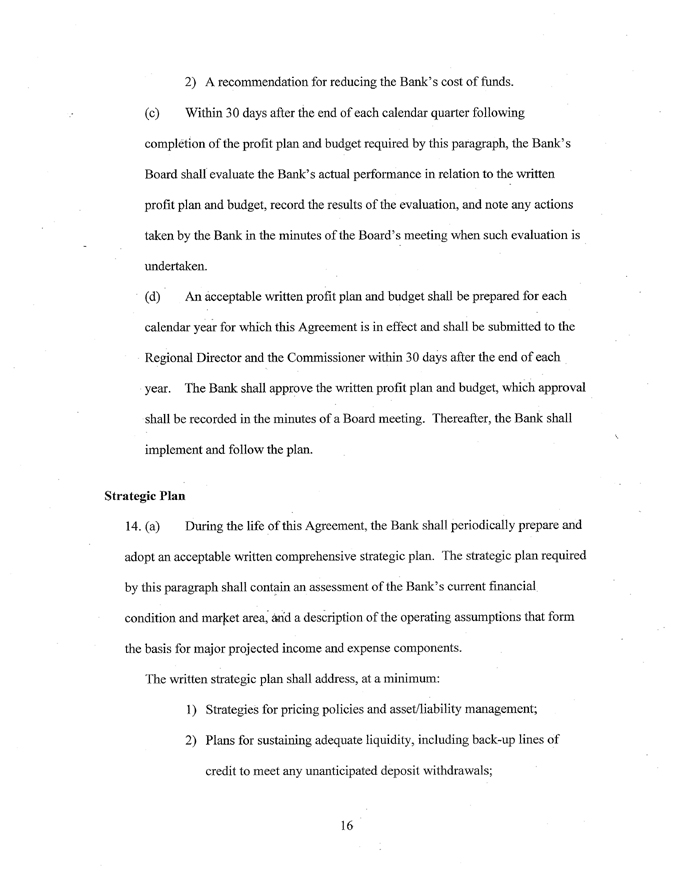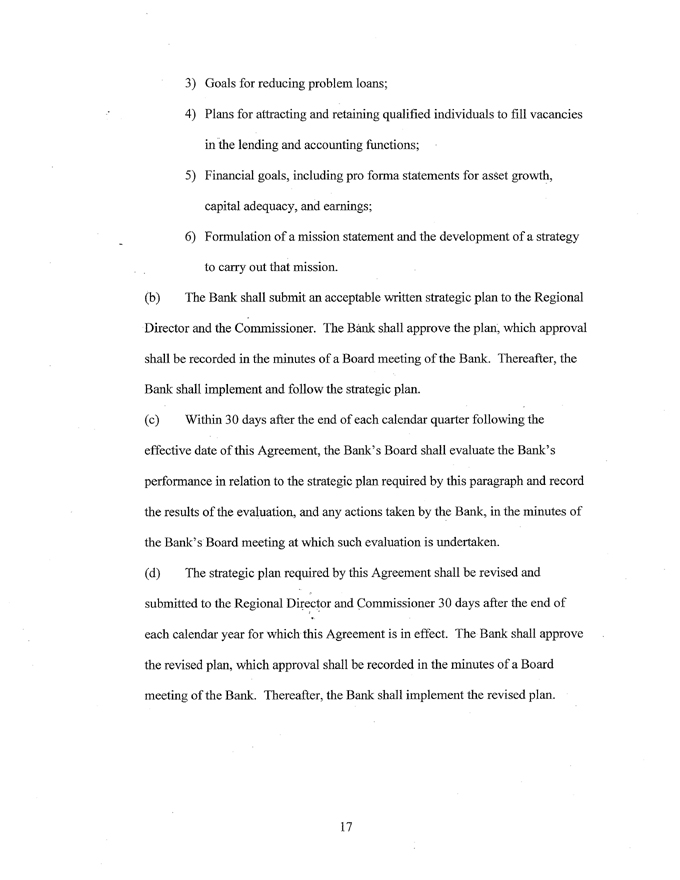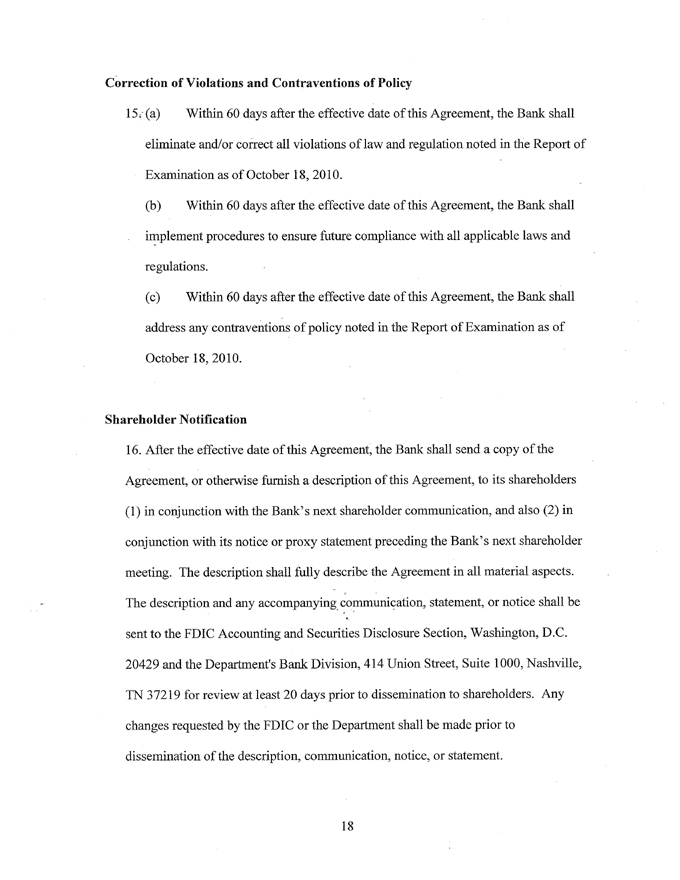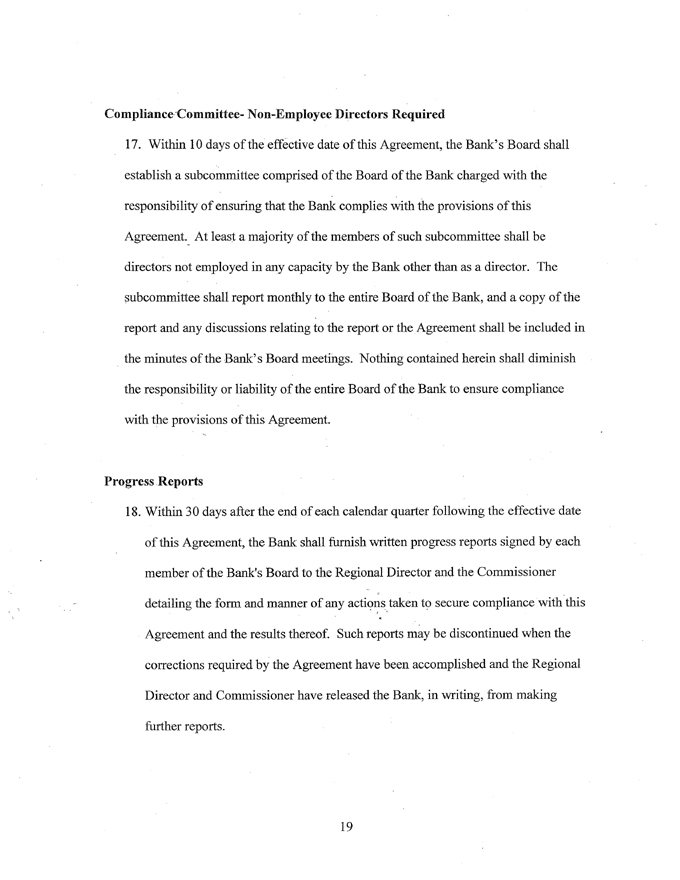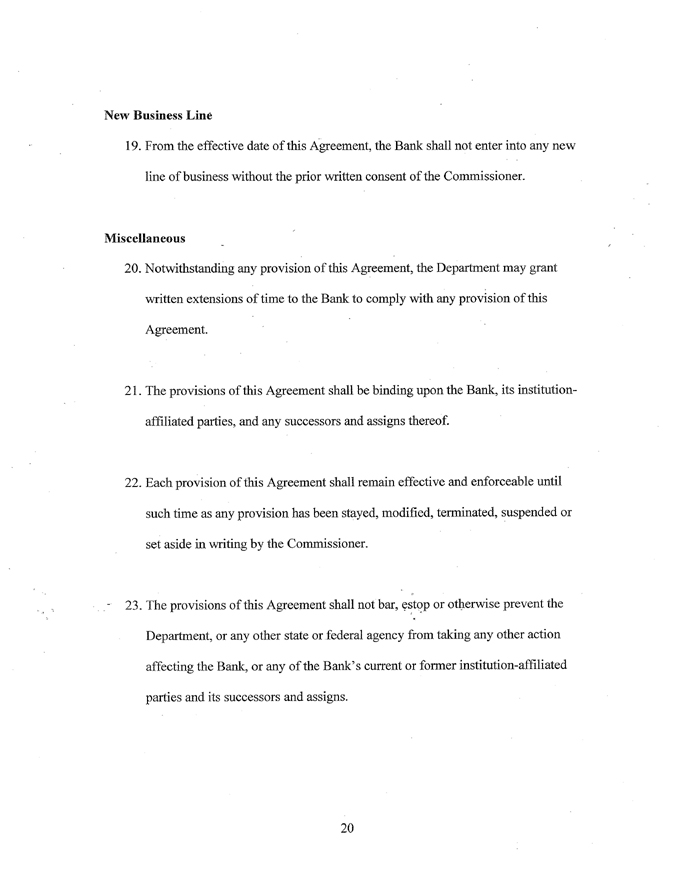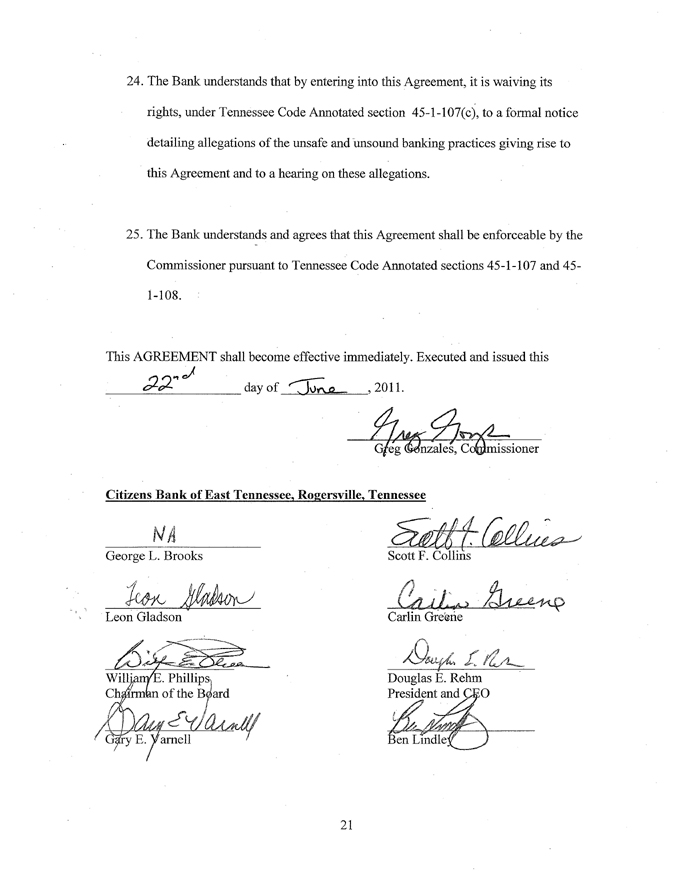10-K
UNITED STATES
SECURITIES AND EXCHANGE COMMISSION
Washington, D.C. 20549
FORM 10-K
| x |
ANNUAL REPORT UNDER SECTION 13 OR 15(d) OF THE SECURITIES EXCHANGE ACT OF 1934 |
For the fiscal year ended December 31, 2010
OR
| ¨ |
TRANSITION REPORT PURSUANT TO SECTION 13 OR 15(d) OF THE SECURITIES EXCHANGE ACT OF 1934 |
For transition period from to
Commission file number 000-22473
VOLUNTEER BANCORP, INC.
(Name of small business issuer in its charter)
(Exact Name of Registrant
as Specified in its Charter)
|
|
|
| Tennessee |
|
62-1271025 |
| (State of Incorporation) |
|
(I.R.S. Employer Identification No.) |
210 East Main Street
Rogersville, TN 37857
(Address of principal executive offices)(Zip Code)
(423) 272-2200
(Registrant’s telephone number, including area code)
Securities
registered pursuant to Section 12(b) of the Act:
|
|
|
| Title of each class |
|
Name of each exchange on which registered: |
| None |
|
None |
Securities registered pursuant to Section 12(g) of the Act: Common Stock, $0.01 Par Value
Indicate by check mark if Registrant is a well known seasoned issuer, as defined in Rule 405 of the of the Securities
Act. Yes ¨ No x
Indicate by check mark if Registrant is not required to file reports pursuant to Section 13 or Section 15(d) of the Exchange Act. Yes ¨ No x
Indicate by
check mark whether the Registrant (1) has filed all reports required to be filed by Section 13 or 15(d) of the Securities and Exchange Act of 1934 during the preceding 12 months (or for such shorter period that the Registrant was required
to file such reports), and (2) has been subject to such filing requirements for the past 90 days. Yes ¨ No x
Indicate by check whether the Registrant has submitted electronically and posted on its corporate
Website, if any, every Interactive Data File required to be submitted and posted pursuant to Rule 405 of Regulation S-T (§232.405 of this chapter) during the preceding 12 months (or for such shorter period that the Registrant was required to
submit and post such files). Yes ¨ No x
Indicate by check mark if disclosure of delinquent filers pursuant to Item 405 of Regulation S-K (229.405 of this chapter) is not contained herein,
and will not be contained, to the best of Registrant’s knowledge, in definitive proxy or information statements incorporated by reference in Part III of this Form 10-K or any amendment to this Form 10-K. x
Indicate by check mark whether the registrant is a large accelerated filer, an accelerated filer,
a non-accelerated filer or a smaller reporting company. See the definitions of “large accelerated filer”, “accelerated filer” and “smaller reporting company” in Rule 12b-2 of the Exchange Act.
|
|
|
|
|
|
|
| Large accelerated filer |
|
¨ |
|
Accelerated filer |
|
¨ |
| Non-accelerated filer |
|
¨ |
|
Smaller reporting company |
|
x |
Indicate by check mark whether the Registrant is a shell company (as defined in Rule 12b-2 of the Exchange
Act) Yes ¨ No x
The aggregate market value of the common stock held by non-affiliates of the Registrant on June 30, 2010 was $3.6 million. The market value calculation was determined using the price of last known
trade of the Registrant’s common stock as discussed further in Item 5. For purposes of this calculation, the term “affiliate” refers to all directors, executive officers and 5% shareholders of the Registrant. As of the close of
business on December 31, 2010, there were 496,277 shares of the Registrant’s common stock outstanding.
VOLUNTEER BANCORP, INC.
FORM 10-K INDEX
i
Cautionary Notice Regarding Forward-Looking Statements
We may from time to time make written or oral statements, including statements contained in this report, which may constitute forward-looking statements
within the meaning of section 27A of the Securities Act of 1933 and section 21E of the Securities Exchange Act of 1934. Certain statements contained in this annual report on Form 10-K (this “Form 10-K”) that are not statements of
historical fact such as “expect,” “estimate,” “project,” “budget,” “forecast,” “anticipate,” “intend,” “plan,” “may,” “will,” “could,”
“should,” “believes,” “predicts,” “potential,” “continue,” and similar expressions are intended to identify forward-looking statements but are not the exclusive means of identifying such statements.
Such forward-looking statements are made pursuant to “safe harbor” provisions of the Private Securities Litigation Reform Act of 1995.
Forward-looking statements involve significant risks and uncertainties that could cause the actual results to differ materially from those anticipated in such statements. Most of these factors are outside
our control and difficult to predict. These forward-looking statements include, without limitation, our expectations with respect to our future financial or business performance, strategies or expectations. Factors that may cause such differences
include, but are not limited to:
| |
• |
|
changes in general economic, market and business conditions in areas or markets where we compete; |
| |
• |
|
conditions beyond our control such as future state and federal legislation, including the Dodd Frank Act and regulations promulgated thereunder, and
regulation affecting one or more of our business segments, natural disasters or acts of war or terrorism; |
| |
• |
|
changes in the interest rate environment; |
| |
• |
|
changes in the default rate of our loans; |
| |
• |
|
changes in the securities markets, including ongoing liquidity problems related thereto; |
| |
• |
|
our ability to maintain liquidity or access other sources of funding; |
| |
• |
|
the adequacy of the allowance for loan losses; |
| |
• |
|
the loss of key personnel; |
| |
• |
|
our ability to execute its business strategy |
| |
• |
|
losses due to fraudulent and negligent acts of customers, service providers, and employees; |
| |
• |
|
consumer income levels and spending and savings habit changes; |
| |
• |
|
cost and availability of capital; |
| |
• |
|
competition from other banks and financial institutions as well as insurance companies, mortgage originators, investment banking and financial advisory
firms, asset-based non-bank lenders; |
| |
• |
|
approval of new, or changes in, accounting policies and practices; |
| |
• |
|
the ability of The Citizens Bank of East Tennessee (the “Bank”) to comply with the requirements of the Consent Order issued by the Federal
Deposit Insurance Corporation on January 28, 2010, the Written Agreement dated June 22, 2011 with the Tennessee Department of Financial Institutions, and the Written Agreement dated May 26, 2010 with the Federal Reserve Bank of Atlanta;
and/or |
| |
• |
|
other factors discussed from time to time in our news releases and/or public statements. |
We caution that the foregoing list of factors is not exclusive, and new factors may emerge or changes to the foregoing factors may occur that could
impact our business. You should review carefully the section captioned “Management’s Discussion and Analysis of Financial Condition and Results of Operations” in Item 7 of this Form 10-K for a more complete discussion of these
and other factors that may affect our business. All subsequent written and oral forward-looking statements concerning our business attributable to us or any person acting on our behalf are expressly qualified in their entirety by the cautionary
statements above. We do not undertake any obligation to update any forward-looking statement, whether written or oral, relating to the matters discussed in this Form 10-K, except to the extent required by federal securities laws.
ii
PART I
| ITEM 1. |
DESCRIPTION OF BUSINESS |
THE COMPANY
Volunteer Bancorp, Inc. (“Volunteer” or “Company”) is a registered bank holding company organized under the laws of
Tennessee, chartered in 1985. Volunteer, with consolidated total assets of approximately $132.9 million at December 31, 2010, is headquartered in Rogersville, Tennessee with offices in Church Hill and Sneedville, Tennessee, and we conduct
operations through our subsidiary, The Citizens Bank of East Tennessee (“Bank”), a state bank organized under the laws of the state of Tennessee in April 1906. We do not engage in any activities other than acting as a bank holding company
for the Bank. We believe we can present an alternative to mega banks by offering local ownership, local decision making and other personalized service characteristics of community banks. The holding company structure provides flexibility for
expansion of our banking business through acquisition of other financial institutions and provision of additional banking-related services which the traditional commercial bank may not provide under present laws.
From April 24, 1997 (the date we registered our common stock pursuant to Section 12(g) of the Securities Exchange Act of 1934 (the
“Exchange Act”)) to December 3, 2004 (the date we filed Form 15 to terminate such registration) we filed with the United States Securities and Exchange Commission (“SEC”) our periodic reports pursuant to the Exchange Act. In
December of 2004, we filed a Form 15, based on our belief that it satisfied the requirements under Rule 12g-4 to terminate the registration of the common stock, and thereby suspend our duty to file reports pursuant to the Exchange Act. In 2011,
we discovered that the filing of the Form 15 was in error; that we remained subject to the reporting requirements under the Exchange Act. In connection with such requirements, we are filing this Annual Report on Form 10-K for the fiscal year
ended December 31, 2010, and intend to file our Quarterly Report on Form 10-Q for the quarterly period ended September 30, 2011, and our Annual Report on Form 10-K for the fiscal year ended December 31, 2011, and to continue to make
timely filing of our periodic reports thereafter, as required by the Exchange Act.
SERVICES
The Bank provides a full range of retail banking services, including (i) the acceptance of demand, savings and time deposits; (ii) the making of
loans to consumers, businesses and other institutions; (iii) the investment of excess funds in the sale of federal funds, U.S. government and agency obligations, and state, county and municipal bonds; and (iv) other miscellaneous financial
services usually handled for customers by commercial banks.
MARKET AREA AND COMPETITION
We compete with other commercial banks, savings and loan associations, credit unions and finance companies operating in Hancock and Hawkins counties in
Tennessee and elsewhere. One other commercial bank is doing business in Hancock County, and in Hawkins County there are eight commercial banks and savings and loan associations. The Bank is subject to substantial competition in all aspects of its
business. Intense competition for loans and deposits comes from other financial institutions in the market area. In certain aspects of its business, the Bank also competes with credit unions, small loan companies, insurance companies, mortgage
companies, finance companies, brokerage houses and other financial institutions, some of which are not subject to the same degree of regulation and restriction as the Bank and some of which have financial resources greater than those of the Bank.
The future success of the Bank will depend primarily upon the difference between the cost of its borrowing (primarily interest paid on deposits) and income from operations (primarily interest or fees earned on loans, sales of loans and investments).
The Bank competes for funds with other institutions, which, in most cases, are significantly larger and are able to provide a greater variety of services than the Bank and thus may obtain deposits at lower rates of interest.
1
AVERAGE BALANCE SHEETS AND INTEREST RATES
The following table sets forth weighted average yields earned by Volunteer on our earning assets and the weighted average rates paid on our average deposits and other interest-bearing liabilities for the
years indicated, and certain other information:
|
|
|
|
|
|
|
|
|
|
|
|
|
|
|
|
|
|
|
|
|
|
|
|
|
| (Dollars in thousands) |
|
2010 |
|
|
2009 |
|
| |
|
Average
Balance |
|
|
Interest
Income/
Expense |
|
|
Annualized
Yield or
Rate |
|
|
Average
Balance |
|
|
Interest
Income/
Expense |
|
|
Annualized Yield
or Rate |
|
| Assets: |
|
|
|
|
|
|
|
|
|
|
|
|
|
|
|
|
|
|
|
|
|
|
|
|
| Loans, net |
|
$ |
108,877 |
|
|
$ |
5,532 |
|
|
|
4.95 |
% |
|
$ |
108,746 |
|
|
$ |
6,545 |
|
|
|
5.96 |
% |
| Securities available for sale |
|
|
13,066 |
|
|
|
631 |
|
|
|
4.83 |
% |
|
|
20,672 |
|
|
|
1,017 |
|
|
|
4.92 |
% |
| Securities held to maturity |
|
|
75 |
|
|
|
3 |
|
|
|
4.00 |
% |
|
|
115 |
|
|
|
5 |
|
|
|
4.35 |
% |
| Federal funds sold |
|
|
2,354 |
|
|
|
6 |
|
|
|
0.25 |
% |
|
|
920 |
|
|
|
2 |
|
|
|
0.22 |
% |
| Interest-bearing deposits with banks |
|
|
1,606 |
|
|
|
2 |
|
|
|
.12 |
% |
|
|
95 |
|
|
|
1 |
|
|
|
1.05 |
% |
| Federal Home Loan Bank stock |
|
|
493 |
|
|
|
22 |
|
|
|
4.46 |
% |
|
|
488 |
|
|
|
23 |
|
|
|
4.71 |
% |
| Interest earning assets net |
|
|
127,856 |
|
|
|
6,196 |
|
|
|
4.90 |
% |
|
|
132,119 |
|
|
|
7,593 |
|
|
|
5.79 |
% |
| Non-interest earning assets |
|
|
11,989 |
|
|
|
|
|
|
|
|
|
|
|
10,562 |
|
|
|
|
|
|
|
|
|
| Total assets |
|
$ |
138,460 |
|
|
|
|
|
|
|
|
|
|
$ |
141,598 |
|
|
|
|
|
|
|
|
|
| Liabilities and Stockholders’ Equity: |
|
|
|
|
|
|
|
|
|
|
|
|
|
|
|
|
|
|
|
|
|
|
|
|
| Interest-bearing deposits |
|
$ |
104,222 |
|
|
$ |
1,955 |
|
|
|
1.88 |
% |
|
$ |
105,167 |
|
|
$ |
2,602 |
|
|
|
2.47 |
% |
| Federal Home Loan Bank advances |
|
|
7,971 |
|
|
|
22 |
|
|
|
0.28 |
% |
|
|
8,081 |
|
|
|
28 |
|
|
|
0.35 |
% |
| Note payable |
|
|
831 |
|
|
|
20 |
|
|
|
2.41 |
% |
|
|
831 |
|
|
|
20 |
|
|
|
2.41 |
% |
| Subordinated debentures |
|
|
3,093 |
|
|
|
81 |
|
|
|
2.62 |
% |
|
|
3,093 |
|
|
|
119 |
|
|
|
3.85 |
% |
| Securities sold under agreements to repurchase and other |
|
|
347 |
|
|
|
8 |
|
|
|
2.31 |
% |
|
|
734 |
|
|
|
14 |
|
|
|
1.91 |
% |
| Total interest-bearing liabilities |
|
|
116,464 |
|
|
|
2,086 |
|
|
|
1.79 |
% |
|
|
117,906 |
|
|
|
2,783 |
|
|
|
2.36 |
% |
| Non-interest Bearing Liabilities: |
|
|
|
|
|
|
|
|
|
|
|
|
|
|
|
|
|
|
|
|
|
|
|
|
| Non-interest bearing deposits |
|
|
15,676 |
|
|
|
|
|
|
|
|
|
|
|
14,820 |
|
|
|
|
|
|
|
|
|
| Other liabilities |
|
|
1,217 |
|
|
|
|
|
|
|
|
|
|
|
549 |
|
|
|
|
|
|
|
|
|
| Total liabilities |
|
|
133,357 |
|
|
|
|
|
|
|
|
|
|
|
133,275 |
|
|
|
|
|
|
|
|
|
| Stockholders’ equity |
|
|
5,103 |
|
|
|
|
|
|
|
|
|
|
|
8,323 |
|
|
|
|
|
|
|
|
|
| Total liabilities and stockholders’ equity |
|
$ |
138,460 |
|
|
|
|
|
|
|
|
|
|
$ |
141,598 |
|
|
|
|
|
|
|
|
|
| Net interest income |
|
|
|
|
|
$ |
4,110 |
|
|
|
|
|
|
|
|
|
|
$ |
4,810 |
|
|
|
|
|
| Net interest margin |
|
|
|
|
|
|
|
|
|
|
3.25 |
% |
|
|
|
|
|
|
|
|
|
|
3.67 |
% |
| Net interest spread |
|
|
|
|
|
|
|
|
|
|
3.11 |
% |
|
|
|
|
|
|
|
|
|
|
3.43 |
% |
2
The following table presents a summary of changes in interest income, interest expense, and the interest
rate differential aggregated by the changes in volumes and rates:
|
|
|
|
|
|
|
|
|
|
|
|
|
| (Dollars in thousands) |
|
December 31, 2010 Versus December 31, 2009
Increases (decreases) Change Due To: (1) |
|
| |
|
Volume |
|
|
Rate |
|
|
Total |
|
| Loans net of unearned income |
|
$ |
(29 |
) |
|
$ |
(984 |
) |
|
$ |
(1,013 |
) |
| U.S. Treasury |
|
|
(2 |
) |
|
|
(59 |
) |
|
|
(61 |
) |
| Government agencies |
|
|
(9 |
) |
|
|
(304 |
) |
|
|
(313 |
) |
| States and municipalities |
|
|
(1 |
) |
|
|
(14 |
) |
|
|
(15 |
) |
| Federal Home Loan Bank stock |
|
|
— |
|
|
|
(1 |
) |
|
|
(1 |
) |
| Federal funds sold |
|
|
— |
|
|
|
5 |
|
|
|
5 |
|
|
|
|
|
|
|
|
|
|
|
|
|
|
| Total interest income |
|
|
(41 |
) |
|
|
(1,357 |
) |
|
|
(1,398 |
) |
| Increase (decrease) in: |
|
|
|
|
|
|
|
|
|
|
|
|
| Demand deposits |
|
|
— |
|
|
|
(103 |
) |
|
|
(103 |
) |
| Savings |
|
|
— |
|
|
|
3 |
|
|
|
3 |
|
| Time certificates |
|
|
(7 |
) |
|
|
(540 |
) |
|
|
(547 |
) |
| Federal Home Loan Bank advances |
|
|
— |
|
|
|
(6 |
) |
|
|
(6 |
) |
| Federal funds purchased |
|
|
— |
|
|
|
(4 |
) |
|
|
(4 |
) |
| Securities sold under repurchase |
|
|
— |
|
|
|
(2 |
) |
|
|
(2 |
) |
| Note payable |
|
|
— |
|
|
|
(38 |
) |
|
|
(38 |
) |
|
|
|
|
|
|
|
|
|
|
|
|
|
| Total interest expense |
|
|
(7 |
) |
|
|
(690 |
) |
|
|
(697 |
) |
| Increase (decrease) in net interest income |
|
$ |
(34 |
) |
|
$ |
(667 |
) |
|
$ |
(701 |
) |
|
|
|
|
|
|
|
|
|
|
|
|
|
| (1) |
Increases (decreases) are attributable to volume changes and rate changes on the following basis: Volume Change equals change in volume times prior year rate. Rate
Change equals change in rate times prior year volume. The Rate/Volume Change equals the change in volume times the change in rate, and it is allocated between Volume Change and Rate Change at the ratio that the absolute value of each of these
components bears to the absolute value of their total. |
| |
For purposes of this schedule, non-accruing loans are included in the average balances and tax exempt income is reflected on a tax equivalent basis. Since we have
recorded a full valuation allowance on our deferred tax assets, the yield and tax equivalent yield are the same. Loan fees included in interest income are not material to the presentation. |
3
LIABILITY AND ASSET MANAGEMENT
The Bank’s Funds Management Committee actively measures and manages interest rate risk using a process developed by the Company. The committee is also responsible for implementing our
asset/liability management policies, overseeing the formulation and implementation of strategies to improve balance sheet positioning and earnings, and reviewing our interest rate sensitivity position.
The primary tool that management uses to measure short-term interest rate risk is a net interest income simulation model prepared by an independent
correspondent institution. These simulations estimate the impact that various changes in the overall level of interest rates over one and two-year time horizons would have on net interest income. The results help us develop strategies for
managing exposures to interest rate risk.
Like any forecasting technique, interest rate simulation modeling is based on a large number of
assumptions. In this case, the assumptions relate primarily to loan and deposit growth, asset and liability prepayments, interest rates and balance sheet management strategies. We believe that both individually and in the aggregate the
assumptions are reasonable. Nevertheless, the simulation modeling process produces only a sophisticated estimate, not a precise calculation of exposure.
At December 31, 2010, approximately 74% of our gross loans had fixed rates. Based on the asset/liability modeling we believe that these loans reprice at a slower pace than our
liabilities. Because the majority of our liabilities mature in 12 months and under and the gap in repricing is liability sensitive, with liabilities repricing more frequently, we believe that a rising rate environment will have a negative
impact on our net interest margin.
4
DEPOSITS
Our primary source of funds is interest-bearing deposits. The following table sets forth our deposit structure at December 31, 2010 and 2009.
|
|
|
|
|
|
|
|
|
| |
|
December 31, |
|
| |
|
2010 |
|
|
2009 |
|
| |
|
(Dollars in thousands) |
|
| Non interest-bearing deposits: |
|
|
|
|
|
|
|
|
| Individuals, partnerships and corporations |
|
$ |
14,031 |
|
|
$ |
15,476 |
|
| U.S. Government and states and political subdivisions |
|
|
234 |
|
|
|
114 |
|
| Commercial banks and other depository institutions |
|
|
0 |
|
|
|
0 |
|
| Certified and official checks |
|
|
131 |
|
|
|
423 |
|
|
|
|
|
|
|
|
|
|
| Total non-interest bearing deposits |
|
$ |
14,396 |
|
|
$ |
16,013 |
|
|
|
|
|
|
|
|
|
|
| Interest-bearing deposits: |
|
|
|
|
|
|
|
|
| Interest-bearing demand accounts |
|
$ |
19,080 |
|
|
$ |
17,087 |
|
| Savings accounts |
|
|
5,892 |
|
|
|
5,875 |
|
| Certificates of deposit, less than $100,000 |
|
|
45,634 |
|
|
|
47,549 |
|
| Certificates of deposit, greater than $100,000 |
|
|
31,429 |
|
|
|
34,271 |
|
|
|
|
|
|
|
|
|
|
| Total interest-bearing deposits* |
|
$ |
102,035 |
|
|
$ |
104,782 |
|
|
|
|
|
|
|
|
|
|
| Total deposits |
|
$ |
116,431 |
|
|
$ |
120,795 |
|
|
|
|
|
|
|
|
|
|
* Interest Bearing Deposits include $10,754 in Individual Retirement Accounts for 2010 and $11,214 in 2009.
The table below presents the Bank’s average balances of deposits and the average rates paid on those deposits for the years ended
December 31, 2010 and 2009.
|
|
|
|
|
|
|
|
|
|
|
|
|
|
|
|
|
| |
|
2010 |
|
|
2009 |
|
| (Dollars in thousands) |
|
Average
Balance |
|
|
Weighted
Average
Rate |
|
|
Average
Balance |
|
|
Weighted
Average
Rate |
|
| Noninterest-bearing demand deposits |
|
$ |
15,676 |
|
|
|
— |
|
|
$ |
14,820 |
|
|
|
— |
|
| Interest-bearing demand deposits |
|
|
18,858 |
|
|
|
.22 |
% |
|
|
21,729 |
|
|
|
.30 |
% |
| Savings |
|
|
5,809 |
|
|
|
.45 |
% |
|
|
5,581 |
|
|
|
.44 |
% |
| Certificates of deposit |
|
|
79,555 |
|
|
|
1.91 |
% |
|
|
77,857 |
|
|
|
2.66 |
% |
|
|
|
|
|
|
|
|
|
|
|
|
|
|
|
|
|
| Total deposits |
|
$ |
119,898 |
|
|
|
|
|
|
$ |
119,987 |
|
|
|
|
|
|
|
|
|
|
|
|
|
|
|
|
|
|
|
|
|
|
5
At December 31, 2010, time deposits greater than $100,000 totaled approximately $31.4 million. The
following table indicates, as of December 31, 2010, the dollar amount of $100,000 or more deposits by time remaining until maturity:
|
|
|
|
|
| |
|
(Dollars in thousands) |
|
| Months to maturity: |
|
|
|
|
| Three months or less |
|
$ |
8,779 |
|
| Three months to six months |
|
|
6,179 |
|
| Six to twelve months |
|
|
9,711 |
|
| Over twelve months |
|
|
6,760 |
|
|
|
|
|
|
| Total time deposits of $100,000 or more |
|
$ |
31,429 |
|
|
|
|
|
|
SHORT-TERM BORROWINGS
Short-term borrowings are primarily comprised of borrowings with the Federal Home Loan Bank of Cincinnati (“FHLB”). Other short-term borrowings within the Company are insignificant.
The balances at year-end are shown:
|
|
|
|
|
| (Dollars in thousands) |
|
FHLB
Borrowings |
|
| Outstanding at December 31, 2010 |
|
$ |
8,500 |
|
| Average interest rate at year-end |
|
|
.20 |
% |
| Average balance during year |
|
$ |
7,971 |
|
| Average interest rate during year |
|
|
.28 |
% |
| Maximum month end balance during year |
|
$ |
8,700 |
|
| Outstanding at December 31, 2009 |
|
$ |
8,700 |
|
| Average interest rate at year-end |
|
|
.18 |
% |
| Average balance during year |
|
$ |
8,081 |
|
| Average interest rate during year |
|
|
.35 |
% |
| Maximum month end balance during year |
|
$ |
8,700 |
|
6
ASSETS
Our management considers many criteria in managing assets, including creditworthiness, diversification and structural characteristics, maturity and interest rate sensitivity. The following table sets
forth our interest earning assets by category at December 31, 2010 and 2009.
|
|
|
|
|
|
|
|
|
| |
|
December 31, |
|
| (Dollars in thousands) |
|
2010 |
|
|
2009 |
|
| Investment securities: |
|
|
|
|
|
|
|
|
| Available for sale |
|
|
|
|
|
|
|
|
| U.S. Government sponsored entities and agencies |
|
$ |
614 |
|
|
$ |
566 |
|
| States and political subdivisions |
|
|
5,236 |
|
|
|
5,134 |
|
| Mortgage-backed residential & collateralized mortgage obligations |
|
|
6,834 |
|
|
|
8,889 |
|
|
|
|
|
|
|
|
|
|
| Total available for sale |
|
|
12,684 |
|
|
|
14,589 |
|
| Held to maturity |
|
|
56 |
|
|
|
93 |
|
| FHLB stock |
|
|
494 |
|
|
|
491 |
|
| Federal funds sold |
|
|
890 |
|
|
|
3,145 |
|
| Loans: |
|
|
|
|
|
|
|
|
| Real estate |
|
|
96,707 |
|
|
|
106,845 |
|
| Commercial |
|
|
4,893 |
|
|
|
4,550 |
|
| Consumer and other |
|
|
3,830 |
|
|
|
4,176 |
|
|
|
|
|
|
|
|
|
|
| Total loans |
|
|
105,430 |
|
|
|
115,571 |
|
| Interest bearing—due from correspondent banks |
|
|
2,585 |
|
|
|
144 |
|
|
|
|
|
|
|
|
|
|
| Total Interest Earning Assets |
|
$ |
122,139 |
|
|
$ |
134,033 |
|
|
|
|
|
|
|
|
|
|
7
INVESTMENT PORTFOLIO
At year end 2010, obligations of the United States Government or its agencies and obligations of states and political subdivisions represented 100.00% of the investment portfolio.
The securities portfolio consists of two major components, securities held-to-maturity and securities available-for-sale. Securities are classified as
held-to-maturity based on the intent and ability of our management, at the time of purchase, to hold such securities to maturity. These securities are carried at amortized cost. Securities that may be sold in response to changes in market interest
rates, changes in securities’ prepayment risk, increases in loan demand, general liquidity needs, and other similar factors are classified as available-for-sale and are carried at estimated fair value. The table below summarizes our securities
portfolio.
|
|
|
|
|
|
|
|
|
| |
|
(Dollars in thousands) |
|
| |
|
2010 |
|
|
2009 |
|
| Securities available-for-sale, at fair value |
|
|
|
|
|
|
|
|
| U.S. government sponsored entities and agencies |
|
$ |
614 |
|
|
$ |
566 |
|
| Mortgage-backed: residential |
|
|
4,637 |
|
|
|
6,526 |
|
| State and political subdivisions |
|
|
5,236 |
|
|
|
5,134 |
|
| Collateralized mortgage obligations |
|
|
2,197 |
|
|
|
2,363 |
|
|
|
|
|
|
|
|
|
|
| Total securities available-for-sale |
|
|
12,684 |
|
|
|
14,589 |
|
| Securities held-to-maturity at amortized cost |
|
|
|
|
|
|
|
|
| Mortgage-backed: residential |
|
|
56 |
|
|
|
93 |
|
|
|
|
|
|
|
|
|
|
| Total securities portfolio |
|
$ |
12,740 |
|
|
$ |
14,682 |
|
|
|
|
|
|
|
|
|
|
The following table presents the maturity distribution of Volunteer’s debt securities at December 31, 2010. The
weighted average yields on these instruments are presented based on final maturity. Yields on states and political subdivisions have been adjusted to a fully-taxable equivalent basis. Since we have recorded a full valuation allowance on our deferred
tax assets, the yield and tax equivalent yield are the same.
8
|
|
|
|
|
|
|
|
|
|
|
|
|
|
|
|
|
|
|
|
|
| |
|
December 31, 2010 |
|
| (Dollars in thousands) |
|
One Year
or Less |
|
|
One Year to
Five Years |
|
|
Five Years to
Ten Years |
|
|
Greater
Than Ten
Years |
|
|
Total |
|
| Available-for-sale, at fair value |
|
|
|
|
|
|
|
|
|
|
|
|
|
|
|
|
|
|
|
|
| U. S. government sponsored entities and agencies |
|
|
— |
|
|
|
— |
|
|
|
550 |
|
|
|
64 |
|
|
|
614 |
|
| Weighted average yield |
|
|
|
|
|
|
|
|
|
|
3.00 |
% |
|
|
1.52 |
% |
|
|
3.00 |
% |
|
|
|
|
|
|
| Mortgage-backed: residential and collateralized mortgage obligations |
|
|
— |
|
|
|
241 |
|
|
|
1,336 |
|
|
|
5,257 |
|
|
|
6,834 |
|
| Weighted average yield |
|
|
|
|
|
|
4.37 |
% |
|
|
4.98 |
% |
|
|
5.07 |
% |
|
|
5.03 |
% |
|
|
|
|
|
|
| State and political subdivisions |
|
|
— |
|
|
|
3,099 |
|
|
|
360 |
|
|
|
1,777 |
|
|
|
5,236 |
|
| Weighted average yield |
|
|
|
|
|
|
6.29 |
% |
|
|
5.70 |
% |
|
|
6.35 |
% |
|
|
6.23 |
% |
|
|
|
|
|
|
|
|
|
|
|
|
|
|
|
|
|
|
|
|
|
|
|
|
|
|
|
| Total available-for-sale |
|
|
— |
|
|
$ |
3,340 |
|
|
$ |
2,246 |
|
|
$ |
7,098 |
|
|
$ |
12,684 |
|
|
|
|
|
|
|
|
|
|
|
|
|
|
|
|
|
|
|
|
|
|
| Weighted average yield |
|
|
|
|
|
|
6.12 |
% |
|
|
4.70 |
% |
|
|
5.41 |
% |
|
|
5.44 |
% |
|
|
|
|
|
|
| Held-to-maturity, at amortized cost |
|
|
|
|
|
|
|
|
|
|
|
|
|
|
|
|
|
|
|
|
| Mortgage-backed: residential |
|
$ |
0 |
|
|
$ |
53 |
|
|
$ |
3 |
|
|
$ |
0 |
|
|
$ |
56 |
|
| Weighted average yield |
|
|
|
|
|
|
4.47 |
% |
|
|
3.38 |
% |
|
|
|
|
|
|
4.40 |
% |
9
INVESTMENT POLICY
The objective of our investment policy is to invest funds not otherwise needed to meet the loan demand of our market area to earn the maximum return, yet still maintain sufficient liquidity to meet
fluctuations in our loan demand and deposit structure. In doing so, we balance the market and credit risks against the potential investment return, make investments compatible with the pledge requirements of our deposits of public funds, maintain
compliance with regulatory investment requirements, and assist the various public entities with their financing needs. The Chief Executive Officer is authorized to execute security transactions for the investment portfolio based on the decisions of
the Funds Management Committee. The Funds Management Committee, which consists of the President and Chief Executive Officer, the Chief Financial Officer, and various outside Directors, has full authority over the investment portfolio and makes
decisions on purchases and sales of securities. All the investment transactions occurring since the previous Board of Directors’ meeting are reviewed by the board at its next monthly meeting, and the entire portfolio is reviewed on a
semi-annual basis. The investment policy allows portfolio holdings to include short-term securities purchased to provide Volunteer needed liquidity and longer term securities purchased to generate level income for us over periods of interest rate
fluctuations.
Our investment securities portfolio of $12,740,039 at December 31, 2010, consisted of $55,933 of securities held to
maturity, which are carried at amortized cost and $12,684,106 of securities available for sale which are carried at fair value. In addition, unrealized gains on investment securities available for sale were $452,590 and unrealized losses were
$34,199. Our investment securities portfolio of $14,681,073 at December 31, 2009, consisted of $92,528 of securities held to maturity, which are carried at amortized cost and $14,588,545 of securities available for sale which are carried at
fair value. In addition, unrealized gains on investment securities available for sale were $633,889 and unrealized losses were $22,743.
As
reflected in Note 3 to Consolidated Financial Statements, the investment securities held to maturity had unrealized gains of $2,953 at December 31, 2010, compared to $2,834 unrealized gains at December 31, 2009.
LOAN PORTFOLIO
Total loans of $105,430,000 at
December 31, 2010, reflected a decrease of $10,141,000 compared to total loans for the year ended December 31, 2009. Residential real estate loans, which historically generated low losses, decreased $2,946,000 or 5.39%. Construction and
land development loans, loans secured by farmland and commercial real estate loans decreased by $7,193,000 or 13.77%. Commercial and industrial loans increased by $343,000 or 7.54%. These types of loans carry a higher level of risk in that the
borrowers’ ability to repay may be affected by local economic trends. Installment and other consumer loans decreased by $346,000 or 8.29%. These loans, generally secured by automobiles and other consumer goods, contain a historically higher
level of risk; however, this risk is mitigated by the fact that these loans generally consist of small individual balances. As the loan portfolio is concentrated in Hawkins and surrounding counties, there is a risk that the borrowers’ ability
to repay the loans could be affected by changes in local economic conditions.
The following table sets forth the composition of our loan
portfolio as December 31, 2010 and 2009.
|
|
|
|
|
|
|
|
|
| |
|
(Dollars in thousands) |
|
| |
|
December 31, |
|
| |
|
2010 |
|
|
2009 |
|
| Real estate loans: |
|
|
|
|
|
|
|
|
| Construction and land development |
|
$ |
11,987 |
|
|
$ |
23,483 |
|
| Commercial real estate loans |
|
|
29,640 |
|
|
|
26,448 |
|
| Secured by residential properties |
|
|
51,674 |
|
|
|
54,620 |
|
| Other Real Estate |
|
|
3,406 |
|
|
|
2,294 |
|
|
|
|
|
|
|
|
|
|
| Total real estate loans |
|
|
96,707 |
|
|
|
106,845 |
|
|
|
|
| Commercial and industrial loans |
|
|
4,893 |
|
|
|
4,550 |
|
| Consumer Loans |
|
|
3,830 |
|
|
|
4,176 |
|
|
|
|
|
|
|
|
|
|
| Total loans |
|
$ |
105,430 |
|
|
$ |
115,571 |
|
|
|
|
|
|
|
|
|
|
10
The following table sets forth the maturities of the loan portfolio at December 31, 2010:
|
|
|
|
|
|
|
|
|
|
|
|
|
|
|
|
|
| (Dollars in thousands) |
|
One Year
or Less |
|
|
One Year to
Five Years |
|
|
Over Five
Years |
|
|
Total |
|
| Construction and Development |
|
$ |
7,697 |
|
|
$ |
3,304 |
|
|
$ |
986 |
|
|
$ |
11,987 |
|
| Commercial real estate |
|
|
6,427 |
|
|
|
9,256 |
|
|
|
13,957 |
|
|
|
29,640 |
|
| Residential real estate |
|
|
7,538 |
|
|
|
4,321 |
|
|
|
39,815 |
|
|
|
51,674 |
|
| Other Real Estate |
|
|
687 |
|
|
|
987 |
|
|
|
1,732 |
|
|
|
3.406 |
|
| Commercial |
|
|
1,813 |
|
|
|
1,262 |
|
|
|
1.818 |
|
|
|
4,893 |
|
| Consumer |
|
|
2,077 |
|
|
|
1,753 |
|
|
|
— |
|
|
|
3.830 |
|
|
|
|
|
|
|
|
|
|
|
|
|
|
|
|
|
|
| Total loans |
|
$ |
26,239 |
|
|
$ |
20,883 |
|
|
$ |
58,308 |
|
|
$ |
105,430 |
|
|
|
|
|
|
|
|
|
|
|
|
|
|
|
|
|
|
The sensitivity to interest rate changes of that portion of Volunteer’s loan portfolio that matures after one year
is set forth below:
|
|
|
|
|
|
|
|
|
| (Dollars in thousands) |
|
Fixed
Rate |
|
|
Variable
Rate |
|
| Construction and development |
|
$ |
4,163 |
|
|
$ |
126 |
|
| Commercial real estate |
|
|
20,971 |
|
|
|
2,246 |
|
| Residential real estate |
|
|
43,110 |
|
|
|
1,024 |
|
| Other Real Estate |
|
|
1,862 |
|
|
|
856 |
|
| Commercial |
|
|
3,080 |
|
|
|
— |
|
| Consumer |
|
|
1,753 |
|
|
|
— |
|
|
|
|
|
|
|
|
|
|
| Total loans maturing after one year |
|
$ |
74,939 |
|
|
$ |
4,252 |
|
|
|
|
|
|
|
|
|
|
LOAN POLICY
Lending activities are under the direct supervision and control of the Executive Vice President and the Board loan committee, which consists of eight
directors. The loan committee enforces loan authorizations for each officer, decides on loans exceeding such limits, services all requests for officer credits to the extent allowable under current laws and regulations, administers all problem
credits, and determines the allocation of funds for each lending division. The loan portfolio consists primarily of real estate, commercial, farming and installment loans. Commercial loans consist of either real estate loans or term loans. Maturity
of term loans is normally limited to five to seven years. Conventional real estate loans may be made up to 90% of the appraised value or purchase cost of the real estate for no more than a thirty-year term. Installment loans are based on the earning
capacity and vocational stability of the borrower.
The Board of Directors at its regularly scheduled meetings reviews all new loans in excess
of $100,000 made the preceding month. Loans that are 30 days or more past due are reviewed monthly.
Management periodically reviews the loan
portfolio, particularly nonaccrual and renegotiated loans. The review may result in a determination that a loan should be placed on a nonaccrual status for income recognition. In addition, to the extent that management identifies potential losses in
the loan portfolio, it reduces the book value of such loans, through charge-offs, to their estimated collectible value. Our policy is to classify as nonaccrual any loan on which payment of principal or interest is 90 days or more past due except
where there is adequate collateral to cover principal and accrued interest and the loan is in the process of collection. No concessions are granted and late fees are collected. In addition, a loan will be classified as nonaccrual if, in the opinion
of our management, based upon a review of the borrower’s or guarantor’s financial condition, collateral value or other factors, payment is questionable, even though payments are not 90 days or more past due.
11
When a loan is classified as nonaccrual, any unpaid interest is reversed against current income. Interest is
included in income thereafter only to the extent received in cash. The loan remains in a nonaccrual classification until such time as the loan is brought current, when it may be returned to accrual classification. When principal or interest on a
nonaccrual loan is brought current, if in management’s opinion future payments are questionable, the loan would remain classified as nonaccrual. After a nonaccrual or renegotiated loan is charged off, any subsequent payments of either interest
or principal are applied first to any remaining balance outstanding, then to recoveries and lastly to income.
The large number of consumer
installment loans and the relatively small dollar amount of each makes an individual review impracticable. It is our policy to charge off any consumer installment loan which is past due 90 days or more.
In addition, mortgage loans secured by real estate may be placed on nonaccrual status when the mortgagor is in bankruptcy or foreclosure proceedings are
instituted. Any accrued interest receivable remains an obligation of the borrower, except in those cases where the loan to value ratio is more than adequate to recover accrued principal and interest.
Our underwriting guidelines are applied to four major categories of loans; commercial and industrial, consumer, agricultural and real estate which
include residential, construction and development and certain other real estate loans. We require our loan officers and loan committee to consider the borrower’s character, the borrower’s financial condition as reflected in current
financial statements, the borrower’s management capability, the borrower’s industry and the economic environment in which the loan will be repaid. Before approving a loan, the loan officer or committee must determine that the borrower is
basically creditworthy, determine that the borrower is a capable manager, understand the specific purpose of the loan, understand the source and plan of repayment, determine that the purpose, plan and source of repayment as well as collateral are
acceptable, reasonable and practical given the normal framework within which the borrower operates.
CREDIT RISK MANAGEMENT AND ALLOWANCE FOR
LOAN LOSSES
Credit risk and exposure to loss are inherent parts of the banking business. Management seeks to manage and minimize these risks
through its loan and investment policies and loan review procedures. Management establishes and continually reviews lending and investment criteria and approval procedures that it believes reflect the risk sensitive nature of Volunteer. The loan
review procedures are set to monitor adherence to the established criteria and to ensure that on a continuing basis such standards are enforced and maintained.
Management’s objective in establishing lending and investment standards is to manage the risk of loss and provide for income generation through pricing policies. To effectuate this policy, we make
commercial real estate and farming loans with one year or less fixed maturity.
12
The loan portfolio is regularly reviewed and management determines the amount of loans to be charged off. In
addition, such factors as our previous loan loss experience, prevailing and anticipated economic conditions, industry concentrations and the overall quality of the loan portfolio are considered. While management uses available information to
recognize losses on loans and real estate owned, future additions to the allowance may be necessary based on changes in economic conditions. In addition, various regulatory agencies, as an integral part of their examination process, periodically
review the allowance for losses on loans and real estate owned. Such agencies may require us to recognize additions to the allowance based on their judgments about information available at the time of their examinations. In addition, any loan or
portion thereof which is classified as a “loss” by regulatory examiners is charged off.
The allowance for loan losses is a
valuation allowance for probable incurred credit losses, increased by the provision for loan losses and decreased by charge-offs less recoveries. Management estimates the allowance balance required using past loan loss experience, the nature and
volume of the portfolio, information about specific borrower situations and estimated collateral values, economic conditions, and other factors. Allocations of the allowance may be made for specific loans, but the entire allowance is available for
any loan that, in management’s judgment, should be charged off. Loan losses are charged against the allowance when management believes the uncollectibility of a loan balance is confirmed.
A loan is impaired when, based on current information and events, it is probable that we will be unable to collect all amounts due according to the
contractual terms of the loan agreement. Loans for which the terms have been modified and for which the borrower is experiencing financial difficulties, are considered troubled debt restructurings and classified as impaired.
Factors considered by management in determining impairment include payment status, collateral value, and the probability of collecting scheduled
principal and interest payments when due. Loans that experience insignificant payment delays and payment shortfalls generally are not classified as impaired. Management determines the significance of payment delays and payment shortfalls on
case-by-case basis, taking into consideration all of the circumstances surrounding the loan and the borrower, including the length of the delay, the reasons for the delay, the borrower’s prior payment record, and the amount of the shortfall in
relation to the principal and interest owed.
The general component of the allowance for loan losses, meaning that portion of the allowance
that is not reserved for a specific customer loan, covers non-impaired loans and is based on historical loss experience adjusted for current factors. The historical loss experience is determined by portfolio segment and is based on the actual loss
history experienced by the Company over the most recent 3 years. This actual loss experience is supplemented with other economic factors based on the risks present for each portfolio segment. These economic factors include consideration of the
following: levels of and trends in delinquencies and impaired loans; levels of and trends in charge-offs and recoveries; trends in volume and terms of loans; effects of any changes in risk selection and underwriting standards; other changes in
lending policies, procedures, and practices; experience, ability, and depth of lending management and other relevant staff; national and local economic trends and conditions; industry conditions; and effects of changes in credit concentrations.
The allowance for loan losses was $3,723,339 at December 31, 2010, or 3.53% of loans outstanding, net of unearned income, compared to
$3,032,107 or 2.62% at December 31, 2009.
For additional information, see Note 1 to Notes to Consolidated Financial Statements.
13
ALLOWANCE FOR LOAN LOSSES
The following table presents the activity in our allowance for loan losses for the dates indicated.
|
|
|
|
|
|
|
|
|
| (Dollars in thousands) |
|
2010 |
|
|
2009 |
|
| Balance at beginning of period |
|
$ |
3,032 |
|
|
$ |
984 |
|
| Provisions charged to operating expenses |
|
|
2,656 |
|
|
|
2,533 |
|
| Recoveries of loans previously charged off |
|
|
|
|
|
|
|
|
| Construction and development |
|
|
— |
|
|
|
1 |
|
| Commercial real estate |
|
|
35 |
|
|
|
10 |
|
| Residential real estate |
|
|
— |
|
|
|
— |
|
| Commercial |
|
|
5 |
|
|
|
3 |
|
| Consumer |
|
|
15 |
|
|
|
8 |
|
| Other |
|
|
— |
|
|
|
— |
|
|
|
|
|
|
|
|
|
|
| Total recoveries |
|
|
55 |
|
|
|
22 |
|
|
|
|
| Loans charged off |
|
|
|
|
|
|
|
|
| Construction and development |
|
|
1,275 |
|
|
|
219 |
|
| Commercial real estate |
|
|
69 |
|
|
|
188 |
|
| Residential real estate |
|
|
— |
|
|
|
1 |
|
| Commercial |
|
|
570 |
|
|
|
57 |
|
| Consumer |
|
|
52 |
|
|
|
42 |
|
| Other |
|
|
54 |
|
|
|
— |
|
|
|
|
|
|
|
|
|
|
| Total charged off loans |
|
|
2,020 |
|
|
|
507 |
|
|
|
|
|
|
|
|
|
|
|
|
|
| Net charged off loans |
|
|
1,965 |
|
|
|
485 |
|
|
|
|
|
|
|
|
|
|
| Balance at the end of the period |
|
$ |
3,723 |
|
|
$ |
3,032 |
|
|
|
|
|
|
|
|
|
|
|
|
|
| Net charged off loans to average loans outstanding |
|
|
1.76 |
% |
|
|
.44 |
% |
| Allowance to nonperforming loans |
|
|
30.45 |
% |
|
|
23.23 |
% |
14
At December 31, 2010 and 2009, the allowance for loan losses was allocated as follows:
|
|
|
|
|
|
|
|
|
|
|
|
|
|
|
|
|
| |
|
December 31, 2010 |
|
|
December 31, 2009 |
|
| (Dollars in thousands) |
|
Amount |
|
|
Percent of loans in each
category to
total
loans |
|
|
Amount |
|
|
Percent of loans in each
category
to total
loans |
|
| Construction and development |
|
$ |
753 |
|
|
|
11.37 |
% |
|
$ |
1,374 |
|
|
|
20.32 |
% |
| Commercial real estate |
|
|
2,251 |
|
|
|
28.11 |
% |
|
|
675 |
|
|
|
22.88 |
% |
| Residential real estate |
|
|
310 |
|
|
|
49.01 |
% |
|
|
586 |
|
|
|
47.26 |
% |
| Commercial |
|
|
270 |
|
|
|
4.64 |
% |
|
|
304 |
|
|
|
1.99 |
% |
| Consumer |
|
|
12 |
|
|
|
3.63 |
% |
|
|
10 |
|
|
|
3.94 |
% |
| Other real estate |
|
|
127 |
|
|
|
3.23 |
% |
|
|
83 |
|
|
|
1.99 |
% |
|
|
|
|
|
|
|
|
|
|
|
|
|
|
|
|
|
| Total |
|
$ |
3,723 |
|
|
|
100 |
% |
|
$ |
3,032 |
|
|
|
100 |
% |
|
|
|
|
|
|
|
|
|
|
|
|
|
|
|
|
|
The allocation of the allowance is presented based in part on evaluations of past history and composition of the loan
portfolio. Since these factors are subject to change, the current allocation of the allowance is not necessarily indicative of the breakdown of future losses.
15
The following table sets forth information with respect to nonperforming loans of Volunteer for the dates
indicated. Accrual of interest is discontinued when there is reasonable doubt as to the full, timely collections of interest or principal. When a loan becomes contractually past due 90 days with respect to interest or principal, it is reviewed and a
determination is made as to whether it should be placed on nonaccrual status. When a loan is placed on nonaccrual status, all interest previously accrued but not collected is reversed against current period interest income. Income on such loans is
then recognized only to the extent that cash is received and where the future collection of principal is probable. Interest accruals are resumed on such loans only when they are brought fully current with respect to principal and interest and when,
in the judgment of management, the loans are estimated to be fully collectible as to principal and interest. Restructured loans are those loans on which concessions in terms have been granted because of a borrower’s financial difficulty.
Interest is generally accrued on such loans in accordance with the new terms.
|
|
|
|
|
|
|
|
|
| (Dollars in thousands) |
|
2010 |
|
|
2009 |
|
| Nonaccrual loans |
|
$ |
12,197 |
|
|
$ |
11,502 |
|
| Past due 90 days or more as to principal or interest and still accruing |
|
|
30 |
|
|
|
1,548 |
|
| Troubled debt restructured loans |
|
|
5,801 |
|
|
|
3,059 |
|
| Foregone interest on restructured loans |
|
|
21 |
|
|
|
17 |
|
| Interest recorded on restructured loans |
|
|
74 |
|
|
|
61 |
|
IMPACT OF INFLATION AND CHANGING PRICES
The consolidated financial statements and related consolidated financial data presented herein have been prepared in accordance with generally accepted accounting principles which require the measurement
of financial position and operating results in terms of historical dollars without considering the changes in the relative purchasing power of money over time and due to inflation. The impact of inflation on our operations is reflected in increased
operating costs. Unlike most industrial companies, virtually all of our assets and liabilities are monetary in nature. As a result, interest rates have a more significant impact on our performance than the effects of general levels of inflation.
Interest rates do not necessarily move in the same direction or in the same magnitude as the price of goods and services.
CAPITAL ADEQUACY
Capital adequacy refers to the level of capital required to sustain asset growth over time and to absorb losses. The objective of our
management is to maintain a level of capitalization that is sufficient to take advantage of profitable growth opportunities while meeting regulatory requirements. This is achieved by improving profitability through effectively allocating resources
to more profitable businesses, improving asset quality, strengthening service quality, and streamlining costs.
The Federal Reserve Board has
adopted capital guidelines governing the activities of bank holding companies. These guidelines require the maintenance of an amount of capital based on risk-adjusted assets so that categories of assets with potentially higher credit risk will
require more capital backing than assets with lower risk. In addition, banks and bank holding companies are required to maintain capital to support, on a risk-adjusted basis, certain off-balance sheet activities such as loan commitments.
The capital guidelines classify capital into two tiers, referred to as Tier 1 and Tier 2. Under risk-based capital requirements, total capital consists
of Tier 1 capital which is generally common stockholders’ equity less goodwill and Tier 2 capital which is primarily a portion of the allowance for loan losses and certain qualifying debt instruments. In determining risk-based capital
requirements, assets are assigned risk-weights of 0% to 100%, depending primarily on the regulatory assigned levels of credit risk associated with such assets. The Bank’s off-balance sheet items are considered in the calculation of
risk-adjusted assets through conversion factors established by the regulators. The framework for calculating risk-based capital requires banks and bank holding companies to meet the regulatory minimums of 4% Tier 1 and 8% total risk-based
capital. In 1990, regulators added a leveraged computation to the capital requirements, comparing Tier 1 capital to total average assets less goodwill.
16
Our consolidated capital ratios are set forth in Management’s Discussion and Analysis. See Note 16 to
the Notes to Consolidated Financial Statements for Bank-only capital ratios.
The Federal Deposit Insurance Corporation Improvement Act of
1991 (“FDICIA”) established five capital categories for banks and bank holding companies. The bank regulators adopted regulations defining these five capital categories in September 1992. Under these new regulations each bank is classified
into one of the five categories based on its level of risk-based capital as measured by Tier 1 capital, total risk-based capital, and Tier 1 leverage ratios and its supervisory ratings.
The following table lists the five categories of capital and each of the minimum requirements for the three risk-based capital ratios.
|
|
|
|
|
|
|
| |
|
Total Risk-Based
Capital Ratio |
|
Tier 1 Risk-Based
Capital Ratio |
|
Leverage Ratio |
| Well-capitalized |
|
10% or above |
|
6% or above |
|
5% or above |
| Adequately capitalized |
|
8% or above |
|
4% or above |
|
4% or above |
| Undercapitalized |
|
Less than 8% |
|
Less than 4% |
|
Less than 4% |
| Significantly undercapitalized |
|
Less than 6% |
|
Less than 3% |
|
Less than 3% |
| Critically undercapitalized |
|
— |
|
— |
|
2% or less |
The federal banking agencies’ risk-based and leverage ratios are minimum supervisory ratios generally applicable to
banking organizations that meet certain specified criteria, assuming that they have the highest regulatory rating. Banking organizations not meeting these criteria are expected to operate with capital positions well above the minimum ratios. The
federal banking agencies may set capital requirements for a particular banking organization that are higher than the minimum ratios when circumstances warrant. For example, pursuant to the terms of the Consent Order discussed below, the Bank is
required to develop and implement a capital plan that increases and maintains the Bank’s Tier 1 capital ratio, Tier 1 risk-based capital ratio and total risk-based capital ratio to 8%, 10%, and 12%, respectively.
17
SUPERVISION AND REGULATION
General
Volunteer is a bank holding company within the meaning of the Bank Holding Company
Act of 1956, as amended (the “BHC Act”), and is registered with and regulated by the Board of Governors of the Federal Reserve System (the “Federal Reserve Board”). Volunteer is required to file with the Federal Reserve Board
annual reports and such additional information as the Federal Reserve Board may require pursuant to the BHC Act. The Federal Reserve Board may also make examinations of Volunteer and its subsidiary. Volunteer is also required to comply with the
rules and regulations of the SEC under federal securities laws.
The Bank is a Tennessee-chartered commercial bank and is subject to the
supervision and regulation of the Tennessee Department of Financial Institutions (the “TDFI”). In addition, the Bank’s deposit accounts are insured up to applicable limits by the Deposit Insurance Fund (the “DIF”) of the
Federal Deposit Insurance Corporation (the “FDIC”) and consequently, the Bank is also subject to regulation and supervision by the FDIC. The Bank is not a member of the Federal Reserve System.
Federal and state banking laws and regulations govern all areas of the operations of Volunteer and the Bank, including reserves, loans, mortgages,
capital, issuance of securities, payment of dividends and establishment of branches. Federal and state banking agencies also have the general authority to limit the dividends paid by insured banks if such payments should be deemed to constitute an
unsafe or unsound banking practice. In accordance with and as a result of the exercise of this general authority, the Bank is currently prohibited from paying dividends without prior regulatory approval. The TDFI, FDIC and Federal Reserve Board have
the authority to impose penalties, initiate civil and administrative actions and take other steps intended to prevent banks from engaging in unsafe or unsound practices.
The primary goals of the bank regulatory system are to maintain a safe and sound banking system and to facilitate the conduct of sound monetary policy. The system of supervision and regulation applicable
to the Bank is intended primarily for the protection of the FDIC’s Deposit Insurance Fund, the Bank’s depositors and the public, rather than the shareholders of Volunteer. The following are summaries of some of the relevant laws, rules and
regulations governing banks and bank holding companies, but does not purport to be a complete summary of all applicable laws, rules and regulations governing banks and bank holding companies. The descriptions are qualified in their entirety by
reference to the specific statutes and regulations discussed.
Consent Order, Written Agreement, and FRB Agreement; Certain Other
Regulatory Requirements
On January 28, 2010, the Bank entered into a Consent Order (the “Consent Order”) with the
FDIC. As is customary for orders of this type, and pursuant to the terms of the Consent Order, the Bank entered into the Consent Order without admitting or denying any charges of unsafe or unsound banking practices or violations of law or
regulations. On June 22, 2011, the Bank also executed a written agreement (the “Agreement”) with the TDFI.
On May 26,
2010, the Company entered into an Agreement (“FRB Agreement”) with the Federal Reserve Bank (“FRB”). The Company is to act as a source of financial strength for the Bank. Accordingly, in this FRB Agreement the Company is required
to obtain written permission before any of the following actions are taken: payment or receipt of any dividends from the Bank, payments on the subordinated debt (see Note 11) or Trust Preferred Securities, or the purchase or redemption of any stock.
In addition, under the FRB Agreement the Company may not incur, increase, or guarantee any debt without prior written approval of the FRB.
The Consent Order, the Agreement, and the FRB Agreement (collectively, the “Action Plans”) contain substantially similar terms and are based on
the findings of the FDIC and TDFI during their joint examination of the Bank that commenced on September 14, 2009. The Action Plans represent agreements between the Bank, on the one hand, and the FDIC and the TDFI, respectively, on the
other hand, as to areas of the Bank’s or Company’s operations that warrant improvement and present plans for making those improvements. The Action Plans impose no fines or penalties on the Bank or Company.
Under the terms of each Action Plan, the Bank cannot declare or pay cash dividends without the prior written consent of certain officials of the FDIC and
the TDFI (the “Joint Officials”). In addition, the Bank is restricted from extending additional credit to certain borrowers whose existing credit has been classified as “loss,” “doubtful” or “substandard”
or has been charged off the books of the Bank and, in each case, is uncollected. The Action Plans also require the Bank to provide the Joint Officials 60 days prior written notice of any proposed changes in the Bank’s management, along
with background information for any proposed new management officials. The Action Plans further require, at varying times following their respective effective dates, the Bank (or its Board of Directors, as appropriate) to
| |
• |
|
establish a committee comprised of a majority of non-employee directors to oversee the Bank’s compliance with the Action Plans;
|
18
| |
• |
|
prepare and implement a written capital plan to increase the Bank’s Tier 1 Capital and achieve and maintain specified capital ratios,
containing a contingency plan (including a plan to sell or merge the Bank) for implementation upon written notice from the Joint Officials in certain events; |
| |
• |
|
retain a bank consultant to develop a written management and staffing plan for implementation by the Bank; |
| |
• |
|
develop and implement specified policies and/or procedures addressing interest rate risk, appraisal weaknesses and credit underwriting and loan
administration deficiencies; |
| |
• |
|
develop and implement a written plan addressing liquidity and related measures and objectives; |
| |
• |
|
eliminate certain assets classified as “loss” by the FDIC or the TDFI; |
| |
• |
|
formulate and implement certain written plans, including an annual profit plan and budget, a comprehensive strategic plan, a plan to reduce certain
impaired assets identified during the examination, and a plan for the reduction and collection of delinquent loans; |
| |
• |
|
implement a system of monitoring loan documentation exceptions on an ongoing basis and implement procedures designed to reduce their future occurrence;
|
| |
• |
|
eliminate and/or correct the deficiencies and technical exceptions, violations of law and regulation and contraventions of policy noted in the
Report; and |
| |
• |
|
obtain the prior written consent of the TDFI before entering into any new line of business. |
The Bank is required to provide written progress reports to the Joint Officials on a quarterly basis until such time as the requirements of the Action
Plans have been accomplished and the FDIC has released the Bank in writing from such obligation. The Consent Order and the Agreement will remain in effect until modified or terminated by the FDIC or the TDFI, respectively.
The Company’s management believes the Bank is in substantial compliance with the terms of the Action Plans as of December 31, 2011, with the
exception of the capital requirements. The Bank has provided quarterly written progress reports to the Joint Officials through the fourth quarter of 2011. The status of the Bank’s compliance with the specific actions required by the
Action Plans is discussed in further detail below.
The Bank’s Board of Directors established a Consent Order Compliance Committee (the
“Committee”) comprised of a majority of non-employee directors to oversee the Bank’s compliance with the Action Plans. The Committee’s first meeting was held in May 2010. The Committee has met monthly since that time
and intends to meet monthly until the Bank’s responsibilities and obligations under the Action Plans have been fulfilled.
The Bank has
prepared and is implementing a capital plan. This plan outlines actions to be taken to prevent and remedy cases where capital falls below prescribed levels.
The Bank engaged an outside consultant to perform a management and staffing plan. The consultant submitted its findings and recommendations to the Bank’s Board of Directors, the FDIC and the
TDFI. The Bank’s Board of Directors submitted its management plan to the Joint Officials in accordance with the timeframe dictated by the agreements. The Bank’s Board of Directors evaluated the need for an executive level officer and
hired Douglas E. Rehm to fill that position. Also, the Board of Directors subsequently hired a senior credit officer during 2011.
As a result
of the Consent Order, the Bank is required to have an action plan regarding liquidity. This plan includes setting a minimum liquidity ratio, maximum loan to asset ratios, and establishing contingency plans designed to identify alternative courses of
action to meet the Bank’s liquidity needs. Management has made considerable progress in addressing the liquidity concerns expressed in the Consent Order, and has significantly improved the process for monitoring funds and its overall liquidity
position.
In addition, the Bank’s Board of Directors has obtained additional resources to provide adequate knowledge and expertise
needed for the management of its interest rate risks. The Bank’s Board of Directors has established interest rate sensitivity goals and is monitoring these levels on a quarterly basis.
19
The Bank prepared budgets for its 2010 and 2011 fiscal years and submitted the budgets to the FDIC for
review. The Bank also has submitted a strategic plan to the Joint Officials, and the Board of Directors evaluates the Bank’s progress in meeting the terms of the plan on a quarterly basis.
The Bank has prepared a reduction of delinquencies action plan. The Bank has submitted this plan to the Joint Officials. Important aspects of the
delinquency action plan include a prohibition against an extension of credit for the payment of interest on delinquent loans, a requirement to establish specific collection procedures to be instituted at various stages of a borrower’s
delinquency and specific reporting requirements informing members of management and the Board of Directors about existing past due levels.
In
addition, the Bank has charged off all loans classified by the Joint Officials as “loss.” The Bank maintains a tracking report that it submits to the Joint Officials periodically. Finally, the Bank’s Board of Directors has
created a Loan Review Committee to review the asset quality, concentrations and problem credits within the Bank’s loan portfolio.
The
Bank has addressed all violations and contraventions of policy and has either corrected or is in the process of correcting each such violation or contravention.
The Bank has implemented a technical exception tracking system in order to monitor technical exceptions. In addition, the Bank has drafted and implemented new procedures aimed at reducing technical
exceptions noted by regulators during their examinations of the Bank.
The Bank has not paid dividends since the inception of the Action
Plans.
The Bank is actively monitoring and is not aware of any new extensions of credit to prohibited classified borrowers.
Management and the Board have carefully considered the impact of the Action Plans on the Bank’s current and future operations. Areas that have
received additional attention as a result of the Action Plans include the Bank’s liquidity position, overall balance sheet structure, capital and earnings. The Bank has considered the impact of deposit interest rate restrictions that may
impair the Bank’s ability to raise local certificates of deposit. The Bank’s earnings have been impacted negatively due to the recent regulatory criticism. One example of the negative impact on earnings is that increased FDIC
insurance premiums have been incurred and will continue to be at an elevated level until the Bank’s overall condition improves.
Noncompliance with the Action Plans could subject the Bank to an array of penalties, ranging from the assessment of civil money penalties against the
Bank and/or any or all of its officers or directors contributing to the violation, to a termination of the Bank’s deposit insurance for more egregious violations of applicable bank rules and regulations. The Bank’s management is not aware
of any penalties that were the result of any noncompliance with the Action Plans.
The Bank’s current regulatory status also subjects it
to certain other requirements of law apart from the Action Plans. For example, the Bank and Volunteer are subject to restrictions under the FDIC’s regulations governing golden parachute payments, which generally prohibit entering into and
paying certain severance payments to directors and senior executive officers, without prior FDIC approval in the case of the Bank, and Federal Reserve Board and FDIC approval in the case of Volunteer. We made no such payments during the five
preceding years even without the restrictions. In addition, the Bank is currently unable to submit bids to the FDIC for the acquisition of any failed banks.
Deferral of Interest Payments on Junior Subordinated Debentures
Due to the restrictions in
the Action Plans on the Bank’s payment of dividends to Volunteer, and following consultation with our regulators, Volunteer exercised its rights to defer regularly scheduled interest payments on its junior subordinated debentures, relating to
Volunteer’s outstanding trust preferred securities, having an outstanding principal amount of $3.1 million. This deferral began with the interest payments due September 30, 2010. Under the terms of the documents governing the debentures,
the Company may defer payments of interest for up to 20 consecutive quarterly periods without default or penalty. The regularly scheduled interest payments will continue to be accrued for payment in the future and reported as an expense for
financial statement purposes. The documents governing the debentures also prohibit Volunteer from paying any dividends on its common stock until such time that accrued interest on the debentures is paid.
20
The Dodd-Frank Wall Street Reform and Consumer Protection Act
In July 2010, the Dodd-Frank Wall Street Reform and Consumer Protection Act (the “Dodd-Frank Act”) was signed into law, incorporating numerous
financial institution regulatory reforms. Many of these reforms will be implemented through regulations to be adopted by various federal banking and securities regulators. The Dodd-Frank Act implements far-reaching reforms of major elements of the
financial landscape, particularly for larger financial institutions. Many of its most far-reaching provisions do not directly impact community-based institutions like Volunteer with assets under $500 million. For instance, provisions that regulate
derivative transactions and limit derivatives trading activity of federally-insured institutions, enhance supervision of “systemically significant” institutions, impose new regulatory authority over hedge funds, limit proprietary trading
by banks, and phase-out the eligibility of trust preferred securities for Tier 1 capital are among the provisions that do not directly impact Volunteer either because of exemptions for institutions below a certain asset size or because of the nature
of Volunteer’s operations. Other provisions that are likely to impact Volunteer will:
| |
• |
|
Change the assessment base for federal deposit insurance from the amount of insured deposits to consolidated assets less tangible capital, eliminate
the ceiling and increase the size of the floor of the Deposit Insurance Fund, and offset the impact of the increase in the minimum floor on institutions with less than $10 billion in assets. |
| |
• |
|
Make permanent the $250,000 limit for federal deposit insurance, increase the cash limit of Securities Investor Protection Corporation protection to
$250,000 and provide unlimited federal deposit insurance until December 31, 2012 for non-interest-bearing demand transaction accounts at all insured depository institutions. |
| |
• |
|
Repeal the federal prohibition on payment of interest on demand deposits, thereby permitting depositing institutions to pay interest on business
transaction and other accounts. |
| |
• |
|
Centralize responsibility for consumer financial protection by creating a new agency, the Consumer Financial Protection Bureau, responsible for
implementing federal consumer protection laws, although banks below $10 billion in assets, like the Bank, will continue to be examined and supervised for compliance with these laws by their federal bank regulator. |
| |
• |
|
Restrict the preemption of state law by federal law. |
| |
• |
|
Impose new requirements for mortgage lending, including new minimum underwriting standards, prohibitions on certain yield-spread compensation to
mortgage originators, special consumer protections for mortgage loans that do not meet certain qualifications, prohibitions and limitations on certain mortgage terms and various new mandated disclosures to mortgage borrowers.
|
| |
• |
|
Apply the same leverage and risk based capital requirements that apply to insured depository institutions to holding companies.
|
| |
• |
|
Permit national and state banks to establish de novo interstate branches at any location where a bank based in that state could establish a branch, and
require that bank holding companies and banks be well-capitalized and well managed in order to acquire banks located outside their home state. |
| |
• |
|
Impose new limits on affiliated transactions and cause derivative transactions to be subject to lending limits. |
| |
• |
|
Implement corporate governance revisions, including with regard to executive compensation and proxy access to shareholders that apply to all public
companies not just financial institutions. |
Many aspects of the Dodd-Frank Act are subject to rulemaking and will take
effect over several years, and their impact on Volunteer or the financial industry is difficult to predict before such regulations are adopted. The changes resulting from the Dodd-Frank Act may impact the profitability of our business activities,
require changes to certain of our business practices, impose upon us more stringent capital, liquidity and leverage ratio requirements or otherwise adversely affect our business. These changes may also require us to invest significant management
attention and resources to evaluate and make necessary changes in order to comply with new statutory and regulatory requirements.
21
Bank Holding Company Regulation
In General. The BHC Act provides a federal framework for the supervision and regulation of all U.S. bank holding companies and the subsidiaries of such companies. Among the principal purposes of
the BHC Act is to protect the safety and soundness of banks controlled by a corporate entity. The BHC Act provides for all bank holding companies to be supervised on a consolidated basis by the Federal Reserve Board. Consolidated supervision of a
bank holding company encompasses the parent company and its nonbank subsidiaries, and allows the Federal Reserve Board to understand the organization’s structure, activities, resources, and risks, as well as to address financial, managerial,
operational, or other deficiencies before they pose a danger to the holding company’s subsidiary depository institution.
To carry out
these responsibilities, the BHC Act grants the Federal Reserve Board authority to inspect and obtain reports from a bank holding company and its nonbanking subsidiaries concerning, among other things, the company’s financial condition, systems
for monitoring and controlling financial and operational risks, and compliance with the BHC Act and other federal laws that the Federal Reserve Board has specific jurisdiction to enforce. In addition, federal law authorizes the Federal Reserve Board
to take action against a bank holding company or nonbank subsidiary to prevent these entities from engaging in “unsafe or unsound” practices or to address violations of law that occur in connection with their own business operations even
if those operations are not directly connected to the bank holding company’s subsidiary depository institution. Using its authority, the Federal Reserve Board also has established consolidated capital standards for bank holding companies, which
help to ensure that each bank holding company maintains adequate capital to support its enterprise-wide activities, does not become excessively leveraged, and is able to serve as a source of strength for a subsidiary depository institution.
As a bank holding company, Volunteer is required to file with the Federal Reserve Board periodic reports and such additional information as
the Federal Reserve Board may require. The Federal Reserve Board also conducts periodic inspections of Volunteer and has the authority to issue enforcement actions against Volunteer.
Source of Financial Strength; Cross-Guarantee Liability. Under Federal Reserve Board policy and the recently enacted Dodd-Frank Act, Volunteer is expected to act as a source of financial strength
to, and commit resources to support, the Bank. This support may be required at times when, absent such requirements, Volunteer may not be inclined to provide it. In addition, any capital loans by a bank holding company to any of its subsidiary banks
are subordinate in right of payment to deposits and to certain other indebtedness of such subsidiary bank. In the event of a bank holding company’s bankruptcy, any commitment by the bank holding company to a federal banking agency to maintain
the capital of a subsidiary bank will be assumed by the bankruptcy trustee and entitled to a priority of payment.
Because Volunteer is a
holding company, its right to participate in the assets of its subsidiary upon the latter’s liquidation or reorganization will be subject to the prior claims of the subsidiary’s creditors (including depositors in the case of bank
subsidiaries) except to the extent that Volunteer may itself be a creditor with recognized claims against the subsidiary.
The Federal Reserve
Board may require a holding company to terminate any activity or relinquish control of a non-bank subsidiary (other than a non-bank subsidiary of a bank) upon the Federal Reserve Board’s determination that such activity or control constitutes a
serious risk to the financial soundness or stability of any subsidiary depository institution of the holding company. Further, federal bank regulatory authorities have additional discretion to require a holding company to divest itself of any bank
or non-bank subsidiary if the agency determines that divestiture may aid the depository institution’s financial condition.
Under the
Federal Deposit Insurance Act (the “FDIA”), a holding company’s subsidiary bank can be required to indemnify, or cross-guarantee, the FDIC against losses it incurs with respect to any other bank controlled by the holding company,
which in effect will make the holding company’s equity investments in healthy bank subsidiaries available to the FDIC to assist any failing or failed bank subsidiary that the holding company may have.
Capital Requirements. Under FDICIA, the Federal Reserve Board has established risk-based capital guidelines for bank holding companies. See
“Capital Adequacy.” Prior to passage of the Dodd-Frank Act, the capital requirements of the Federal Reserve Board did not apply to bank holding companies with consolidated assets of at least $500 million. However, the Dodd-Frank Act
requires the Federal Reserve Board to establish minimum leverage and risk-based capital requirements for bank holding companies regardless of their consolidated asset size. These requirements may not be
22
quantitatively lower than the generally applicable requirements in effect for insured depository institutions as of July 21, 2010. Moreover, the capital-based prompt corrective action
provisions first implemented as part of FDICIA and implementing regulations, as discussed below, have historically applied only to FDIC-insured depository institutions rather than being directly applicable to holding companies that control such
institutions. However, in light of the capital mandates of the Dodd-Frank Act applicable to all bank holding companies, the Federal Reserve Board has indicated that, in regulating bank holding companies, it will take appropriate action at the
holding company level based on an assessment of the effectiveness of supervisory actions imposed upon any subsidiary depository institution pursuant to such provisions and regulations.
Payment of Dividends. Volunteer is a legal entity separate and distinct from its banking and other subsidiaries. The principal source of cash flow to Volunteer, including cash flow to pay dividends
to holders of Volunteer’s trust preferred securities and to the holders of Volunteer’s common stock, is derived from dividends that the Bank pays to Volunteer as its sole shareholder. Under Tennessee law, Volunteer is not permitted to pay
dividends if, after giving effect to such payment, Volunteer would not be able to pay Volunteer’s debts as they become due in the usual course of business or Volunteer’s total assets would be less than the sum of Volunteer’s total
liabilities plus any amounts needed to satisfy any preferential rights if Volunteer were dissolving. In addition, in deciding whether or not to declare a dividend of any particular size, Volunteer’s Board of Directors must consider
Volunteer’s current and prospective capital, liquidity, and other needs.
The payment of dividends by Volunteer and the Bank may also be
affected or limited by other factors, such as the requirement to maintain adequate capital above regulatory guidelines and debt covenants. For example, under the terms of the documents governing the Company’s junior subordinated debentures, the
Company cannot pay dividends on its common stock until such time as accrued interest on the debentures is paid.
In addition to the foregoing
restrictions, the Federal Reserve Board has the power to prohibit the payment of dividends by bank holding companies if such payment would constitute unsafe or unsound practices. The Federal Reserve Board has issued a policy statement on the payment
of cash dividends by bank holding companies, which expresses the Federal Reserve Board’s view that a bank holding company experiencing earnings weaknesses should not pay cash dividends that exceed its net income or that could only be funded in
ways that weaken the bank holding company’s financial health, such as increasing indebtedness by borrowing.
Furthermore, any dividend
payments from the Bank to Volunteer are subject to the continuing ability of the Bank to maintain its compliance with minimum federal regulatory capital requirements, or any higher requirements imposed by the Bank’s regulators, including those
set forth in the Action Plans. Because of the Action Plans’ restrictions on the Bank’s ability to pay dividends to Volunteer, dividends from the Bank to Volunteer, including funds necessary for the payment of interest on Volunteer’s
indebtedness, to the extent that cash on hand at Volunteer is not sufficient to make such payments, will require prior approval of the Commissioner of the TDFI and the FDIC.
Restrictions on Activities. Bank holding companies like Volunteer are prohibited from engaging in activities other than banking and activities so closely related to banking or managing or
controlling banks as to be a proper incident thereto. The Federal Reserve Board’s regulations contain a list of permissible nonbanking activities that are closely related to banking or managing or controlling banks. A bank holding company must
file an application or notice with the Federal Reserve Board prior to acquiring more than 5% of the voting shares of a company engaged in such activities. The Gramm-Leach-Bliley Act of 1999 (the “GLB Act”), however, greatly broadened the
scope of activities permissible for bank holding companies. The GLB Act permits bank holding companies, upon election and classification as financial holding companies, to engage in a broad variety of activities “financial” in nature.
Volunteer has not filed an election with the Federal Reserve Board to be a financial holding company, but may choose to do so in the future.
Acquisitions and Mergers; Change in Bank Control. Under the BHC Act, a bank holding company must obtain the prior approval of the Federal Reserve
Board before (1) acquiring direct or indirect ownership or control of any voting shares of any bank or bank holding company if, after such acquisition, the bank holding company would directly or indirectly own or control more than 5% of such
shares; (2) acquiring all or substantially all of the assets of another bank or bank holding company; or (3) merging or consolidating with another bank holding company.
In addition, and subject to certain exceptions, the BHC Act and the Change in Bank Control Act require Federal Reserve Board approval prior to any person or company acquiring “control” of a
holding company or bank. Control is conclusively presumed to exist if an individual or company acquires 25% or more of any class of voting securities of a
23
holding company or bank. Control is also deemed to exist if an individual or company acquires the ability to control the election of a majority of the directors, or to exercise a controlling
influence over management or policies of a holding company or bank. A rebuttable presumption of control is deemed to exist if a person acquires 10% or more, but less than 25%, of any class of voting securities and either the holding company or bank
has registered securities under Section 12 of the Securities Exchange Act of 1934 or no other person owns a greater percentage of that class of voting securities immediately after the transaction. Our common stock is registered under
Section 12 of the Securities Exchange Act of 1934. The regulations provide a procedure for challenge of the rebuttable control presumption.
Tying Restrictions. A bank holding company and its subsidiaries are prohibited from engaging in certain tie-in arrangements in connection with the extension of credit or provision of any property
or service. Thus, an affiliate of a bank holding company may not extend credit, lease or sell property, or furnish any services or fix or vary the consideration for these on the condition that (i) the customer must obtain or provide some
additional credit, property or services from or to its bank holding company or subsidiaries thereof or (ii) the customer may not obtain some other credit, property, or services from a competitor, except to the extent reasonable conditions are
imposed to assure the soundness of the credit extended.
Bank Regulation
The Bank is a Tennessee state-chartered bank and is subject to the regulations of and supervision by the FDIC as well as the TDFI, Tennessee’s state banking authority. The Bank is also subject to
various requirements and restrictions under federal and state law. In addition to the impact of regulation, commercial banks are affected significantly by the actions of the Federal Reserve Board as it attempts to control the money supply and credit
availability in order to influence the economy.
From time to time, legislation is enacted which has the effect of increasing the cost of
doing business, limiting or expanding permissible activities or affecting the competitive balance between banks and other financial institutions. Proposals to change the laws and regulations governing the operations and taxation of banks, bank
holding companies and other financial institutions are frequently made in Congress, in the Tennessee legislature and before various bank regulatory and other professional agencies. The likelihood of any major legislative changes and the impact such
changes might have on the Bank are impossible to predict.
General. The Bank, as a Tennessee state chartered bank, is subject to
primary supervision, periodic examination and regulation by the Commissioner of the TDFI (“Commissioner”) and by the FDIC. If, as a result of an examination of a bank, the FDIC should determine that the financial condition, capital
resources, asset quality, earnings prospects, management, liquidity or other aspects of the Bank’s operations are unsatisfactory or that the Bank or its management is violating or has violated any law or regulation, various remedies are
available to the FDIC. Such remedies include the power to enjoin “unsafe or unsound” practices, to require affirmative action to correct any conditions resulting from any violation or practice, to issue an administrative order that can be
judicially enforced, to direct an increase in capital, to restrict the growth of the Bank, to assess civil monetary penalties, to remove officers and directors and ultimately to terminate the Bank’s deposit insurance. The Commissioner has many
of the same remedial powers, including the power to take possession of a bank whose capital becomes impaired.
The deposits of the Bank are
insured by the FDIC in the manner and to the extent provided by law. For this protection, the Bank pays a semiannual statutory assessment. The Emergency Economic Stabilization Act of 2008 (“EESA”) provided for a temporary increase in the
basic limit on federal deposit insurance coverage from $100,000 to $250,000 per depositor. This increased level of basic deposit insurance was made permanent by the Dodd-Frank Act. In addition, on October 14, 2008, the FDIC instituted temporary
unlimited FDIC coverage of non-interest bearing deposit transaction accounts. Following passage of the Dodd-Frank Act, an institution can provide full coverage on non-interest bearing transaction accounts until December 31, 2012. The Dodd-Frank
Act also repealed the prohibition on paying interest on demand transaction accounts, but did not extend unlimited insurance protection for these accounts.
Although the Bank is not a member of the Federal Reserve System, it is nevertheless subject to certain regulations of the Federal Reserve Board.
Various requirements and restrictions under the laws of the State of Tennessee and the United States affect the operations of the Bank. State and federal statutes and regulations relate to many aspects of
the Bank’s operations, including reserves against deposits, interest rates payable on deposits, loans, investments, mergers and acquisitions, borrowings, dividends,
24
locations of branch offices and capital requirements. Further, the Bank is required to maintain certain levels of capital and meet additional specific requirements established by banking
regulators.
Tennessee law contains limitations on the interest rates that may be charged on various types of loans and restrictions on the
nature and amount of loans that may be granted and on the types of investments that may be made. The operations of banks are also affected by various consumer laws and regulations, including those relating to equal credit opportunity and regulation
of consumer lending practices. All Tennessee banks must become and remain insured banks under the FDIA.
Payment of Dividends. The Bank
is subject to the Tennessee Banking Act, which limits a bank’s ability to pay dividends. The payment of dividends by any bank is dependent upon its earnings and financial condition and subject to the statutory power of certain federal and state
regulatory agencies to act to prevent what they deem unsafe or unsound banking practices. The payment of dividends could, depending upon the financial condition of the Bank, be deemed to constitute such an unsafe or unsound banking practice. Under
Tennessee law, the board of directors of a state bank may not declare dividends in any calendar year that exceeds the total of its retained net income of the preceding two (2) years without the prior approval of the TDFI. The Bank’s
ability to pay dividends without the consent of the Commissioner and the FDIC is further limited by the terms of the Action Plans. The FDIA prohibits a state bank, the deposits of which are insured by the FDIC, from paying dividends if it is in
default in the payment of any assessments due the FDIC. The Bank is also subject to the minimum capital requirements of the FDIC, including those included in the Consent Order, which impact the Bank’s ability to pay dividends. If the Bank fails
to meet these standards, it may not be able to pay dividends or to accept additional deposits because of regulatory requirements.
If, in the
opinion of the applicable federal bank regulatory authority, a depository institution is engaged in or is about to engage in an unsafe or unsound practice (which, depending on the financial condition of the depository institution, could include the
payment of dividends), such authority may require that such institution cease and desist from such practice. The federal banking agencies have indicated that paying dividends that deplete a depository institution’s capital base to an inadequate
level would be such an unsafe and unsound banking practice. Moreover, the Federal Reserve Board, the Comptroller of the Currency and the FDIC have issued policy statements that provide that bank holding companies and insured depository institutions
generally should only pay dividends out of current operating earnings.
Capital Requirements and Prompt Corrective Action Regulations.
The FDIC and the TDFI use a combination of risk-based guidelines and a leverage ratio to evaluate the Bank’s capital adequacy and consider these capital levels when taking action on various types of applications and when conducting
supervisory activities related to our safety and soundness. The risk-based capital standards are designed to make regulatory capital requirements more sensitive to differences in risk profiles among financial institutions and their holding
companies, to account for off-balance sheet exposure, and to minimize disincentives for holding liquid assets. Assets and off-balance sheet items, such as letters of credit and unfunded loan commitments, are assigned to broad risk categories, each
with appropriate risk weights. The resulting capital ratios represent capital as a percentage of total risk-weighted assets and off-balance sheet items.
FDICIA requires the federal banking regulators to take “prompt corrective action” in respect of FDIC-insured depository institutions that do not meet minimum capital requirements. FDICIA
establishes five capital tiers: “well capitalized,” “adequately capitalized,” “undercapitalized,” “significantly undercapitalized” and “critically undercapitalized.” Under applicable regulations, a
FDIC-insured depository institution is defined to be well capitalized if it maintains a leverage ratio of at least 5%, a Tier 1 risk based capital ratio of at least 6% and a total risk based capital ratio of at least 10% and is not subject to a
directive, order or written agreement to meet and maintain specific capital levels. An insured depository institution is defined to be adequately capitalized if it meets all of its minimum capital requirements as described above. In addition, an
insured depository institution will be considered undercapitalized if it fails to meet any minimum required measure, significantly undercapitalized if it is significantly below such measure and critically undercapitalized if it fails to maintain a
level of tangible equity equal to not less than 2% of total assets. An insured depository institution may be deemed to be in a capitalization category that is lower than is indicated by its actual capital position if it receives an unsatisfactory
examination rating.
Pursuant to the terms of the Action Plans, the Bank is required to develop and implement a capital plan that increases
and maintains the Bank’s Tier 1 capital ratio, Tier 1 risk-based capital ratio and total risk-based capital ratio to 8%, 10%, and 12%, respectively. As of December 31, 2010, the Bank was not in compliance with these capital requirements;
however, the most recent notification from the FDIC categorized the Bank as adequately capitalized under the regulatory framework for prompt corrective action. The adequately capitalized classification is the result of the Bank receiving a formal
enforcement action which prohibits a Bank from being
25
classified as “well-capitalized” regardless of its capital ratios. Therefore, the Bank cannot be classified as “well capitalized” until the Action Plans are lifted by the FDIC
and the TDFI. As of December 31, 2011, due to the continued decrease of real estate values which have caused increased loan provisions, the Bank believes it will be considered “undercapitalized” under the regulatory framework for
prompt corrective action.
Failure to meet statutorily mandated capital guidelines or more restrictive ratios separately established for a
financial institution (such as those to which the Bank is subject under the Action Plans) could subject a bank or bank holding company to a variety of enforcement remedies, including issuance of a capital directive, the termination of deposit
insurance by the FDIC, a prohibition on accepting or renewing brokered deposits, limitations on the rates of interest that the institution may pay on its deposits and other restrictions on its business. As described below, significant additional
restrictions can be imposed on FDIC-insured depository institutions that fail to meet applicable capital requirements.
FDICIA generally
prohibits an FDIC-insured depository institution from making any capital distribution (including payment of dividends) or paying any management fee to its holding company if the depository institution would thereafter be undercapitalized.
Undercapitalized depository institutions are subject to restrictions on borrowing from the Federal Reserve System. In addition, undercapitalized depository institutions are subject to growth limitations and are required to submit capital restoration
plans. A depository institution’s holding company must guarantee the capital plan, up to an amount equal to the lesser of 5% of the depository institution’s assets at the time it becomes undercapitalized or the amount of the capital
deficiency when the institution fails to comply with the plan. The federal banking agencies may not accept a capital plan without determining, among other things, that the plan is based on realistic assumptions and is likely to succeed in restoring
the depository institution’s capital. If a depository institution fails to submit an acceptable plan, it is treated as if it is significantly undercapitalized.
Significantly undercapitalized depository institutions may be subject to a number of requirements and restrictions, including orders to sell sufficient voting stock to become adequately capitalized,
requirements to reduce total assets and cessation of receipt of deposits from correspondent banks. Critically undercapitalized depository institutions are subject to appointment of a receiver or conservator generally within 90 days of the date on
which they became critically undercapitalized.
Basel III. In December 2010 and January 2011, the Basel Committee on Banking
Supervision published the final texts of reforms on capital and liquidity generally referred to as “Basel III”. Although Basel III is intended to be implemented by participating countries for large, internationally active banks, its
provisions are likely to be considered by the U.S. banking regulators in developing new regulations applicable to other banks in the United States, including the Bank. For banks in the United States, among the most significant provisions of Basel
III concerning capital are the following:
| |
• |
|
a minimum ratio of common equity to risk-weighted assets reaching 4.5%, plus an additional 2.5% as a capital conservation buffer, by 2019 after a
phase-in period; |
| |
• |
|
a minimum ratio of Tier 1 capital to risk-weighted assets reaching 6.0% by 2019 after a phase-in period; |
| |
• |
|
a minimum ratio of total capital to risk-weighted assets, plus the additional 2.5% capital conservation buffer, reaching 10.5% by 2019 after a phase-in
period; |
| |
• |
|
an additional countercyclical capital buffer to be imposed by applicable banking regulators periodically at their discretion, with advance notice;
|
| |
• |
|
restrictions on capital distributions and discretionary bonuses applicable when capital ratios fall within the buffer zone;
|
| |
• |
|
deduction from common equity of deferred tax assets that depend on future profitability to be realized; |
| |
• |
|
increased capital requirements for counterparty credit risk relating to over-the-counter derivatives, repos and securities financing activities; and
|
| |
• |
|
for capital instruments issued on or after January 13, 2013 (other than common equity), a loss-absorbency requirement such that the instrument
must be written off or converted to common equity if a trigger event occurs, either pursuant to applicable law or at the direction of the banking regulator. A trigger event is an event under which the banking entity would become nonviable without
the write-off or conversion, or without an injection of capital from the public sector. The issuer must maintain authorization to issue the requisite shares of common equity if conversion were required. |
The Basel III provisions on liquidity include complex criteria establishing: (i) a method to ensure that a bank maintains adequate unencumbered,
high quality liquid assets to meet its liquidity needs for 30 days under a severe liquidity stress
26
scenario; and (ii) a method to promote more medium and long-term funding of assets and activities, using a one-year horizon. Although Basel III is described as a “final text,” it
is subject to the resolution of certain issues and to further guidance and modification, as well as to adoption by U.S. banking regulators, including decisions as to whether and to what extent it will apply to U.S. banks that are not large,
internationally active banks. In addition to Basel III, Dodd-Frank requires or permits the Federal banking agencies to adopt regulations affecting banking institutions’ capital requirements in a number of respects, including potentially more
stringent capital requirements for systemically important financial institutions. Ultimate implementation of the Basel III provisions in the U.S. will be subject to the discretion of the U.S. bank regulators, and the regulations or guidelines
adopted by such agencies may, of course, differ from the Basel III provisions.
Liquidity. The Bank is required to maintain a
sufficient amount of liquidity to ensure its safe and sound operation. The FDIC expects institutions to use liquidity measurement tools that match their funds management strategies and that provide a comprehensive view of an institution’s
liquidity risk. The guidance further provides that risk limits should be approved by an institution’s Board of Directors and should be consistent with the measurement tools used.
Temporary Liquidity Guarantee Program. On November 21, 2008, the Board of Directors of the FDIC adopted a final rule relating to the Temporary Liquidity Guarantee Program (“TLGP”).
The TLGP was announced by the FDIC on October 14, 2008, preceded by the determination of systemic risk by the U.S. Treasury, as an initiative to counter the system-wide crisis in the nation’s financial sector. Under the TLGP, the FDIC will
(i) guarantee, through the earlier of maturity or June 30, 2012, certain newly issued senior unsecured debt issued by participating institutions and (ii) provide unlimited FDIC deposit insurance coverage for noninterest bearing
transaction deposit accounts, Negotiable Order of Withdrawal Accounts (commonly known as NOW accounts) paying less than 0.5% interest per annum and Interest on Lawyers Trust Accounts (commonly known as IOLTA) held at participating FDIC-insured
institutions through December 31, 2009. Such unlimited insurance coverage expired and was not extended under the Dodd-Frank Act. The $250,000 deposit insurance coverage limit was scheduled to return to $100,000 on January 1, 2010, but was
extended by congressional action until December 31, 2012 and the NOW and IOLTA accounts are subject to such $250,000 insurance coverage limit. Coverage under the TLGP was available for the first 30 days without charge. The fee assessment for
coverage of senior unsecured debt ranges from 50 basis points to 100 basis points per annum, depending on the initial maturity of the debt. The fee assessment for deposit insurance coverage is 10 basis points per quarter on amounts in covered
accounts exceeding $250,000. The Bank elected to participate in the unlimited deposit insurance coverage for noninterest bearing transaction deposit accounts, but declined to participate in the senior unsecured debt guarantee coverage.
FDIC Insurance Premiums. The Bank is required to pay semiannual FDIC deposit insurance assessments to the DIF. The FDIC maintains the DIF by
assessing depository institutions an insurance premium. The amount each institution is assessed is based upon statutory factors that include the balance of insured deposits as well as the degree of risk the institution poses to the insurance fund.
Recent depository institutional failures have resulted in a decline in the targeted amount of funds in the DIF mandated by law. In 2009, the FDIC undertook several measures in an effort to replenish the DIF. The FDIC imposed a 5 basis points
emergency assessment on insured depository institutions which was paid on September 30, 2009, and was based on total assets less Tier 1 capital as of June 30, 2009. The special assessment resulted in additional expense of $65,426 in the
second quarter of 2009. In the fourth quarter of 2009, the FDIC adopted a rule that, in lieu of any further special assessment in 2009, required all insured depository institutions, with limited exceptions, to prepay their estimated quarterly
risk-based assessments for the fourth quarter of 2009, and or all of 2010, 2011, and 2012. The prepaid assessments will be applied against future quarterly assessments (as they may be so revised) until the prepaid assessment is exhausted or the
balance of the prepayment is returned, whichever occurs first. The FDIC also adopted a uniform three basis point increase in assessment rates effective January 1, 2011. Because of its weakened financial condition, the Bank was not required to
prepay its assessments for 2010, 2011, or 2012.
On February 7, 2011, the FDIC approved a final rule that implements a revised deposit
insurance system mandated by the Dodd-Frank Act. Effective April 1, 2011, the assessment base will be determined using average consolidated total assets minus average tangible equity rather than the previous assessment base of adjusted domestic
deposits. Since the change will result in a much larger assessment base, the final rule also lowers the assessment rates in order to keep the total amount collected from financial institutions relatively unchanged from the amounts currently being
collected. The new assessment rates, calculated on the revised assessment base, generally range from 2.5 to 45 basis points on an annualized basis, depending on which of four risk categories the FDIC assigns to an institution based upon supervisory
and capital evaluations. The new assessment rates will be calculated for the quarter beginning April 1, 2011 and reflected in invoices for assessments due September 30, 2011.
27
Volunteer and the Bank are currently evaluating the impact that the new assessment base final rule will have
on our financial position and results of operations. While the new system is generally expected to have a positive effect on small institutions (those with less than $10 billion in assets) such as the Bank given that, in the aggregate, the large
bulk of such institutions are expected to see a decrease in assessments, the impact of the final rule, and/or additional FDIC special assessments or other regulatory changes affecting the financial services industry could negatively affect the
Bank’s and, therefore, Volunteer’s, liquidity and financial results in future periods.
Interest on Demand Deposits. All
federal prohibitions on the ability of financial institutions to pay interest on demand deposit accounts were repealed as part of the Dodd-Frank Act. As a result, beginning on July 21, 2011, financial institutions can commence offering interest
on demand deposits to compete for customers. The Bank is closely monitoring the deposit pricing activities of other banks in its market area, but the potential effects of this repeal on competition for deposits cannot yet be ascertained. The
Bank’s interest expense may increase and its net interest margin may decrease if it begins offering interest on demand deposits to attract additional customers or maintain current customers
Brokered Deposits and Pass-Through Insurance. The FDIC has adopted regulations under FDICIA governing the receipt of brokered deposits and
pass-through insurance. Under the regulations, a bank cannot accept, roll over or renew brokered deposits unless (i) it is well capitalized or (ii) it is adequately capitalized and receives a waiver from the FDICIA. A bank that cannot
receive brokered deposits also cannot offer “pass-through” insurance on certain employee benefit accounts. Whether or not it has obtained such a waiver, an adequately capitalized bank may not pay an interest rate on any deposits in excess
of 75 basis points over certain index prevailing market rates specified by regulation. There are no such restrictions on a bank that is well capitalized. The Bank had no brokered deposits during 2010. The Dodd-Frank Act requires that the FDIC submit
a study to Congress by July 21, 2011, recommending statutory changes to the brokered deposit restrictions, which could impact the Bank’s future ability to accept deposits deemed to be brokered as well as any related deposit insurance
premiums on such deposits.
Reserve Requirements. Although the Bank is not a member of the Federal Reserve System, it is subject to
Federal Reserve Board regulations that require the Bank to maintain reserves against its transaction accounts (primarily checking accounts). Because reserves generally must be maintained in cash or in noninterest-bearing accounts, the effect of the
reserve requirements is to increase the Bank’s cost of funds. The Federal Reserve Board regulations currently require that average daily reserves be maintained against transaction accounts in the amount of 3% of the aggregate of such net
transaction accounts up to $52.6 million, plus 10% of the total in excess of $52.6 million.
Incentive Compensation. In June 2010, the
federal banking regulators issued comprehensive final guidance on incentive compensation policies intended to ensure that the incentive compensation policies of banking organizations do not undermine the safety and soundness of such organizations by
encouraging excessive risk-taking. The guidance, which covers all employees that have the ability to materially affect the risk profile of an organization, either individually or as part of a group, is based upon the key principles that a banking
organization’s incentive compensation arrangements should (i) provide incentives that do not encourage risk-taking beyond the organization’s ability to effectively identify and manage risks, (ii) be compatible with effective
internal controls and risk management, and (iii) be supported by strong corporate governance, including active and effective oversight by the organization’s board of directors.
The Federal Reserve Board and the FDIC will review, as part of the regular, risk-focused examination process, the incentive compensation arrangements of banking organizations, such as Volunteer and the
Bank, that are not “large, complex banking organizations.” These reviews will be tailored to each organization based on the scope and complexity of the organization’s activities and the prevalence of incentive compensation
arrangements. The findings of the supervisory initiatives will be included in reports of examination. Deficiencies will be incorporated into the organization’s supervisory ratings, which can affect the organization’s ability to make
acquisitions and take other actions. Enforcement actions may be taken against a banking organization if its incentive compensation arrangements, or related risk-management control or governance processes, pose a risk to the organization’s
safety and soundness and the organization is not taking prompt and effective measures to correct the deficiencies.
Loans to One
Borrower. Under Tennessee banking law, state banks are generally prohibited from lending to any one person, firm or corporation (including loans to a firm or loans to the several members thereof) more than 15% of the bank’s capital, surplus
and undivided profits. However, the loans may be in excess of that percent, but generally not above 25%, if each specific loan in excess of 15% is first submitted to and approved in advance in writing by the bank’s
28
board of directors or a committee thereof, and a record is kept of the written approval. For any situation or circumstance in which no loan limit is applicable to a national bank, Tennessee law
offers the same treatment for state-chartered banks, and therefore no loan limit would be applicable to any state bank in such situations or circumstances to the same extent as a national bank.
Transactions with Affiliates. The Bank’s authority to engage in transactions with its affiliates is limited by Sections 23A and 23B of the
Federal Reserve Act and Regulation W adopted thereunder by the Federal Reserve Board, as made applicable to state-chartered nonmember banks by the FDIA. In general, these transactions must be on terms which are as favorable to the Bank as comparable
transactions with non-affiliates. In addition, certain types of these transactions, referred to as “covered transactions,” are subject to quantitative limits based on a percentage of the Bank’s capital, thereby restricting the total
dollar amount of transactions the Bank may engage in with each individual affiliate and with all affiliates in the aggregate. Affiliates must pledge qualifying collateral in amounts between 100% and 130% of the covered transaction in order to
receive loans from the Bank.
Loans to Insiders. The Bank’s authority to extend credit to “insiders,” which include the
Bank’s directors, executive officers and principal shareholders, as well as to entities controlled by such persons, is governed by the requirements of Sections 22(g) and 22(h) of the Federal Reserve Act and Regulation O of the Federal Reserve
Board, as made applicable to the Bank under Tennessee banking law. Among other things, these provisions require that extensions of credit to insiders:
| |
• |
|
be made on terms that are substantially the same as, and follow credit underwriting procedures that are not less stringent than, those prevailing for
comparable transactions with third parties and that do not involve more than the normal risk of repayment or present other features that are unfavorable to the Bank; and |
| |
• |
|
not exceed certain limitations on the amount of credit extended to such persons, individually and in the aggregate, which limits are based, in part, on
the amount of the Bank’s capital. |
In addition, extensions of credit in excess of certain limits must be approved by
the Bank’s Board of Directors.
Consumer Protection and Other Laws and Regulations. The Bank is subject to various laws and
regulations dealing generally with consumer protection matters, and may be subject to potential liability under these laws and regulations for material violations. The Bank’s lending operations are also subject to federal laws applicable to
consumer credit transactions, such as the:
| |
• |
|
Federal Truth in Lending Act, governing disclosures of credit terms for open-end and closed-end loan products to consumer borrowers;
|
| |
• |
|
Home Mortgage Disclosure Act of 1975, requiring financial institutions to provide information to enable the public to determine whether a financial
institution is fulfilling its obligation to help meet the housing needs of the community it serves; |
| |
• |
|
Equal Credit Opportunity Act, prohibiting discrimination on the basis of race, creed or other prohibited factors in extending credit;
|
| |
• |
|
Fair Credit Reporting Act of 1978, as amended by the Fair and Accurate Credit Transactions Act (“STET”), governing the use and provision of
information to credit reporting agencies, certain identity theft protections and certain credit and other disclosures; |
| |
• |
|
Fair Debt Collection Act, governing the manner in which consumer debts may be collected by collection agencies; |
| |
• |
|
Servicemembers’ Civil Relief Act, providing certain protections to members of the armed forces while in active military service;
|
| |
• |
|
Real Estate Settlement Procedures Act, governing disclosures of fee estimates that would be incurred by a borrower during the mortgage process; and
|
| |
• |
|
Rules and regulations of the various federal agencies charged with the responsibility of implementing these federal laws. |
The Bank’s deposit operations are subject to federal laws applicable to deposit transactions, such as the:
| |
• |
|
Truth in Savings Act, which imposes disclosure obligations to enable consumers to make informed decisions about their deposit accounts at depository
institutions; |
29
| |
• |
|
Electronic Funds Transfer Act, which governs automatic deposits to and withdrawals from deposit accounts and customers’ rights and liabilities
arising from the use of automated teller machines and other electronic banking services; |
| |
• |
|
Right to Financial Privacy Act, which imposes a duty to maintain confidentiality of consumer financial records and prescribes procedures for complying
with administrative subpoenas of financial records; and |
| |
• |
|
Rules and regulations of the various federal agencies charged with the responsibility of implementing these federal laws. |
Community Reinvestment Act. Under the Community Reinvestment Act (“CRA”), as implemented by FDIC regulations, the Bank has a continuing
and affirmative obligation consistent with its safe and sound operation to help meet the credit needs of its entire community, including low and moderate income neighborhoods. The CRA does not establish specific lending requirements or programs for
the Bank, nor does it limit the Bank’s discretion to develop the types of products and services that it believes are best suited to its particular community, consistent with the CRA. Rather, the CRA requires the FDIC, in connection with its
periodic examinations of the Bank, to assess the Bank’s record of meeting the credit needs of its community and to take such record into account in its evaluation of certain applications by the Bank. In particular, CRA regulations rate an
institution based on its actual performance in meeting community needs by means of an assessment system that focuses on three tests:
| |
• |
|
a lending test, to evaluate the institution’s record of making loans in its assessment area(s); |
| |
• |
|
an investment test, to evaluate the institution’s record of investing in community development projects, affordable housing, and programs
benefiting low or moderate income individuals and businesses in its assessment area, or a broader area that includes its assessment areas; and |
| |
• |
|
a service test, to evaluate the institution’s delivery of services through its retail banking channels and the extent and innovativeness of its
community development services. |
The CRA also requires all institutions to publicly disclose their CRA ratings. The Bank
received a rating of “Satisfactory” at its most recent CRA examination.
Privacy Provisions. The Bank has a privacy policy in
place and is required to disclose its privacy policy, which includes identifying parties with whom it shares a customer’s “non-public personal information” to customers at the time of establishing the customer relationship and
annually thereafter. The Bank is required to provide its customers with the ability to “opt-out” of having their personal information shared with unaffiliated third parties except under limited circumstances, such as the processing of
transactions requested by the customer or when the financial institution is jointly sponsoring a product or service with a nonaffiliated third party. Additionally, financial institutions generally may not disclose customer account numbers to any
nonaffiliated third party for use in telemarketing, direct mail marketing or other marketing to consumers.
Identity Theft Prevention.
The federal banking agencies, including the FDIC, issued a joint rule implementing Section 315 of the FACT Act, requiring each financial institution or creditor to develop and implement a written Identity Theft Prevention Program (a
“Program”) to detect, prevent, and mitigate identity theft in connection with the opening of certain accounts or certain existing accounts. Among the requirements under the rule, the Bank is required to adopt “reasonable policies and
procedures” to:
| |
• |
|
identify relevant Red Flags for covered accounts and incorporate those Red Flags into the Program; |
| |
• |
|
detect Red Flags that have been incorporated into the Program; |
| |
• |
|
respond appropriately to any Red Flags that are detected to prevent and mitigate identity theft; and |
| |
• |
|
ensure the Program is updated periodically, to reflect changes in risks to customers or to the safety and soundness of the financial institution or
creditor from identity theft. |
USA PATRIOT Act. The United States of America PATRIOT Act of 2001 gave the federal
government new powers to address terrorist threats through enhanced domestic security measures, expanded surveillance powers, increased information sharing and broadened anti-money laundering requirements. A number of regulations to implement the
requirements of the United States of America PATRIOT Act have been promulgated, including those concerning establishment of programs to verify the identity of customers, use of correspondent accounts with certain offshore banks and implementation of
enhanced due diligence procedures for foreign private banking customers, and sharing of information among financial institutions and with regulatory and law enforcement authorities. The United States of America PATRIOT Act also requires the federal
banking agencies to take into consideration the effectiveness of controls
30
designed to combat money laundering activities in determining whether to approve a merger or other acquisition application of a member institution. Accordingly, if Volunteer or the Bank were to
engage in a merger or other acquisition, our controls designed to combat money laundering would be considered as part of the application process.
Commercial Real Estate Lending Guidelines. In December 2006, federal banking regulators issued joint interagency guidelines applicable to commercial loans secured by real estate. The guidelines
contemplate that an institution should hold additional capital for regulatory purposes if its origination and holding of commercial real estate loans rise above certain asset levels and contain certain risk characteristics.
SAFE Act – Mortgage Loan Originator Registration. The federal financial institution regulatory agencies in July 2010 issued final rules to
implement the registration requirements of the Secure and Fair Enforcement for Mortgage Licensing Act of 2008, (“SAFE Act”). The SAFE Act requires mortgage loan originators who are employees of regulated institutions (including banks and
certain of their subsidiaries) to be registered with the Nationwide Mortgage Licensing System and Registry (the “Registry”), a database established by the Conference of State Bank Supervisors and the American Association of Residential
Mortgage Regulators to support the licensing of mortgage loan originators by each state. As part of this registration process, mortgage loan originators must furnish the Registry with background information and fingerprints for a background check.
The SAFE Act generally prohibits employees of a regulated financial institution from originating residential mortgage loans without first registering with the Registry. Financial institutions must also adopt policies and procedures to ensure
compliance with the SAFE Act.
Effect of Governmental Policies. The Bank is affected by the policies of regulatory authorities,
including the Federal Reserve System. An important function of the Federal Reserve System is to regulate the national money supply. Among the instruments of monetary policy used by the Federal Reserve are: purchases and sales of U.S. Government
securities in the marketplace; changes in the discount rate, which is the rate any depository institution must pay to borrow from the Federal Reserve; and changes in the reserve requirements of depository institutions. These instruments are
effective in influencing economic and monetary growth, interest rate levels and inflation.
The monetary policies of the Federal Reserve
System and other governmental policies have had a significant effect on the operating results of commercial banks in the past and are expected to continue to do so in the future. Because of changing conditions in the national economy and in the
money market, as well as the result of actions by monetary and fiscal authorities, it is not possible to predict with certainty future changes in interest rates, deposit levels, loan demand or the business and earnings of Volunteer and the Bank or
whether the changing economic conditions will have a positive or negative effect on operations and earnings.
Proposed Legislation and
Regulatory Action. Proposals to change the laws and regulations governing the supervision, operations and taxation of, and federal insurance premiums and fees paid by, banks and other financial institutions and companies that control such
institutions are frequently raised in Congress, by the Administration, in the Tennessee General Assembly, and by the FDIC, the TDFI, the Federal Reserve Board, and other bank regulatory authorities. Such proposals may change banking laws and
regulations and the operating environment of Volunteer and/or the Bank in substantial and unpredictable ways and could increase or decrease the cost of doing business, limit or expand permissible activities or affect the competitive balance,
depending upon whether any such proposals will be enacted and, if enacted, the effect that they would have on the financial condition or results of operations of Volunteer and/or the Bank. Similarly, proposals to change the accounting treatment
applicable to banks and other depository institutions are frequently raised by the SEC, the FDIC, the Internal Revenue Service, and other appropriate authorities. The likelihood and impact of any additional future accounting rule changes and the
impact such changes might have on the Bank cannot be predicted with certainty.
EMPLOYEES
At December 31, 2010, Volunteer had a total of 55 employees with 10 of those employed on a part-time basis.
AVAILABLE INFORMATION
We are subject to the
information requirements of the Exchange Act, which means that we are required to file certain reports, proxy statements, and other information. From April 24, 1997 (the date we registered our common stock pursuant to Section 12(g) of the
Exchange Act to December 3, 2004 (the date we filed Form 15 to terminate such registration) we filed with the SEC our periodic reports pursuant to the Exchange Act. In December of 2004, we filed a Form 15, based on our belief that we
31
satisfied the requirements under Rule 12g-4 to terminate the registration of the common stock, and thereby suspend our duty to file reports pursuant to the Exchange Act. In 2011, we
discovered that the filing of the Form 15 was in error; that we remained subject to the reporting requirements under the Exchange Act. In connection with such requirements, we are filing this Annual Report on Form 10-K for the fiscal year ended
December 31, 2010, and intend to file our Quarterly Report on Form 10-Q for the quarterly period ended September 30, 2011, and our Annual Report on Form 10-K for the fiscal year ended December 31, 2011, and to continue to make timely
filing of its periodic reports thereafter, as required by the Exchange Act. Once filed, our periodic reports will be available at the Office of FOIA/PA Operations of the SEC at 100 F Street N.E., Washington, DC 20549-2736. The SEC maintains a World
Wide Web site on the internet at www.sec.gov where you can access reports, proxy, information and registration statements, and other information regarding the Company that we file electronically with the SEC through the SEC’s EDGAR system.
ITEM 1A. RISK FACTORS
As a smaller reporting company, the Company is not required to include this information in this Report.
ITEM 1B. UNRESOLVED STAFF COMMENTS
None.
ITEM 2. DESCRIPTION OF PROPERTY
We conduct our business through our main office, branch offices and other offices. The main office and branch facilities have improvements including drive-through tellers, vaults, night depository and
certain facilities have safe deposit boxes. The following table sets forth certain information relating to these facilities as of December 31, 2010.
|
|
|
|
|
| Type of Office |
|
Location |
|
Leased or Owned |
|
|
|
| Main Office |
|
210 East Main Street |
|
Owned (2) |
|
|
|
|
|
Rogersville, Tennessee |
|
|
|
|
|
| In Store Branch |
|
709 West Main Street |
|
Leased (1) |
|
|
|
|
|
Rogersville, Tennessee |
|
|
|
|
|
| Branch |
|
161 West Main Street |
|
Owned |
|
|
|
|
|
Sneedville, Tennessee |
|
|
|
|
|
| Branch |
|
150 South Central Avenue |
|
Owned |
|
|
|
|
|
Church Hill, Tennessee |
|
|
|
|
|
| Administrative Office |
|
207 Washington Street |
|
Owned |
|
|
|
|
|
Rogersville, Tennessee |
|
|
|
|
|
| Loan Operations Office |
|
208 East Main Street |
|
Owned |
|
|
|
|
|
Rogersville, Tennessee |
|
|
|
|
|
| Vacant Building |
|
100 North Brownlow Street |
|
Owned (2) |
|
|
Rogersville, Tennessee |
|
|
32
| (1) |
We closed this branch in the first quarter of 2011, and were able to terminate the lease without further payments or penalties. |
| (2) |
An insignificant portion of these buildings are leased to tenants who operate business offices or retail businesses in a portion of the store front locations.
|
ITEM 3. LEGAL PROCEEDINGS
In the opinion of management, there is no proceeding pending or, to the knowledge of management, threatened, in which an adverse decision could result in a material adverse change in the consolidated
financial condition or results of operations of the Company. See
the discussion of the Action Plans in Item 1 and Note 15 to Notes to
Consolidated Financial Statements.
PART II
ITEM 5. MARKET FOR COMMON EQUITY AND RELATED STOCKHOLDER MATTERS
Market Information
We conducted an
exempt offering of our Common Stock in 1997 at a price of $15 per share. There is no established public market for the shares. Management has been advised of isolated transactions in the Common Stock occur from time to time. The following table sets
forth certain information regarding trades of our stock:
|
|
|
|
|
|
|
|
|
| Date |
|
Number of Shares |
|
|
Price Per Share |
|
| 5/14/2008 |
|
|
200 |
|
|
$ |
15.00 |
|
| 9/04/2008 |
|
|
2,303 |
|
|
$ |
12.00 |
|
| 5/06/2009 |
|
|
900 |
|
|
$ |
12.00 |
|
| 2/24/2011 |
|
|
1,000 |
|
|
$ |
10.00 |
|
In April 2006, the Company entered into a stock purchase agreement with a majority stockholder. Under the agreement, the
Company agreed to purchase 85,500 shares of Common Stock for a purchase price of $22.00 per share for a total consideration of $1,881,000. The repurchase is to occur in four equal installments, with the first transaction taking place upon execution
of the agreement, and the remaining three transactions in equal installments over the next three years. The Company recorded a note payable in the amount of $1,191,750, which represented the commitment to repurchase the remaining shares of the
stock. In June 2008, the Company and majority stockholder agreed to amend the agreement to defer payments scheduled for 2008 and 2009 to 2010 and 2011, respectively. In November 2010, the Company and majority stockholder amended the agreement to
defer payment of principal and interest until six months after the Bank is no longer precluded from making dividend payments under the Consent Order with any state or federal regulator. The remaining payments will be made in five equal annual
payments.
Payments due over the remaining life of the amended stock purchase agreement less amounts representing interest of $110,000 are
$830,500.
In addition, the Company agreed to pay the majority stockholder 5% interest on the outstanding balance of any installment due or
unpaid under the timetable for payments as established in the original stock purchase agreement. Interest payments on the note payable balance totaled $19,455 in 2010 and $35,302 in 2009.
Holders
There were 410 holders of record of the Common Stock as of December 31, 2011.
33
Sales of Company Securities
We have sold no securities of the Company within the past three years that were not registered under the Securities Act of 1933.
Dividends
No cash dividends were paid to shareholders in either 2010 or 2009.
Volunteer’s Board of Directors will continue to evaluate the amount of future dividends, if any, after capital needs required for compliance with the Action Plans are evaluated.
The Company’s principal source of funds is dividends received from the Bank. In accordance with the Action Plans, no dividend can be paid from the Bank to Volunteer without prior approval by the
Joint Officials.
ITEM 6. SELECTED FINANCIAL DATA
As a smaller reporting company, the Company is not required to include this information in this Report.
ITEM 7. MANAGEMENT’S DISCUSSION AND ANALYSIS
Going Concern
and Related Issues
A fundamental principle of the preparation of financial statements in accordance with accounting principles generally
accepted in the United States of America is the assumption that an entity will continue in existence as a going concern, which contemplates continuity of operations and the realization of assets and satisfaction of liabilities occurring in the
ordinary course of business. In accordance with this requirement, the Company has prepared its consolidated financial statements on a going concern basis.
The Company experienced substantial losses in 2010 and 2009. Furthermore, non-performing assets are over 10% of total assets. As discussed in more detail later, the Bank is not in compliance with minimum
capital requirements set forth in the consent order with bank regulatory authorities.
Management has implemented plans to improve asset
quality, credit risk management, earnings, and liquidity management. In addition, management has begun to implement a capital raising strategy, although management has not concluded the timing and certain other aspects of its strategy.
The vast majority of the Company’s losses are a result of loan losses and non-performing assets related to commercial real estate and development.
Management believes it has identified the problems and properly provided for them. However, further declines in values will adversely affect those assets and could result in more losses.
At December 31, 2010, the Bank’s capital is above levels generally established for adequately capitalized under regulatory capital guidelines. However, in January 2010, the Bank agreed to a FDIC
requirement to maintain a minimum Tier 1 capital to average assets ratio of 8%, Tier 1 capital to risk-weighted assets of 10% and total capital to risk-weighted assets ratio of 12%. The Bank did not meet these capital requirements as of December 31,
2010. Capital ratios have declined more in 2011. See Note 16 to the consolidated financial statements for additional disclosures related to regulatory capital.
The Company’s Board of Directors and management team have initiated specific plans to reduce credit risk, ensure adequate levels of liquidity, reduce overhead expenses and improve capital
ratios. Key components of those plans involve shrinking targeted assets, improving asset quality while building a higher quality balance sheet. The Company has maintained adequate liquidity and is committed to maintaining and increasing
liquidity as needed. The Company has reduced staff and other controllable expenses and will continue these efforts into the future. The Company continues to pursue additional sources of capital.
The Bank is also exploring the possibility of exiting some lines of business and expanding into others that do not require as much capital. Future growth
is targeted on the traditional community bank model. We are not actively seeking loan relationships in different markets, particularly participations purchased. See Note 2 to Notes to Consolidated Financial Statements.
There can be no assurance that our plans, described above, will successfully resolve all of the concerns of the banking regulatory authorities. These
events and uncertainties raise substantial doubt about the Company’s ability to continue as a going concern. The consolidated financial statements do not include any adjustments that might result from the outcome of these uncertainties.
Critical Accounting Policies and Estimates
Our accounting policies are integral to understanding the results reported. Our accounting policies are described in detail in Note 1 to our financial statements for the years ended December 31, 2010
and 2009. You are encouraged to read Note 1 for additional insight into management’s approach and methodology in estimating the allowance for loan losses. We believe that of our significant accounting policies, the allowance for loan
losses may involve a higher degree of judgment and complexity.
The allowance for loan losses is a valuation allowance for probable and
incurred credit losses increased by the provision for loan losses and decreased by charge-offs less recoveries. Loans are charged to the allowance when the loss is confirmed or when a determination is made that a probable loss has occurred on a
specific loan. Recoveries are credited to the allowance at the time of recovery. Throughout the year, management estimates the probable level of losses to determine whether the allowance for credit losses is adequate to absorb losses in the existing
portfolio. Based on these estimates, an amount is charged to the provision for loan losses and credited to the allowance for loan losses in order to adjust the allowance to a level determined to be adequate to absorb losses. Management’s
judgment as to the level of probable losses on existing loans involves a consideration of current economic conditions and their estimated effects on specific borrowers; an evaluation of the existing relationships among loans, potential loan losses
and the present level of the allowance; results of examinations of the loan portfolio by regulatory agencies; and management’s internal review of the loan portfolio. In determining the ability to collect certain loans, management also considers
the fair value of any underlying collateral. The amount ultimately realized may differ from the carrying value of these assets because of economic, operating or other conditions beyond our control.
Real estate acquired through or instead of loan foreclosure is initially recorded at fair value less costs to sell when acquired, establishing a new cost
basis. These assets are subsequently accounted for at lower of cost or fair value less estimated costs to sell. If fair value declines subsequent to foreclosure, a valuation allowance is recorded through expense. Operating costs after acquisition
are expensed.
A tax position is recognized as a benefit only if it is “more likely than not” that the tax position would be
sustained in a tax examination, with a tax examination being presumed to occur. The amount recognized is the largest amount of tax benefit that is greater than 50% likely of being realized on examination. For tax positions not meeting the “more
likely than not” test, no tax benefit is recorded.
The purpose of this discussion and analysis is to provide the reader with a concise
description of our financial condition and changes therein and results of our operations and the Bank for the years ended December 31, 2010 and 2009. This discussion and analysis is intended to complement the audited financial statements and
footnotes and the supplemental financial data and charts appearing elsewhere in this report, and should be read in conjunction therewith. This discussion
34
and analysis will focus on the following major areas: Results of Operations, Financial Position, Capital Resources, Liquidity, Asset Quality, Effects of Inflation and Changing Prices, and
Off-Balance Sheet Arrangements.
RESULTS OF OPERATIONS
The Company had a net loss of $3,575,568 for the year ended December 31, 2010 (or a negative $7.20 per common share loss) compared to a net loss of $1,619,779 (or a negative $3.26 per share loss) for
the year ended December 31, 2009. A significant provision for loan losses was the primary cause of the net loss in the year ended December 31, 2010, as well as FDIC assessments and increased expenses related to other real estate owned.
Like many financial institutions across the United States, the Company’s operations have been negatively affected by the current
economic crisis. The recession has reduced liquidity and credit quality within the banking system and negatively impacted the labor, capital and real estate markets. Dramatic declines in the housing market have negatively affected the
credit performance of our residential construction and development loans. The economic recession has also lowered commercial real estate values and substantially reduced general business activity and investment. Combined, the deterioration
in the residential and the commercial real estate markets has materially increased our level of nonperforming assets and charge-offs of problem loans. These market conditions and the tightening of credit have led to increased delinquencies in
our loan portfolio, increased market volatility, added pressure on our capital, a lower net interest margin and net losses.
|
|
|
|
|
|
|
|
|
| Performance Ratios and Other Data |
|
2010 |
|
|
2009 |
|
| Return on average assets |
|
|
-2.57 |
% |
|
|
-1.14 |
% |
| Return on average equity |
|
|
-70.08 |
% |
|
|
-19.46 |
% |
| Cash dividends declared |
|
|
NA |
|
|
|
NA |
|
| Equity to assets |
|
|
3.69 |
% |
|
|
5.88 |
% |
| Dividend payout ratio |
|
|
NA |
|
|
|
NA |
|
| Net income (loss) |
|
($ |
3,575,568 |
) |
|
($ |
1,619,779 |
) |
Net Interest Income/Margin
Net interest income represents the amount by which interest earned on various assets exceeds interest paid on deposits and other interest-bearing liabilities. Interest income for 2010 was $6,195,682
compared to $7,593,289 in 2009. Total interest expense was $2,085,920 in 2010 compared to $2,782,551 in 2009. The net interest margin was 3.25% in 2010 compared to 3.67% in 2009, or a .42 basis point decrease. Average earning assets decreased
approximately $4.3 million (3.9%) to approximately $127.9 million for the year 2010 as compared to $132.1 million for the year 2009. Average interest-bearing liabilities decreased approximately $1.4 million (1.22%) in 2010
to $116.5 million as compared to $117.9 million in 2009. The decline in the net interest margin was due to a continued decrease in the yield on earning assets of 89 basis points. This decline in yield was due to a $6.3 million dollar
(105.9%) increase in nonaccrual loans.
We believe that net interest margin will increase during 2011 due to stabilization in problem
loans and decreased cost of funds in interest-bearing deposits.
Noninterest Income
Noninterest income decreased $229,222 from $880,545 in 2009 to $651,323 in 2010 primarily due to a decrease in service charges on deposit accounts, income from Bank Owned Life Insurance, or
“BOLI”, and changes in gains on sale of securities and fixed assets. Service charges on deposit accounts decreased due to a drop in customer overdraft activity during 2010. This drop in activity was due to customers paying more attention
to the level of funds in their accounts due to the economic conditions. The decrease in BOLI income relates to nonrecurring income of approximately $90,000 during 2009. In 2009, we recognized approximately $168,000 in realized gains on sale of
investment securities. We expect to utilize unrealized gains in our available for sale investment portfolio when practicable to supplement earnings. During 2010, we sold a parcel of land and recorded a gain of approximately $222,000.
35
Noninterest expense
The following table presents noninterest expense for 2010 compared to 2009 for each year:
|
|
|
|
|
|
|
|
|
| (Dollars in thousands) |
|
2010 |
|
|
2009 |
|
| Salaries and Employee Benefits |
|
$ |
2,435 |
|
|
$ |
2,389 |
|
| Occupancy |
|
|
282 |
|
|
|
282 |
|
| Furniture and Equipment |
|
|
289 |
|
|
|
352 |
|
| Data Processing |
|
|
227 |
|
|
|
206 |
|
| Audit & Professional Fees |
|
|
518 |
|
|
|
185 |
|
| Insurance and Bond Expense |
|
|
76 |
|
|
|
47 |
|
| Other Real Estate Collection Expense |
|
|
840 |
|
|
|
55 |
|
| FDIC Assessment Exp |
|
|
373 |
|
|
|
290 |
|
| Director Fees |
|
|
96 |
|
|
|
112 |
|
| Goodwill impairment |
|
|
— |
|
|
|
131 |
|
| Other |
|
|
545 |
|
|
|
756 |
|
|
|
|
|
|
|
|
|
|
| Total Noninterest Expense |
|
$ |
5,681 |
|
|
$ |
4,805 |
|
|
|
|
|
|
|
|
|
|
Noninterest expenses increased $875,429 and 18.22% in absolute terms from 2009 to 2010. The increase is primarily
attributable to an increase in audit and professional fees ($332,957) and Other Real Estate Owned (“OREO”) expenses ($784,339). The increase in audit and professional fees was primarily due to hiring consultants to help with the
documentation needed to comply with the Order. OREO expenses include write-downs of OREO properties, insurance, maintenance costs, taxes, and other costs associated with holding real estate properties. The level of OREO expenses increased because of
the $4.5 million dollar increase in OREO properties. A substantial portion of OREO expenses for 2010 relates to losses on OREO properties. The change in such expense as compared to 2009 was approximately $612,000. The additional losses relates to
continued decline in real estate values as previously discussed.
Provision for Loan Losses
The provision for loan losses in 2010 was $2,655,971 and for 2009 was $2,532,533. The provision for loan losses is the amount we deem necessary to
maintain an allowance for probable and incurred losses in our loan portfolio. We determine the level of the allowance after considering ongoing reviews of the loan portfolio as well as considering the level and magnitude of non-performing assets and
loan delinquencies, general economic conditions in the areas served by Volunteer, historic loan-loss experience, loan mix and the level of loans relative to the allowance.
Increases in net-charge-offs and an increase in the overall allowance for loan losses related to impaired loans during 2010 were the primary reasons for the increase in provision for loan losses. The Bank
incurred an increase in net charge-offs during 2010 as compared with 2009. Net charge-offs were $1,964,739 and $484,778 for 2010 and 2009, respectively. This impacted the Bank’s historical loss ratio and consequently the allowance for loan
losses calculation. Because we record impaired loans at fair market value, if the loan is considered collateral dependent, decreases in the value of real estate have added significant provision expense during 2010. Impaired loans at
December 31, 2010, were $19,544,196 as compared to $23,399,426 at December 31, 2009. We continue to evaluate our impaired loans and provide valuation allowances as considered necessary.
36
We believe that the allowance for loan losses is adequate at December 31, 2010. However, there can be
no assurance that additional provisions for loan losses will not be required in the future, including as a result of possible changes in the economic assumptions underlying management’s estimates and judgments, adverse developments in the
economy, and the residential real estate market in particular, or changes in the circumstances of particular borrowers. We intend to pursue more aggressive strategies for problem loan resolution, and are committed to bolster loan loss reserves to
levels sufficient to absorb recognized losses in the pursuit of this strategy.
Provisions for Income Taxes
Income taxes are provided for the tax effects of the transactions reported in the financial statements and consist of taxes currently due plus deferred
taxes related primarily to differences between the basis of the estimated allowance for loan losses and accumulated depreciation. Deferred income tax assets and liabilities are determined using the liability (or balance sheet) method. Under this
method, the net deferred tax asset or liability is determined based on the tax effects of the temporary differences between the book and tax bases of the various balance sheet assets and liabilities and gives current recognition to changes in tax
rates and laws. Valuation allowances are used to reduce deferred tax assets to the amount considered likely to be realized. A full valuation allowance has been provided; therefore no tax benefit is currently recognized. For further information
regarding the provisions for income taxes see Note 10 within the Consolidated Financial Statements.
FINANCIAL POSITION
Our total assets decreased 6.01% or $8.5 million during 2010 to $132.9 million at December 31, 2010 from $141.4 million at December 31, 2009.
This decrease is primarily attributable to a decrease of $10.8 million in net loans during 2010 to $101.7 million at December 31, 2010 from $112.5 million at December 31, 2009.
Portfolio securities decreased $1.9 million in 2010 to $12.7 million at December 31, 2010 from $14.6 million at December 31, 2009 while federal funds decreased $2.26 million during 2010.
Loans net of allowance for loan losses decreased $10.8 million during 2010 to $101.7 million at December 31, 2010 compared to $112.5
million at December 31, 2009. Construction and development loans decreased $11.5 million in 2010. This decrease was caused by a significant portion of construction and development loans being foreclosed and charged-off. Real estate mortgage
loans represented 91.73% of gross outstanding loans at December 31, 2010. Consumer loans represented 3.63% of gross outstanding loans at December 31, 2010. Commercial loans represented 4.64% of gross outstanding loans at
December 31, 2010.
Management aggressively dealt with troubled loans during the second half of 2010. The Company foreclosed on several
loans and OREO balances increased approximately $4.5 million dollars. As previously discussed, net charge-offs were approximately $2.0 million dollars in 2010. These decreases, coupled with loan principle payments and tightening credit policies
accounted for the change in loan balances. By shrinking the size of the balance sheet, management plans to maintain capital levels.
Deposits
and securities sold under repurchase agreements decreased $4.4 million in 2010 from $121.1 million at December 31, 2009 to $116.8 million at December 31, 2010. These decreases occurred because the decreases in total assets allowed a lower
level of funding.
37
CAPITAL RESOURCES
Our equity capital was $2.9 million at December 31, 2010 compared to $6.7 million at December 31, 2009. This decrease of approximately $3.8 million dollars consists of our net loss for 2010 of
$3.6 million dollars as well as the decrease in the accumulated other comprehensive income of $193,166. No dividends were paid in 2010.
Volunteer is a “small one-bank holding company” within the meaning of regulations promulgated by the Board of Governors of the Federal Reserve
System. Accordingly, Volunteer’s capital compliance, for bank holding company purposes, has historically been measured solely with respect to the Bank and not on a consolidated basis. However, the Dodd-Frank Act requires the Federal Reserve
Board to establish minimum leverage and risk-based capital requirements for bank holding companies regardless of their consolidated asset size. These requirements may not be quantitatively lower than the generally applicable requirements in effect
for insured depository institutions as of July 21, 2010.
As of December 31, 2010, the most recent notification from the FDIC
categorized the Bank as “adequately capitalized” under the regulatory framework for prompt corrective action. The “adequately capitalized” classification is the result of the Bank receiving a formal enforcement action which
prohibits a Bank from being classified as “well-capitalized” regardless of its capital ratios. Therefore, the Bank cannot be classified as “well capitalized” until the Action Plans are lifted by the FDIC and the TDFI. As of
December 31, 2011, due to the continued decrease of real estate values which have caused increased loan provisions, the Bank believes it will be considered “undercapitalized” under the regulatory framework for prompt corrective
action. See “Supervision and Regulation – Bank Regulation – Capital Requirements and Prompt Corrective Action Regulations.”
As of December 31, 2010, the Bank was not in compliance with these capital requirements. As of December 31, 2010 and 2009, the Bank’s actual capital
amounts and ratios are also presented in the table below. Dollar amounts are presented in thousands.
|
|
|
|
|
|
|
|
|
|
|
|
|
|
|
|
|
|
|
|
|
|
|
|
|
|
|
|
Actual |
|
|
|
For Capital
Adequacy
Purposes |
|
|
|
To Be Well
Capitalized Under Prompt Corrective Action Provisions |
|
| |
|
Amount |
|
|
Ratio |
|
|
Amount |
|
|
Ratio |
|
|
Amount |
|
|
Ratio |
|
| 2010 |
|
|
|
|
|
|
|
|
|
|
|
|
|
|
|
|
|
|
|
|
|
|
|
|
| Total Capital to Risk |
|
|
|
|
|
|
|
|
|
|
|
|
|
|
|
|
|
|
|
|
|
|
|
|
| Weighted Assets |
|
$ |
7,905 |
|
|
|
8.35 |
% |
|
$ |
7,575 |
|
|
|
8.00 |
% |
|
$ |
9,469 |
|
|
|
10.00 |
% |
| Tier 1 Capital to Risk Weighted |
|
|
|
|
|
|
|
|
|
|
|
|
|
|
|
|
|
|
|
|
|
|
|
|
| Assets |
|
$ |
6,690 |
|
|
|
7.07 |
% |
|
$ |
3,788 |
|
|
|
4.00 |
% |
|
$ |
5,681 |
|
|
|
6.00 |
% |
| Tier 1 Capital to Average |
|
|
|
|
|
|
|
|
|
|
|
|
|
|
|
|
|
|
|
|
|
|
|
|
| Assets—Leverage |
|
$ |
6,690 |
|
|
|
4.92 |
% |
|
$ |
5,438 |
|
|
|
4.00 |
% |
|
$ |
6,797 |
|
|
|
5.00 |
% |
|
|
|
|
|
|
|
|
|
|
|
|
|
|
|
|
|
|
|
|
|
|
|
|
|
| |
|
Actual |
|
|
For Capital Adequacy
Purposes |
|
|
To Be Well Capitalized Under Prompt Corrective
Action Provisions |
|
| |
|
Amount |
|
|
Ratio |
|
|
Amount |
|
|
Ratio |
|
|
Amount |
|
|
Ratio |
|
| 2009 |
|
|
|
|
|
|
|
|
|
|
|
|
|
|
|
|
|
|
|
|
|
|
|
|
| Total Capital to Risk |
|
|
|
|
|
|
|
|
|
|
|
|
|
|
|
|
|
|
|
|
|
|
|
|
| Weighted Assets |
|
$ |
11,495 |
|
|
|
10.80 |
% |
|
$ |
8,517 |
|
|
|
8.00 |
% |
|
$ |
10,650 |
|
|
|
10.00 |
% |
| Tier 1 Capital to Risk Weighted |
|
|
|
|
|
|
|
|
|
|
|
|
|
|
|
|
|
|
|
|
|
|
|
|
| Assets |
|
$ |
10,143 |
|
|
|
9.53 |
% |
|
$ |
4,260 |
|
|
|
4.00 |
% |
|
$ |
6,390 |
|
|
|
6.00 |
% |
| Tier 1 Capital to Average |
|
|
|
|
|
|
|
|
|
|
|
|
|
|
|
|
|
|
|
|
|
|
|
|
| Assets—Leverage |
|
$ |
10,143 |
|
|
|
7.19 |
% |
|
$ |
5,640 |
|
|
|
4.00 |
% |
|
$ |
7,050 |
|
|
|
5.00 |
% |
The Action Plans issued to the Bank by its regulators require the Bank to maintain Tier 1 capital to average total assets
of 8%, Tier 1 risk based capital to risk-weighted assets of 10% and total risk based capital to total risk weighted assets of 12%. The Bank’s actual capital amounts, ratios and minimum capital requirements per the Action Plans are presented in
the table below.
38
|
|
|
|
|
|
|
|
|
|
|
|
|
|
|
|
|
|
|
|
|
|
|
|
|
| |
|
Actual |
|
|
To Comply With Minimum Capital Requirements
Per Action Plans |
|
|
Excess (Deficit) To Comply With Requirements
Per Action Plans |
|
| (Dollars in thousands) |
|
Amount |
|
|
Ratio |
|
|
Amount |
|
|
Ratio |
|
|
Amount |
|
|
Ratio |
|
| 2010 |
|
|
|
|
|
|
|
|
|
|
|
|
|
|
|
|
|
|
|
|
|
|
|
|
| Total Capital to Risk |
|
|
|
|
|
|
|
|
|
|
|
|
|
|
|
|
|
|
|
|
|
|
|
|
| Weighted Assets |
|
$ |
7,905 |
|
|
|
8.35 |
% |
|
$ |
11,363 |
|
|
|
12.00 |
% |
|
$ |
(3,458 |
) |
|
|
(3.65 |
)% |
| Tier 1 Capital to Risk Weighted |
|
|
|
|
|
|
|
|
|
|
|
|
|
|
|
|
|
|
|
|
|
|
|
|
| Assets |
|
$ |
6,690 |
|
|
|
7.07 |
% |
|
$ |
9,469 |
|
|
|
10.00 |
% |
|
$ |
(2,779 |
) |
|
|
(2.93 |
)% |
| Tier 1 Capital to Average |
|
|
|
|
|
|
|
|
|
|
|
|
|
|
|
|
|
|
|
|
|
|
|
|
| Assets—Leverage |
|
$ |
6,690 |
|
|
|
4.92 |
% |
|
$ |
10,875 |
|
|
|
8.00 |
% |
|
$ |
(4,185 |
) |
|
|
(3.08 |
)% |
LIQUIDITY
Of
primary importance to depositors, creditors and regulators is the ability to have readily available funds sufficient to repay fully maturing liabilities. Our liquidity, represented by cash and cash due from banks, is a result of our operating,
investing and financing activities. In order to insure funds are available at all times, we devote resources to projecting on a monthly basis the amount of funds which will be required and maintain relationships with a diversified customer base so
funds are accessible. Liquidity requirements can also be met through short-term borrowings or the disposition of short-term assets which are generally matched to correspond to the maturity of liabilities.
The Bank has a formal liquidity policy whereby management considers several liquidity ratios on a monthly basis to determine the adequacy of
liquidity. In the opinion of management, its liquidity levels are adequate. The Bank is subject to general FDIC guidelines which do not require a minimum level of liquidity. Management believes its liquidity ratios meet or exceed
these guidelines. Management does not know of any trends or demands which are reasonably likely to result in liquidity increasing or decreasing in any material manner.
As a result of the Consent Order, the Bank is required to have an action plan regarding liquidity. This plan includes setting a minimum liquidity ratio, maximum loan to asset ratios, and establishing
contingency plans designed to identify alternative courses of action to meet the Bank’s liquidity needs. Management believes it has made considerable progress in addressing the liquidity concerns expressed in the Consent Order, and
significantly improved the process for monitoring funds and its overall liquidity position.
The Bank has established relationships with
correspondent banks and the Federal Home Loan Bank to borrow an additional approximately $8 million to meet liquidity requirements.
ASSET
QUALITY
Non-performing and other loans past due 90 days or more were $12,226,387 at December 31, 2010 compared to $13,050,129 at
December 31, 2009, representing a decrease of $823,742. Non-performing loans as a percentage of loans were 11.6% at December 31, 2010 and 11.29% at December 31, 2009. The economic condition of some of our customers made it
increasingly difficult to maintain payments under the terms of our loan agreements. The allowance for loan losses to non-performing loans, which is a measure of the Bank’s ability to cover problem assets with existing reserves, was 30.45% at
December 31, 2010 and 23.23% at December 31, 2009. Other real estate owned increased $4,539,690 to $4,924,690 at December 31, 2010 compared to $385,000 at December 31, 2009.
The level of nonaccrual loans is primarily comprised of commercial real estate loans and construction and development loans. Seventy-eight percent of
other real estate owned relates to commercial real estate and construction and development loans. The remaining 22% consists of one-to-four family mortgage loans.
EFFECTS OF INFLATION AND CHANGING PRICES
The consolidated financial statements and related
financial data presented herein have been prepared in accordance with generally accepted accounting principles, which require the measurement of financial position and operating results in terms of historical dollars, without considering changes in
relative purchasing power over time due to inflation.
39
Unlike most industrial companies, virtually all of the assets and liabilities of a financial institution are
monetary in nature. As a result, interest rates generally have a more significant impact on a financial institution’s performance than does the effect of inflation. In the current interest rate environment, the liquidity and maturity structures
of our assets and liabilities are critical to maintenance of acceptable performance levels.
OFF-BALANCE SHEET ARRANGEMENTS
In the normal course of business, the Company makes various commitments and incurs certain contingent liabilities that are not presented in the
accompanying balance sheet. The commitments and contingent liabilities may include various guarantees, commitments to extend credit, standby letters of credit, and litigation. Our exposure to credit loss in the event of nonperformance by the other
party to the financial instrument for commitments to extend credit and standby letters of credit is represented by the contractual notional amount of these instruments. We use the same credit policies in making commitments and conditional
obligations we do for on-balance sheet instruments. Unless noted otherwise, we do not require collateral or other security to support financial instruments with credit risk.
Commitments to extend credit are agreements to lend to a customer as long as there is no violation of any condition established in the contract. Since some commitments are expected to expire without being
drawn upon, the total commitment amounts do not necessarily represent future cash requirements. We evaluate each customer’s creditworthiness on a case by case basis. The amount of collateral obtained if deemed necessary by us upon extension of
credit is based on management’s credit evaluation of the counter-party. Collateral held varies but may include accounts receivable, inventory, property, plant, and equipment.
Standby letters of credit are conditional commitments issued by us to guarantee the performance of a customer to a third party. Those guarantees are primarily issued to support public and private
borrowing arrangements. Most guarantees expire within one year with some having automatic one year renewals cancelable by us. The credit risk in issuing letters of credit is essentially the same as that involved in extending loans to customers.
The interest rates on the fixed rate commitments range from 3.25% to 9.00% at December 31, 2010. At December 31, 2010 and 2009, the Bank
had the following financial instruments whose contract amounts represent credit risk:
|
|
|
|
|
|
|
|
|
|
|
|
|
|
|
|
|
| |
|
2010 |
|
|
2009 |
|
| |
|
Fixed Rate |
|
|
Variable Rate |
|
|
Fixed Rate |
|
|
Variable Rate |
|
| Standby letters of credit |
|
$ |
37,000 |
|
|
$ |
57,000 |
|
|
$ |
35,600 |
|
|
$ |
89,500 |
|
| Commitments to extend credit |
|
$ |
590,365 |
|
|
$ |
6,059,593 |
|
|
$ |
1,581,079 |
|
|
$ |
6,238,881 |
|
ITEM 7A. QUANTITATIVE AND QUALITATIVE DISCLOSURES ABOUT MARKET RISK
As a smaller reporting company, the Company is not required to include this information in this Report.
ITEM 8. FINANCIAL STATEMENTS
The following consolidated financial statements of the Company as of and for the year ended December 31, 2010 and 2009 (2009 Restated), together with the Report of Independent Registered Public Accounting
Firm thereon, are included below in Item 15:
| |
• |
|
Report of Independent Registered Public Accounting Firm; |
| |
• |
|
Consolidated Balance Sheets as of December 31, 2010 and 2009; |
| |
• |
|
Consolidated Statements of Operations for the years ended December 31, 2010 and 2009; |
| |
• |
|
Consolidated Statements of Comprehensive Income (Loss) for the years ended December 31, 2010 and 2009; |
40
| |
• |
|
Consolidated Statements of Changes in Stockholders’ Equity for the years ended December 31, 2010 and 2009; and |
| |
• |
|
Consolidated Statements of Cash Flows for the years ended December 31, 2010 and 2009; |
| |
• |
|
Notes to Consolidated Financial Statements. |
ITEM 9. CHANGES IN AND DISAGREEMENTS WITH ACCOUNTANTS ON ACCOUNTING AND FINANCIAL DISCLOSURE
We have not had any change in accountants or disagreements with accountants on accounting and financial disclosure during the two most recent fiscal years.
Item 9A. CONTROLS AND PROCEDURES
Management is responsible for establishing and maintaining internal control over financial reporting, as such term is defined in Exchange Act Rule 13a-15(f). In 2009, management, based on input from
our independent registered public accounting firm, concluded that the Company did not maintain effective internal control over financial reporting as a result of a material weakness in the method of calculating the allowance for loan
losses. In 2010, we implemented a corrected method of calculating the allowance for loan losses, which implementation addressed the methodology that gave rise to the material weakness that existed in 2009. Because we did not believe
we were subject to filings required by the Securities and Exchange Commission as previously discussed in this document, a full evaluation was not conducted under the supervision and with the participation of Volunteer’s management,
including our then Chief Executive Officer and Chief Financial Officer, of the effectiveness of the Company’s disclosure controls and procedures (as defined in Rules 13a-15(e) and 15d-15(e)14(c) under the Securities Exchange Act of 1934) as of
the end of the period covered by this report. Other than the omission of applicable filings with the Securities and Exchange Commission, our Chief Executive Officer and Chief Financial Officer believe that the Company’s disclosure controls
and procedures are, to the best of their knowledge, effective to ensure that information required to be disclosed by Volunteer in reports that it files or submits under the Exchange Act is recorded, processed, summarized and reported.
Item 9B. OTHER INFORMATION
None.
41
PART III
| Item 10. |
DIRECTORS, EXECUTIVE OFFICERS, AND CORPORATE GOVERNANCE |
Following is certain information regarding the nominee directors and executive officers of Volunteer.
Douglas E. Rehm (41) assumed the position of EVP/Chief Lending Officer in September 2010, and was appointed
as a Director in December 2010. Mr. Rehm has 16 years banking experience and was most recently employed by Woodlands Bank from 2008 until July 2010. Mr. Rehm has extensive management experience, strong leadership skills, and strong
business development skills that provide a tremendous addition to the Board of Directors. With his institutional knowledge and an insider’s perspective on the day-to-day operations of the Company, Mr. Rehm is a highly valued member of the
Board of Directors. Mr. Rehm assumed the positions of Chief Executive Officer and President in March 2011.
Reed D. Matney (61) assumed the position of Chief Executive Officer in November 1996 and has served as the
President and a Director since 1994. Mr. Matney was employed by First Union National Bank of Tennessee until April 1994 and he was employed by the Bank in May 1994. Mr. Matney retired from the positions of Chief Executive Officer and
President in March 2011. Mr. Matney was elected at the 2010 stockholder’s meeting to a three year term as director. Mr. Matney has an extended history with the Company as a director and as an officer of the Company. Mr.
Matney’s’ business and financial acumen, together with his knowledge of the Company, industry knowledge and management skills make him an effective and valuable member of the Board of Directors.
G. Douglas Price (70) resigned as a Director in January 2010 after having served as a Director since
1994. Mr. Price is retired and was the former County Executive for Hawkins County, Tennessee. Mr. Price resigned as a Director on January 10, 2010, and did not attend any meetings after that date. Mr. Price was elected at
the 2009 stockholder’s meeting to a three year term as director. Mr. Price possesses community leadership skills arising out of his many years as a County Executive. Additionally, his business and financial acumen provided valuable
insight to the Board of Directors.
William E. Phillips (63) has served as Chairman of the Board
since 1994. Mr. Phillips is an attorney with the law firm of Phillips and Hale in Rogersville, Tennessee. Mr. Phillips has over 15 years of experience serving as a member of the Board of Directors. He also has extensive
management experience and strong leadership skills that qualify him to serve as the Chairman of the Board of Directors. With his past experience and long-term involvement with the Company, Mr. Phillips brings invaluable insight and
knowledge to the Board of Directors. Mr. Phillips was elected at the 2008 stockholder’s meeting to a three year term as director.
Gary E. Varnell (63) has served as a Director since 1994. Mr. Varnell is the manager of a retail office products store in Rogersville, Tennessee. Mr. Varnell was elected at the
2009 stockholder’s meeting to a three year term as director. Mr. Varnell has business acumen and experience that, together with his historical knowledge of the Company, makes him a valuable member of the Board of Directors.
George L. Brooks (80) has served as a Director since 1994. Mr. Brooks retired from Citizens Union
Bank in 1993 and resides in Rogersville, Tennessee. Mr. Brooks retired from the Board of Directors in February 2011. Mr. Brooks was elected at the 2009 stockholder’s meeting to a three year term as director. Mr. Brooks has
industry experience that makes his perspective necessary and highly valued to the Board of Directors.
Shirley A. Price (76) has served as a Director since 1994. Ms. Price is an insurance agent in
Rogersville, Tennessee. In March 2011, Ms. Price resigned from the Board of Directors. Ms. Price was elected at the 2010 stockholder’s meeting to a three year term as director. Ms. Price’s leadership and business and
financial acumen provide valuable and balanced insight to the Board of Directors.
Leon Gladson
(85) has served as a Director since 1994. Mr. Gladson is a retired businessman and resides in Rogersville, Tennessee. Mr. Gladson was elected at the 2010 stockholder’s meeting to a three year
42
term as director. Mr. Gladson has extensive experience operating and managing his own business. These experiences, together with Mr. Gladson’s historical knowledge of the
Company, allow him to be a valuable member of the Board of Directors.
Neil D. Miller (90) has
served as a Director since 1994. Mr. Miller is a farmer in Rogersville, Tennessee. In April 2010, Mr. Miller became Director Emeritus, meaning he no longer voted on matters brought before the Board of Directors. On March 29,
2011, Mr. Miller retired from the Board of Directors. Mr. Miller was elected at the 2008 stockholder’s meeting to a three year term as director. Mr. Miller’s prior business experience and leadership skills make him a highly
valued member of the Board of Directors.
M. Carlin Greene (71) has served as a Director since
1994. Mr. Greene is a real estate agent and farmer in Sneedville, Tennessee. Mr. Greene was elected at the 2010 stockholder’s meeting to a three year term as director. His demonstrated business experience, leadership skills and
management skills make him an excellent fit for the Board of Directors. Mr. Greene brings a balanced perspective to the Board of Directors.
Scott F. Collins (61) assumed the position of VP/Business Development Officer in September 2006, and has served as a Director since 1994. Mr. Collins was the former Hancock County
Clerk & Master in Sneedville, Tennessee. Mr. Collins was elected at the 2008 stockholder’s meeting to a three year term as director. Mr. Collins’ service as an employee of the Company provides management expertise and
local market knowledge that is a great contribution to the Board of Directors.
Lawrence E. Gray
(65) resigned as a Director in March 2010 after having served as a Director since 1994 and formerly served as Executive Vice President of the Bank. This director attended one Bank meeting during 2010, and resigned March 15, 2010.
Mr. Gray was elected at the 2008 stockholder’s meeting to a three year term as director. Mr. Gray has industry experience that makes his perspective necessary and highly valued to the Board of Directors. Additionally, his prior
service as an officer of the Company provides expertise that is a great contribution to the Board of Directors.
Gregory L. Oliver (50) assumed the position of Chief Financial Officer in May 2005. Mr. Oliver had
worked for the Bank since 1994 and was employed by Citizens Union Bank prior to 1994. Mr. Oliver resigned from the position of Chief Financial Officer in January of 2011.
43
No director of Volunteer is a director or executive officer of another bank holding company, bank, savings
and loan association, or credit union.
During 2010, the Board of Directors of Volunteer held six meetings. The Directors of Volunteer also
serve as directors of the Bank. The Directors who were Directors for all of 2010 and remained as Directors at December 31, 2010, attended 100% of the meetings held by Volunteer in 2010. The Directors received no compensation as directors of
Volunteer but as directors of the Bank received $750 for each meeting attended.
The Bank’s Board of Directors held twelve meetings
during 2010. Except for Messr. Varnell, the Directors who were Directors for all of 2010 and remained as Directors at December 31, 2010, attended all meetings while Messr. Varnell attended eleven.
The following Directors were elected at the 2010 stockholder’s meeting: Leon Gladson, M. Carlin Greene, Reed D. Matney, and Shirley A. Price. The
total shares represented at the meeting were 338,572, or 68.2% of total shares outstanding. The Directors were all duly elected by majority vote.
The Board of Directors has three committees. Messrs. Phillips, Varnell and Matney serve as the Executive Committee, Messrs. Gladson, Phillips and Varnell serve as members of the Audit Committee and
Messrs. Phillips and Matney serve as members of the Trust Committee. All committee members attended at least 75% of the respective committee’s meetings. These persons receive $100 per meeting as members of such committees. The Audit and Trust
Committees met four and three times respectively while the Executive Committee did not meet during 2010.
The Company does not have any stock
option or stock award plans for either its officers or Directors. It also does not have any non-qualified defined contribution, deferred compensation plans or defined benefit plans for its officers or Directors.
Although we do not have a formal policy requiring directors to attend the annual meeting of stockholders, our directors are encouraged to attend. In
2010, all of our then current directors attended our annual meeting of stockholders held on July 29, 2010.
DIRECTOR INDEPENDENCE
At December 31, 2010, the Company’s Board of Director’s consisted of ten members, all of whom are independent except Douglas E. Rehm, Reed
D. Matney, and Scott F. Collins who were all employees of the Company at the time.
CORPORATE GOVERNANCE
BOARD LEADERSHIP STRUCTURE AND ROLE IN RISK OVERSIGHT
The Chief Executive Officer is responsible for oversight of the day-to-day operations and business affairs of the Company, including directing the business conducted by the employees, managers and
officers of the Company. The Chairman of the Board is responsible for leading the Board of Directors in its duty to oversee the management of the business and affairs of the Company and ensuring that he and the other directors act in the best
interest of the Company and its shareholders. The positions of Chief Executive Officer and Chairman of the Board are held by two different individuals.
Risk oversight of the Company is the responsibility of the Board of Directors. It administers this oversight function by evaluating various components of risks to the company at each meeting of the
Board. The current structure of the Board of Directors is appropriate for the Company and facilitates careful oversight of risk for the Company.
CODE OF ETHICS
The Company has adopted a code of ethics and business conduct which applies to all
of the Company’s and the Bank’s directors, officers and employees. A copy of the code of ethics is provided as an exhibit to this Form 10-K.
CORPORATE GOVERNANCE/NOMINATING COMMITTTEE
The Company did not have a corporate governance
committee or nominating committee because it deems all its Board of Directors to be active in its corporate governance. Also, any nominations are recommended by current members of the Board of Directors.
44
The Board of Directors does not consider a standing nominating committee to be necessary because it believes
the Board of Directors performs all director nomination-related functions adequately and in a manner that is customary for bank holding companies similar to the Company. In order for a nominee to be nominated to the Board of Directors, a
majority of the independent members of the Board of Directors must approve such nominations.
A candidate for the Board of Directors must meet
the eligibility requirements set forth in the Company’s bylaws and in any Board resolutions. The independent members of the Board of Directors consider certain qualifications and characteristics that they deem appropriate from time to time
when they select individuals to be nominated for election to the Board of Directors. These qualifications and characteristics may include, without limitation, independence, integrity, business experience, education, accounting and financial
expertise, age, diversity, reputation, civic and community relationships, his or her relationship with the Bank, and knowledge and experience in matters impacting financial institutions. In addition, prior to nominating an existing director for
re-election to the Board of Directors, the independent members of the Board will consider and review an existing director’s Board and committee attendance and performance and length of Board service.
While the Board of Directors does not have a formal written policy for considering director nominees from stockholders, the Board of Directors will
consider all director nominees properly recommended by the stockholders of the Company on the same basis as it considers other nominations. Any stockholder wishing to recommend a candidate for consideration as a possible director nominee for
election at an upcoming meeting of stockholders must provide written notice in accordance with Article III, Section 2 of the Company’s Bylaws.
COMPENSATION COMMITTEE
As of December 31, 2010, the Company did not have a Compensation
Committee. The independent members of the Board of Directors approved the compensation objectives for the Company and the Bank, established the compensation for the Company’s and Bank’s senior management and conducted the performance
review of the President and Chief Executive Officer and undertook the responsibilities of evaluating potential candidates for executive positions.
The Board of Directors, as a whole, determines salaries for executive officers by evaluating the qualifications and experience of the executive, the nature of the job responsibilities and the range of
salaries for similar positions at peer companies. The Board of Directors recognizes that competitive compensation is critical for attracting, motivating and retaining qualified executives.
The Board of Directors does not consider a standing compensation committee necessary because it believes the Board of Directors performs all
compensation-related functions adequately and in a manner that is customary for bank holding companies similar to the Company.
AUDIT
COMMITTEE
The Board of Directors has a separately-designated standing Audit Committee, established in accordance with the Securities Exchange
Act of 1934, as amended, which has formally adopted a charter. The Audit Committee charter is not currently available on the Company’s website. A copy is provided as an exhibit to this Form 10-K. The Audit Committee is responsible for providing
oversight relating to our consolidated financial statements and financial reporting process, systems of internal accounting and financial controls, internal audit function, annual independent audit and the compliance and ethics programs established
by management and the Board. The Audit Committee is also responsible for engaging the Company’s independent registered public accounting firm and monitoring its conduct and independence. The Company’s Audit Committee does not have a
“financial expert” as such term is defined in Item 407 (d) of SEC Regulation S-K because the individuals who meet this definition are not readily available in the community in which the Company operates. Furthermore, the
Company does not know of anyone meeting this definition who has a significant interest in the business and prospects of the Company and who can serve on the Board of Directors and audit committee.
REPORT OF THE AUDIT COMMITTEE
The
Company’s management is responsible for the Company’s internal controls and financial reporting process. The Company’s independent registered public accounting firm is responsible for performing an independent audit of the
Company’s consolidated financial statements and issuing an opinion on the conformity of those financial statements with generally accepted accounting principles. The Audit Committee oversees the Company’s internal controls and financial
reporting process on behalf of the Board of Directors.
45
In this context, the Audit Committee has met and held discussions with management and the independent
registered public accounting firm. Management represented to the Audit Committee that the Company’s consolidated financial statements were prepared in accordance with generally accepted accounting principles and the Audit Committee has reviewed
and discussed the consolidated financial statements with management and the independent registered public accounting firm. The Audit Committee discussed with the independent registered public accounting firm matters required to be discussed pursuant
to U.S. Statement on Auditing Standards No. 61, as amended, as adopted by the Public Company Accounting Oversight Board in Rule 3200T (The Auditor’s Communication With Those Charged With Governance), including the quality, and not
just the acceptability, of the accounting principles, the reasonableness of significant judgments and the clarity of the disclosures in the financial statements.
In addition, the Audit Committee has received the written disclosures and the letter from the independent registered public accounting firm required by the applicable requirements of the Public Company
Accounting Oversight Board and has discussed with the independent registered public accounting firm the firm’s independence from the Company and its management. In concluding that the registered public accounting firm is independent, the Audit
Committee considered, among other factors, whether the non-audit services provided by the firm were compatible with its independence.
The
Audit Committee discussed with the Company’s independent registered public accounting firm the overall scope and plans for their audit. The Audit Committee meets with the independent registered public accounting firm, with and without
management present, to discuss the results of their examination, their consideration of the Company’s internal controls, and the overall quality of the Company’s financial reporting.
In performing all of these functions, the Audit Committee acts only in an oversight capacity. In its oversight role, the Audit Committee relies on the
work and assurances of the Company’s management, which has the primary responsibility for financial statements and reports, and of the independent registered public accounting firm who, in its report, express an opinion on the conformity of the
Company’s consolidated financial statements to generally accepted accounting principles. The Audit Committee’s oversight does not provide it with an independent basis to determine that management has maintained appropriate accounting and
financial reporting principles or policies, or appropriate internal controls and procedures designed to assure compliance with accounting standards and applicable laws and regulations. Furthermore, the Audit Committee’s considerations and
discussions with management and the independent registered public accounting firm do not assure that the Company’s consolidated financial statements are presented in accordance with generally accepted accounting principles, that the audit of
the Company’s consolidated financial statements has been carried out in accordance with generally accepted auditing standards or that the Company’s independent registered public accounting firm is “independent.”
In reliance on the reviews and discussions referred to above, the Audit Committee has recommended to the Board of Directors, and the Board has approved,
that the audited consolidated financial statements be included in the Company’s Annual Report on Form 10-K for the year ended December 31, 2010 for filing with the Securities and Exchange Commission. The Audit Committee also has approved,
subject to shareholder ratification, the selection of the Company’s independent registered public accounting firm for the fiscal year ending December 31, 2011.
The foregoing report has been furnished by the members of the Audit Committee, being:
Leon
Gladson, William E. Phillips, and Gary E. Varnell
SHAREHOLDER COMMUNICATIONS
The Company encourages shareholder communications to the Board of Directors. All communications should be addressed to William E. Phillips, Chairman of the Board of Directors, Volunteer Bancorp, Inc.,
Post Office Box 550, Rogersville, TN 37857.
46
| ITEM 11. |
EXECUTIVE COMPENSATION |
The following
table sets forth the aggregate cash compensation paid by Volunteer to the named executive officers of Volunteer:
Douglas E. Rehm, Reed D.
Matney, and Gregory L. Oliver were the only named executive officers in 2010. In 2011, Benjamin Lindley replaced Mr. Oliver as Chief Financial Officer.
|
|
|
|
|
|
|
|
|
|
|
|
|
|
|
| Name and Principal Position |
|
Year |
|
Salary |
|
Bonus |
|
Stock
Awards |
|
Non-equity
incentive
plan
compensation |
|
All Other
Annual
Compensation |
|
Total |
| Douglas E. Rehm |
|
2010 |
|
$37,500 |
|
$15,000 |
|
N/A |
|
N/A |
|
N/A |
|
$52,500 |
| Executive Vice President/Chief Lending Officer (hired September 2010) |
|
Annualized |
|
150,000 |
|
N/A |
|
N/A |
|
N/A |
|
N/A |
|
N/A |
|
|
|
|
|
|
|
|
|
|
|
|
|
|
|
|
|
|
|
|
|
|
|
| Reed D. Matney |
|
2010 |
|
135,000 |
|
N/A |
|
N/A |
|
N/A |
|
5,250 (1) |
|
140,250 |
| President/Chief Executive Officer (retired March 2011) retained as a Director |
|
2009 |
|
135,000 |
|
N/A |
|
N/A |
|
N/A |
|
7,935 (1) |
|
142,935 |
|
|
|
|
|
|
|
|
|
|
|
|
|
|
|
| Gregory L. Oliver |
|
2010 |
|
71,212 |
|
N/A |
|
N/A |
|
N/A |
|
1,368 (2) |
|
72,580 |
| Chief Financial Officer (resigned January 2011) |
|
2009 |
|
76,875 |
|
N/A |
|
N/A |
|
N/A |
|
1,922 (2) |
|
78,797 |
| (1) |
Reflects 401(k) matching of $3,375 in 2010 and 2009, and an automobile usage amount of $1,875 and $4,560 in 2010 and 2009, respectively. |
| (2) |
Reflects 401(k) matching. |
There were no
outstanding equity awards at December 31, 2010.
The following table shows the compensation paid to each of the directors during 2010.
The Company awards no other equity or non-equity awards as compensation.
|
|
|
|
|
| Director Compensation |
|
| Name |
|
Fees Earned or Paid in
Cash |
|
| Douglas E. Rehm |
|
$ |
— |
|
| Reed D. Matney |
|
|
9,000 |
|
| G. Douglas Price |
|
|
— |
|
| William E. Phillips |
|
|
11,800 |
|
| Gary E. Varnell |
|
|
11,600 |
|
| George L. Brooks |
|
|
11,000 |
|
| Shirley A. Price |
|
|
11,100 |
|
| Leon Gladson |
|
|
10,300 |
|
| Neil D. Miller |
|
|
10,200 |
|
| M. Carlin Greene |
|
|
10,200 |
|
| Scott F. Collins |
|
|
9,000 |
|
| Lawrence E. Gray |
|
|
1,800 |
|
47
| ITEM 12. |
SECURITY OWNERSHIPS OF CERTAIN BENEFICIAL OWNERS AND MANAGEMENT AND RELATED STOCKHOLDER MATTERS |
As of December 31, 2011, Volunteer’s records indicated that the following number of shares of our Common Stock were beneficially owned by
(i) each person known by Volunteer to beneficially own more than 5% of Volunteer’s shares; (ii) directors and persons nominated to become directors of Volunteer and executive officers; and (iii) directors and executive officers
of Volunteer as a group.
|
|
|
|
|
|
|
|
|
|
|
| Name of Beneficial Owner |
|
Amount and Nature
of
Beneficial Ownership
(Number of Shares) |
|
|
Percent
of Class |
|
| (i) |
|
Ralph T. or Willa Dean Hurley, 540 Hurley Drive, Sneedville, TN 37869 |
|
|
42,750 |
|
|
|
8.61 |
|
| (ii) |
|
William E. Phillips (1) |
|
|
23,949 |
|
|
|
4.83 |
|
|
|
George L. Brooks (2) |
|
|
6,165 |
|
|
|
1.24 |
|
|
|
Shirley A. Price (3) |
|
|
11,222 |
|
|
|
2.26 |
|
|
|
Reed D. Matney (4) |
|
|
11,294 |
|
|
|
2.28 |
|
|
|
Leon Gladson |
|
|
5,481 |
|
|
|
1.10 |
|
|
|
Scott Collins |
|
|
2,337 |
|
|
|
* |
|
|
|
Gary E. Varnell (5) |
|
|
24,215 |
|
|
|
4.88 |
|
|
|
M. Carlin Greene |
|
|
24,807 |
|
|
|
4.99 |
|
|
|
Neil D. Miller (6) |
|
|
12,210 |
|
|
|
2.46 |
|
|
|
Gregory L. Oliver |
|
|
280 |
|
|
|
* |
|
|
|
Douglas Price (7) |
|
|
17,524 |
|
|
|
3.53 |
|
|
|
Lawrence E. Gray (8) |
|
|
13,201 |
|
|
|
2.66 |
|
|
|
Douglas E. Rehm |
|
|
0 |
|
|
|
* |
|
| (iii) |
|
Directors and executive officers as a group (13 persons) |
|
|
152,685 |
|
|
|
30.77 |
|
| (1) |
Includes 12,211 shares owned by the Joe H. Wilson Trust, for which Mr. Phillips serves as co-trustee. Also includes 700 shares owned by his spouse.
|
| (2) |
Shares owned jointly with his spouse. |
| (3) |
Shares owned jointly with her spouse. |
| (4) |
Includes 5301 shares owned by his spouse. |
| (5) |
Includes 200 shares owned jointly with his son. |
| (6) |
Includes 11,150 shares owned by Miller Family Trust, for which Mr. Miller serves as trustee |
| (7) |
Shares owned jointly with his granddaughter. Mr. Price resigned from the Board of Directors in January 2010 |
| (8) |
Shares owned jointly with his spouse. Mr. Gray resigned from the Board of Directors in March 2010 |
| ITEM 13. |
CERTAIN RELATIONSHIPS AND RELATED TRANSACTIONS, AND DIRECTORS INDEPENDENCE |
Volunteer expects to have in the future banking and other business transactions in the ordinary course of its banking business with directors, officers,
and 10% beneficial owners of Volunteer and their affiliates, including members of their families, or corporations, partnerships, or other organizations in which such officers or directors have a controlling interest, on substantially the same terms
(including price, or interest rates and collateral) as those prevailing at the time for comparable transactions with unrelated parties. Any such banking transactions will not involve more than the normal risk of collectability nor present other
unfavorable features to Volunteer or the Bank.
The Board of Directors has determined that each of the following directors are
“independent” and that each of these directors has no material relationships with the Company that would impact their independence: William E. Phillips, Gary E. Varnell, George L. Brooks, Shirley A. Price, Leon Gladson, Neil D. Miller, and
M. Carlin Greene. G. Douglas Price and Lawrence E. Gray were independent directors prior to their resignations in January 2010 and March 2010, respectively. All members of the Audit Committee were determined to be independent.
48
The Bank leases office space to the law offices of Phillips and Hale, of which Board Chairman William E.
Phillips is a partner. The terms of the lease are on substantially similar terms as those prevailing at the time for comparable transactions with unrelated parties.
During October 2011, certain Directors loaned the Company $160,000 to cover the costs of filing our periodic reports as a public company with the SEC. The amount of principal plus accrued interest at 10%
is payable one year from the date of the note or 10 days after we receive net proceeds from an offering of our Common Stock, whichever is earlier.
In April 2006, the Company entered into a stock purchase agreement with a majority stockholder. Under the agreement, the Company agreed to purchase 85,500 shares of common stock for a purchase price of
$22.00 per share for a total consideration of $1,881,000. The repurchase is to occur in four equal installments, with the first transaction taking place upon execution of the agreement, and the remaining three transactions in equal installments over
the next three years. The Company recorded a note payable in the amount of $1,191,750, which represented the commitment to repurchase the remaining shares of the stock. In June 2008, the Company and majority stockholder agreed to amend the agreement
to defer payments scheduled for 2008 and 2009 to 2010 and 2011, respectively. In November 2010, the Company and majority stockholder amended the agreement to defer payment of principal and interest until six months after the Bank is no longer
precluded from making dividend payments under the Consent Order with any state or Federal regulator. The remaining payments will be made in five equal annual payments.
Payments due over the remaining life of the amended purchase agreement less amounts representing interest of $110,000 are $830,500.
In addition, the Company agreed to pay the majority stockholder 5% interest on the outstanding balance of any installment due or unpaid under the timetable for payments as established in the original
stock purchase agreement. Interest payments on the note payable balance totaled $19,455 in 2010 and $35,302 in 2009.
ITEM 14. PRINCIPAL ACCOUNTING FEES AND SERVICES
AUDIT FEES
Total fees paid to Crowe Horwath LLP, our independent registered public accounting firm, for the fiscal years ended December 31, 2010 and December 31, 2009 are as follows:
|
|
|
|
|
|
|
|
|
| |
|
2010 |
|
|
2009 |
|
| Audit Fees |
|
$ |
71,255 |
|
|
$ |
64,173 |
|
| Audit Related Fees |
|
|
— |
|
|
|
— |
|
| Tax Fees |
|
|
17,750 |
|
|
|
11,555 |
|
| All Other Fees |
|
|
5,110 |
|
|
|
4,587 |
|
|
|
|
|
|
|
|
|
|
| TOTAL: |
|
$ |
94,115 |
|
|
$ |
80,315 |
|
|
|
|
|
|
|
|
|
|
The tax fees are for the preparation of our tax returns, and the other fees are related to a review of our
asset/liability practices.
The Company’s Audit Committee has adopted a policy for approval of audit and permitted non-audit services by
the Company’s independent registered public accounting firm. The Audit Committee will consider annually and approve the provision of audit services by the independent registered public accounting firm and, if appropriate, approve the provision
of certain defined audit and non-audit services. The Audit Committee also will consider on a case-by-case basis and, if appropriate, approve specific engagements.
Any proposed specific engagement may be presented to the Audit Committee for consideration at its next regular meeting or, if earlier consideration is required, to the Audit Committee or one or more of
its members. The member or members to whom such authority is delegated shall report any specific approval of services at its next regular meeting. The Audit Committee will regularly review summary reports detailing all services being provided to the
Company by its independent registered public accounting firm.
During the year ended December 31, 2010, all of the audit related fees,
tax fees and all other fees set forth above were approved by the Audit Committee.
49
PART IV
ITEM 15 - EXHIBITS AND FINANCIAL STATEMENT SCHEDULES
| |
(a)(1) |
Financial Statements. |
|
|
|
|
|
| |
|
Page |
|
| Report of Independent Registered Public Accounting Firm |
|
|
F-1 |
|
| Consolidated Balance Sheets |
|
|
F-2 |
|
| Consolidated Statements of Operations |
|
|
F-3 |
|
| Consolidated Statements of Comprehensive Income (Loss) |
|
|
F-4 |
|
| Consolidated Statements of Changes in Stockholders’ Equity |
|
|
F-5 |
|
| Consolidated Statements of Cash Flows |
|
|
F-6 |
|
| Notes to Consolidated Financial Statements |
|
|
F-8 |
|
| |
(a)(2) |
Financial Statement Schedules. All applicable financial statement schedules required under Regulation S-X have been included in the Notes to
the Financial Statements. |
| |
(a)(3) |
Exhibits. The exhibits required by Item 601 of Regulation S-K are listed in the Exhibit Index. |
50
SIGNATURES
Pursuant to the requirements of Section 13 or 15(d) of the Securities Exchange Act of 1934, the registrant has duly caused this report to be signed on its behalf by the undersigned, thereunto duly
authorized.
|
|
|
| VOLUNTEER BANCORP, INC. |
|
|
| By: |
|
/s/ Douglas E. Rehm |
|
|
Douglas E. Rehm |
|
|
President and Chief Executive Officer |
|
|
|
|
Date: February 7, 2012 |
POWER OF ATTORNEY AND SIGNATURES
KNOW ALL MEN BY THESE PRESENTS that each person whose signature appears below constitutes and appoints Douglas E. Rehm or Benjamin R.
Lindley and either of them (with full power in each to act alone), as true and lawful attorneys–in–fact, with full power of substitution, for him and in his name, place and stead, in any and all capacities, to sign any amendments to this
Report on Form 10–K and to file the same, with all exhibits thereto and other documents in connection therewith, with the SEC, hereby ratifying and confirming all that said attorney–in–fact, or their substitute or substitutes, may
lawfully do or cause to be done by virtue thereof.
Pursuant to the requirements of the Securities Exchange Act of 1934, this
Report on Form 10–K has been signed by the following persons on behalf of the registrant and in the capacities and on the dates indicated.
|
|
|
|
|
| Signature |
|
|
|
Date |
|
|
|
| /s/ Douglas E. Rehm Douglas E. Rehm |
|
Chief Executive Officer and President and Director (Principal Executive Officer) |
|
February 7, 2012 |
|
|
|
| /s/ Benjamin Lindley Benjamin Lindley |
|
Chief Financial Officer (Principal Financial Officer and Principal Accounting Officer) |
|
February 7, 2012 |
|
|
|
| /s/ William E. Phillips William E. Phillips |
|
Chairman of the Board of Directors |
|
February 7, 2012 |
|
|
|
| /s/ Leon Gladson Leon Gladson |
|
Director |
|
February 7, 2012 |
|
|
|
| /s/ M. Carlin Greene M. Carlin Greene |
|
Director |
|
February 7, 2012 |
|
|
|
| /s/ Reed D. Matney Reed D. Matney |
|
Director |
|
February 7, 2012 |
|
|
|
| /s/ Scott F. Collins Scott F. Collins |
|
Director |
|
February 7, 2012 |
|
|
|
| /s/ Gary E. Varnell Gary E. Varnell |
|
Director |
|
February 7, 2012 |
51
REPORT OF INDEPENDENT REGISTERED PUBLIC ACCOUNTING FIRM
Board of Directors
Volunteer Bancorp, Inc.
Rogersville, Tennessee
We have
audited the accompanying consolidated balance sheets of Volunteer Bancorp, Inc. and Subsidiary (the “Company”) as of December 31, 2010 and 2009, and the related consolidated statements of operations, comprehensive income (loss),
changes in stockholders’ equity and cash flows for each of the years then ended. These financial statements are the responsibility of the Company’s management. Our responsibility is to express an opinion on these financial statements based
on our audits.
We conducted our audits in accordance with the standards of the Public Company Accounting Oversight Board (United States).
Those standards require that we plan and perform the audit to obtain reasonable assurance about whether the financial statements are free of material misstatement. The Company is not required to have, nor were we engaged to perform, an audit of its
internal control over financial reporting. Our audit included consideration of internal control over financial reporting as a basis for designing audit procedures that are appropriate in the circumstances, but not for the purpose of expressing an
opinion on the effectiveness of the Company’s internal control over financial reporting. Accordingly, we express no such opinion. An audit includes examining, on a test basis, evidence supporting the amounts and disclosures in the financial
statements. An audit also includes assessing the accounting principles used and significant estimates made by management, as well as evaluating the overall financial statement presentation. We believe that our audits provide a reasonable basis for
our opinion.
In our opinion, the consolidated financial statements referred to above present fairly, in all material respects, the financial
position of the Company as of December 31, 2010 and 2009, and the results of its operations and its cash flows for the years then ended, in conformity with U.S. generally accepted accounting principles.
As described in Note 20, the consolidated financial statements as of and for the year ended December 31, 2009 have been restated to correct an
error. The restated financial statements reflect an adjustment to increase provision and allowance for loan losses, an adjustment to record impairment of goodwill, and an adjustment to record a full valuation allowance on deferred tax assets.
The accompanying consolidated financial statements have been prepared assuming that the Company will continue as a going concern. As
discussed in Note 2 to the consolidated financial statements, the Company has suffered significant losses in recent years, has elevated levels of non-performing assets and its subsidiary bank is not in compliance with minimum capital requirements
required by the consent order with regulatory authorities. These conditions raise substantial doubt about the Company’s ability to continue as a going concern. Management’s plans in regard to these matters are also described in Note 2. The
consolidated financial statements do not include any adjustments that might result from the outcome of this uncertainty.
Crowe Horwath LLP
Brentwood, Tennessee
February 7, 2012
F-1
VOLUNTEER BANCORP, INC. AND SUBSIDIARY
CONSOLIDATED BALANCE SHEETS
December 31, 2010 and 2009
|
|
|
|
|
|
|
|
|
| |
|
2010 |
|
|
2009 |
|
| |
|
|
|
|
(Restated) |
|
| ASSETS |
|
|
|
|
|
|
|
|
| Cash and due from banks |
|
$ |
5,273,514 |
|
|
$ |
2,956,330 |
|
| Federal funds sold |
|
|
890,000 |
|
|
|
3,145,000 |
|
|
|
|
|
|
|
|
|
|
| Cash and cash equivalents |
|
|
6,163,514 |
|
|
|
6,101,330 |
|
| Securities available for sale |
|
|
12,684,106 |
|
|
|
14,588,545 |
|
| Securities held to maturity (fair value 2010—$58,886 and 2009—$95,362) |
|
|
55,933 |
|
|
|
92,528 |
|
| Loans, net of allowance for loan losses of $3,723,339 and $3,032,107 |
|
|
101,706,526 |
|
|
|
112,539,874 |
|
| Federal Home Loan Bank stock |
|
|
494,000 |
|
|
|
490,600 |
|
| Accrued interest receivable |
|
|
554,632 |
|
|
|
891,631 |
|
| Premises and equipment, net |
|
|
3,234,519 |
|
|
|
3,400,643 |
|
| Other real estate owned, net |
|
|
4,924,690 |
|
|
|
385,000 |
|
| Bank owned life insurance |
|
|
2,602,742 |
|
|
|
2,520,550 |
|
| Other assets |
|
|
493,798 |
|
|
|
400,672 |
|
|
|
|
|
|
|
|
|
|
|
|
|
| Total assets |
|
$ |
132,914,460 |
|
|
$ |
141,411,373 |
|
|
|
|
|
|
|
|
|
|
|
|
|
| LIABILITIES AND STOCKHOLDERS’ EQUITY |
|
|
|
|
|
|
|
|
| Deposits |
|
|
|
|
|
|
|
|
| Non-interest bearing |
|
$ |
14,396,182 |
|
|
$ |
16,012,742 |
|
| Interest bearing |
|
|
102,035,347 |
|
|
|
104,781,969 |
|
|
|
|
|
|
|
|
|
|
| Total deposits |
|
|
116,431,529 |
|
|
|
120,794,711 |
|
| Accrued interest payable |
|
|
616,766 |
|
|
|
735,844 |
|
| Note payable – major stockholder |
|
|
830,500 |
|
|
|
830,500 |
|
| Securities sold under repurchase agreements |
|
|
336,733 |
|
|
|
327,127 |
|
| Federal Home Loan Bank advances |
|
|
8,500,000 |
|
|
|
8,700,000 |
|
| Subordinated debentures |
|
|
3,093,000 |
|
|
|
3,093,000 |
|
| Other liabilities |
|
|
164,340 |
|
|
|
219,865 |
|
|
|
|
|
|
|
|
|
|
| Total liabilities |
|
|
129,972,868 |
|
|
|
134,701,047 |
|
| Stockholders’ equity |
|
|
|
|
|
|
|
|
| Common stock, $0.01 par value; 1,000,000 shares authorized; 496,277 shares issued and outstanding |
|
|
4,962 |
|
|
|
4,962 |
|
| Additional paid-in capital |
|
|
254,928 |
|
|
|
254,928 |
|
| Retained earnings |
|
|
2,495,958 |
|
|
|
6,071,526 |
|
| Accumulated other comprehensive income, net |
|
|
185,744 |
|
|
|
378,910 |
|
|
|
|
|
|
|
|
|
|
| Total stockholders’ equity |
|
|
2,941,592 |
|
|
|
6,710,326 |
|
|
|
|
|
|
|
|
|
|
|
|
|
| Total liabilities and stockholders’ equity |
|
$ |
132,914,460 |
|
|
$ |
141,411,373 |
|
|
|
|
|
|
|
|
|
|
See accompanying notes to consolidated financial statements.
F-2
VOLUNTEER BANCORP, INC. AND SUBSIDIARY
CONSOLIDATED STATEMENTS OF OPERATIONS
Years Ended December 31, 2010 and 2009
|
|
|
|
|
|
|
|
|
| |
|
2010 |
|
|
2009 |
|
| |
|
|
|
|
(Restated) |
|
| Interest income |
|
|
|
|
|
|
|
|
| Loans, including fees |
|
$ |
5,532,213 |
|
|
$ |
6,545,083 |
|
| Securities |
|
|
|
|
|
|
|
|
| Taxable |
|
|
419,129 |
|
|
|
792,507 |
|
| Tax exempt |
|
|
214,453 |
|
|
|
229,367 |
|
| Federal funds and other |
|
|
29,887 |
|
|
|
26,332 |
|
|
|
|
|
|
|
|
|
|
|
|
|
6,195,682 |
|
|
|
7,593,289 |
|
|
|
|
| Interest expense |
|
|
|
|
|
|
|
|
| Deposits |
|
|
1,955,032 |
|
|
|
2,601,767 |
|
| Other borrowings |
|
|
130,888 |
|
|
|
180,784 |
|
|
|
|
|
|
|
|
|
|
|
|
|
2,085,920 |
|
|
|
2,782,551 |
|
|
|
|
| Net interest income |
|
|
4,109,762 |
|
|
|
4,810,738 |
|
| Provision for loan losses |
|
|
2,655,971 |
|
|
|
2,532,533 |
|
|
|
|
|
|
|
|
|
|
| Net interest income after provision for loan losses |
|
|
1,453,791 |
|
|
|
2,278,205 |
|
|
|
|
| Noninterest income |
|
|
|
|
|
|
|
|
| Service charges |
|
|
260,161 |
|
|
|
379,057 |
|
| Fees and commissions |
|
|
48,252 |
|
|
|
58,639 |
|
| Gain on sale of securities |
|
|
— |
|
|
|
167,795 |
|
| Gain on sale of fixed assets |
|
|
221,804 |
|
|
|
— |
|
| Other |
|
|
121,106 |
|
|
|
275,054 |
|
|
|
|
|
|
|
|
|
|
|
|
|
651,323 |
|
|
|
880,545 |
|
|
|
|
| Noninterest expenses |
|
|
|
|
|
|
|
|
| Salaries and employee benefits |
|
|
2,434,852 |
|
|
|
2,389,192 |
|
| Occupancy expenses |
|
|
282,037 |
|
|
|
281,752 |
|
| Furniture and equipment |
|
|
289,459 |
|
|
|
351,840 |
|
| Data processing |
|
|
227,530 |
|
|
|
205,854 |
|
| Audit and professional fees |
|
|
517,602 |
|
|
|
184,645 |
|
| Insurance and bond expense |
|
|
75,549 |
|
|
|
47,058 |
|
| Other real estate and collection expense |
|
|
839,587 |
|
|
|
55,248 |
|
| FDIC assessment expense |
|
|
372,974 |
|
|
|
290,068 |
|
| Director fees |
|
|
96,000 |
|
|
|
112,600 |
|
| Impairment of goodwill |
|
|
— |
|
|
|
131,259 |
|
| Other |
|
|
545,092 |
|
|
|
755,737 |
|
|
|
|
|
|
|
|
|
|
|
|
|
5,680,682 |
|
|
|
4,805,253 |
|
|
|
|
|
|
|
|
|
|
|
|
|
| Income (loss) before income taxes |
|
|
(3,575,568 |
) |
|
|
(1,646,503 |
) |
| Income tax expense (benefit) |
|
|
— |
|
|
|
(26,724 |
) |
|
|
|
|
|
|
|
|
|
|
|
|
| Net income (loss) |
|
$ |
(3,575,568 |
) |
|
$ |
(1,619,779 |
) |
|
|
|
|
|
|
|
|
|
|
|
|
| Basic and diluted earnings (loss) per share |
|
$ |
(7.20 |
) |
|
$ |
(3.26 |
) |
|
|
|
| Average common shares outstanding |
|
|
496,277 |
|
|
|
496,277 |
|
See accompanying notes to consolidated financial statements.
F-3
VOLUNTEER BANCORP, INC. AND SUBSIDIARY
CONSOLIDATED STATEMENTS OF COMPREHENSIVE INCOME (LOSS)
Years Ended December 31, 2010 and 2009
|
|
|
|
|
|
|
|
|
| |
|
2010 |
|
|
2009 |
|
| |
|
|
|
|
(Restated) |
|
| Net loss |
|
$ |
(3,575,568 |
) |
|
$ |
(1,619,779 |
) |
|
|
|
| Other comprehensive income (loss), net of tax: |
|
|
|
|
|
|
|
|
| Unrealized gains (losses) on securities arising during the period |
|
|
(193,166 |
) |
|
|
176,684 |
|
| Reclassification of realized amount |
|
|
— |
|
|
|
(167,795 |
) |
|
|
|
|
|
|
|
|
|
| Other comprehensive income (loss) |
|
|
(193,166 |
) |
|
|
8,889 |
|
| Income taxes related to other comprehensive income (loss) |
|
|
— |
|
|
|
(3,378 |
) |
|
|
|
|
|
|
|
|
|
|
|
|
|
|
|
|
|
|
| Other comprehensive income (loss), net of income taxes |
|
|
(193,166 |
) |
|
|
5,511 |
|
|
|
|
|
|
|
|
|
|
|
|
|
|
|
|
|
|
|
| Total comprehensive loss |
|
$ |
(3,768,734 |
) |
|
$ |
(1,614,268 |
) |
|
|
|
|
|
|
|
|
|
See accompanying notes to consolidated financial statements.
F-4
VOLUNTEER BANCORP, INC. AND SUBSIDIARY
CONSOLIDATED STATEMENTS OF CHANGES IN STOCKHOLDERS’ EQUITY
Years Ended December 31, 2010 and 2009
|
|
|
|
|
|
|
|
|
|
|
|
|
|
|
|
|
|
|
|
|
|
|
|
|
| |
|
|
|
|
|
|
|
|
|
|
|
|
|
Accumulated
Other
Comprehensive
Income (loss) |
|
|
|
|
| |
|
|
|
|
|
|
|
Additional
Paid-In
Capital |
|
|
|
|
|
|
Total
Stockholders’
Equity |
|
| |
|
Common Stock |
|
|
|
Retained
Earnings |
|
|
|
| |
|
Shares |
|
|
Amount |
|
|
|
|
|
| Balances, January 1, 2009 |
|
|
496,277 |
|
|
$ |
4,962 |
|
|
$ |
254,928 |
|
|
$ |
7,691,305 |
|
|
$ |
373,399 |
|
|
$ |
8,324,594 |
|
|
|
|
|
|
|
|
| Net loss, as restated |
|
|
— |
|
|
|
— |
|
|
|
— |
|
|
|
(1,619,779 |
) |
|
|
— |
|
|
|
(1,619,779 |
) |
|
|
|
|
|
|
|
| Other comprehensive income |
|
|
— |
|
|
|
— |
|
|
|
— |
|
|
|
— |
|
|
|
5,511 |
|
|
|
5,511 |
|
|
|
|
|
|
|
|
|
|
|
|
|
|
|
|
|
|
|
|
|
|
|
|
|
|
|
|
|
|
|
|
|
| Balances, December 31, 2009, as restated |
|
|
496,277 |
|
|
|
4,962 |
|
|
|
254,928 |
|
|
|
6,071,526 |
|
|
|
378,910 |
|
|
|
6,710,326 |
|
|
|
|
|
|
|
|
| Net loss |
|
|
— |
|
|
|
— |
|
|
|
— |
|
|
|
(3,575,568 |
) |
|
|
— |
|
|
|
(3,575,568 |
) |
|
|
|
|
|
|
|
| Other comprehensive loss |
|
|
— |
|
|
|
— |
|
|
|
— |
|
|
|
— |
|
|
|
(193,166 |
) |
|
|
(193,166 |
) |
|
|
|
|
|
|
|
|
|
|
|
|
|
|
|
|
|
|
|
|
|
|
|
|
|
|
|
|
|
|
|
|
| Balances, December 31, 2010 |
|
|
496,277 |
|
|
$ |
4,962 |
|
|
$ |
254,928 |
|
|
$ |
2,495,958 |
|
|
$ |
185,744 |
|
|
$ |
2,941,592 |
|
|
|
|
|
|
|
|
|
|
|
|
|
|
|
|
|
|
|
|
|
|
|
|
|
|
See accompanying notes to consolidated financial statements.
F-5
VOLUNTEER BANCORP, INC. AND SUBSIDIARY
CONSOLIDATED STATEMENTS OF CASH FLOWS
Years Ended December 31, 2010 and 2009
|
|
|
|
|
|
|
|
|
| |
|
2010 |
|
|
2009 |
|
| |
|
|
|
|
(Restated) |
|
| Cash flows from operating activities |
|
|
|
|
|
|
|
|
| Net loss |
|
$ |
(3,575,568 |
) |
|
$ |
(1,619,779 |
) |
| Adjustments to reconcile net loss to net cash from operating activities |
|
|
|
|
|
|
|
|
| Depreciation expense |
|
|
203,976 |
|
|
|
252,554 |
|
| Premium amortization (accretion) of securities, net |
|
|
13,029 |
|
|
|
(17,535 |
) |
| Provision for loan losses |
|
|
2,655,971 |
|
|
|
2,532,533 |
|
| Gain on sales of securities |
|
|
— |
|
|
|
(167,795 |
) |
| Gain on sale of fixed assets |
|
|
(221,804 |
) |
|
|
— |
|
| Federal Home Loan Bank stock dividends |
|
|
— |
|
|
|
(8,500 |
) |
| Write downs of other real estate owned |
|
|
674,785 |
|
|
|
63,000 |
|
| Loss on sale of other real estate owned, net |
|
|
— |
|
|
|
117,353 |
|
| Impairment of goodwill |
|
|
— |
|
|
|
131,259 |
|
| Decrease (increase) in bank owned life insurance |
|
|
(82,192 |
) |
|
|
298 |
|
| Changes in: |
|
|
|
|
|
|
|
|
| Interest receivable |
|
|
336,999 |
|
|
|
(117,718 |
) |
| Other assets |
|
|
(201,556 |
) |
|
|
(365,101 |
) |
| Deferred taxes |
|
|
35,026 |
|
|
|
318,217 |
|
| Interest payable |
|
|
(119,078 |
) |
|
|
(55,545 |
) |
| Other liabilities |
|
|
(55,525 |
) |
|
|
140,495 |
|
|
|
|
|
|
|
|
|
|
| Net cash from operating activities |
|
|
(335,937 |
) |
|
|
1,203,736 |
|
|
|
|
| Cash flows from investing activities |
|
|
|
|
|
|
|
|
| Activity in available for sale securities |
|
|
|
|
|
|
|
|
| Purchases |
|
|
(2,247,780 |
) |
|
|
(6,748,072 |
) |
| Proceeds from sales, calls, maturities and principal pay-downs |
|
|
4,019,475 |
|
|
|
16,763,496 |
|
| Activity in held to maturity securities |
|
|
|
|
|
|
|
|
| Proceeds from principal pay-downs |
|
|
36,548 |
|
|
|
43,789 |
|
| Net change in loans |
|
|
2,923,902 |
|
|
|
(15,008,863 |
) |
| Proceeds from sale of premises and equipment |
|
|
236,751 |
|
|
|
— |
|
| Proceeds from sale of other real estate owned |
|
|
39,000 |
|
|
|
1,543,609 |
|
| Purchases of Federal Home Loan Bank stock |
|
|
(3,400 |
) |
|
|
— |
|
| Purchases of premises and equipment, net |
|
|
(52,799 |
) |
|
|
(133,556 |
) |
|
|
|
|
|
|
|
|
|
| Net cash from investing activities |
|
|
4,951,697 |
|
|
|
(3,539,597 |
) |
|
|
|
| Cash flows from financing activities |
|
|
|
|
|
|
|
|
| Net change in deposits |
|
|
(4,363,182 |
) |
|
|
5,454,016 |
|
| Net change in federal funds purchased |
|
|
— |
|
|
|
(1,624,670 |
) |
| Net change in securities sold under repurchase agreements |
|
|
9,606 |
|
|
|
6,895 |
|
| Repayment of Federal Home Loan Bank advances |
|
|
(1,700,000 |
) |
|
|
(500,000 |
) |
| Proceeds from Federal Home Loan Bank advances |
|
|
1,500,000 |
|
|
|
1,700,000 |
|
|
|
|
|
|
|
|
|
|
| Net cash from financing activities |
|
|
(4,553,576 |
) |
|
|
5,036,241 |
|
|
|
|
|
|
|
|
|
|
(Continued)
F-6
VOLUNTEER BANCORP, INC. AND SUBSIDIARY
CONSOLIDATED STATEMENTS OF CASH FLOWS
Years Ended December 31, 2010 and 2009
|
|
|
|
|
|
|
|
|
| |
|
2010 |
|
|
2009 |
|
| |
|
|
|
|
(Restated) |
|
| Net change in cash and cash equivalents |
|
$ |
62,184 |
|
|
$ |
2,700,380 |
|
|
|
|
| Cash and cash equivalents at beginning of year |
|
|
6,101,330 |
|
|
|
3,400,950 |
|
|
|
|
|
|
|
|
|
|
|
|
|
| Cash and cash equivalents at end of year |
|
$ |
6,163,514 |
|
|
|
6,101,330 |
|
|
|
|
|
|
|
|
|
|
|
|
|
| Supplemental cash flow information: |
|
|
|
|
|
|
|
|
| Interest paid |
|
$ |
2,204,998 |
|
|
|
2,838,096 |
|
| Income taxes paid |
|
|
— |
|
|
|
— |
|
|
|
|
| Supplemental non-cash disclosures: |
|
|
|
|
|
|
|
|
| Transfers from loans to other real estate owned |
|
|
5,253,475 |
|
|
|
105,500 |
|
See accompanying notes to consolidated financial statements.
F-7
VOLUNTEER BANCORP, INC. AND SUBSIDIARY
NOTES TO CONSOLIDATED FINANCIAL STATEMENTS (2009 RESTATED)
December 31, 2010 and 2009
NOTE 1—SUMMARY OF SIGNIFICANT ACCOUNTING POLICIES
Basis of Presentation: The consolidated financial statements include the accounts of Volunteer Bancorp, Inc. (the Company) and
its wholly-owned subsidiary, Citizens Bank of East Tennessee (the Bank). Intercompany transactions and balances have been eliminated in consolidation.
Nature of Operations: The Bank operates under a state bank charter and provides full banking services, including trust services. As a state bank, the Bank is subject to regulation by the Tennessee
Department of Financial Institutions and the Federal Deposit Insurance Corporation (FDIC). The Company, a bank holding company, is regulated by the Federal Reserve.
Subsequent Events: The Company has evaluated subsequent events for recognition and disclosure through the date the financial statements were available to be issued.
Use of Estimates: To prepare financial statements in conformity with U.S. generally accepted accounting principles management makes estimates and
assumptions based on available information. These estimates and assumptions affect the amounts reported in the financial statements and the disclosures provided, and actual results could differ. The allowance for loan losses, other real estate owned
and fair value of financial instruments are particularly subject to change.
Cash Flows: For purposes of reporting cash flows, cash and
cash equivalents include cash on hand, amounts due from banks, federal funds sold, and certain short-term investments with maturities of less than three months. Generally, federal funds are sold for one-day periods. Net cash flows are reported for
loan, deposit and short-term borrowing transactions.
Securities: Debt securities are classified as held to maturity and carried at
amortized cost when management has the positive intent and ability to hold them to maturity. Debt securities are classified as available for sale when they might be sold before maturity. Equity securities with readily determinable fair values are
classified as available for sale. Securities available for sale are carried at fair value, with unrealized holding gains and losses reported in other comprehensive income (loss), net of tax.
Interest income includes amortization of purchase premium or discount. Premiums and discounts on securities are amortized on the
level-yield method without anticipating prepayments, except for mortgage backed securities where prepayments are
anticipated1. Gains and losses on sales are recorded on
the trade date and determined using the specific identification method.
Management evaluates securities for other-than-temporary impairment
(“OTTI”) on at least a quarterly basis, and more frequently when economic or market conditions warrant such an evaluation. For securities in an unrealized loss position, management considers the extent and duration of the unrealized
loss, and the financial condition and near-term prospects of the issuer. Management also assesses whether it intends to sell, or it is more likely than not that it will be required to sell, a security in an unrealized loss position before recovery
of its amortized cost basis. If either of the criteria regarding intent or requirement to sell is met, the entire difference between amortized cost and fair value is recognized as impairment through earnings. For debt securities that do not
meet the aforementioned criteria, the amount of impairment is split into two components as follows: 1) OTTI related to credit loss, which must be recognized in the income statement and 2) other-than-temporary impairment (OTTI) related to other
factors, which is recognized in other comprehensive income (loss). The credit loss is defined as the difference between the present value of the cash flows expected to be collected and the amortized cost basis. For equity securities, the entire
amount of impairment is recognized through earnings.
F-8
VOLUNTEER BANCORP, INC. AND SUBSIDIARY
NOTES TO CONSOLIDATED FINANCIAL STATEMENTS (2009 RESTATED)
December 31, 2010 and 2009
NOTE 1—SUMMARY OF SIGNIFICANT ACCOUNTING POLICIES (Continued)
Loans: Loans that management has the intent and ability to hold for
the foreseeable future or until maturity or payoff are reported at the principal balance outstanding, net of deferred loan fees and costs, and an allowance for loan losses. Interest income is accrued on the unpaid principal balance. Loan origination
fees, net of certain direct origination costs, are deferred and recognized in interest income using the level-yield method without anticipating prepayments. The recorded investment in loans includes accrued interest receivable.
Interest income on all classes of loans is discontinued when management believes, after consideration of economic and business conditions and collection
efforts, that the borrowers’ financial condition is such that collection of interest is doubtful. Past due status is based on the contractual terms of the loan. In all cases, loans are placed on nonaccrual or charged-off at an earlier date if
collection of principal or interest is considered doubtful. Nonaccrual loans and loans past due 90 days still on accrual include both smaller balance homogeneous loans that are collectively evaluated for impairment and individually classified
impaired loans. A loan is moved to non-accrual status in accordance with the Company’s policy, typically after 90 days of non-payment.
All interest accrued but not received for loans placed on nonaccrual is reversed against interest income. Interest received on such loans is accounted
for on the cash-basis or cost-recovery method, until qualifying for return to accrual. Loans are returned to accrual status when all the principal and interest amounts contractually due are brought current and future payments are reasonably assured.
Concentration of Credit Risk: Most of the Company’s business activity is with customers located within Hawkins County and the
surrounding counties in East Tennessee. Therefore, the Company’s exposure to credit risk is significantly affected by changes in the economy in the East Tennessee area.
Allowance for Loan Losses: The allowance for loan losses is a valuation allowance for probable incurred credit losses, increased by the provision for loan losses and decreased by charge-offs less
recoveries. Management estimates the allowance balance required using past loan loss experience, the nature and volume of the portfolio, information about specific borrower situations and estimated collateral values, economic conditions, and other
factors. Allocations of the allowance may be made for specific loans, but the entire allowance is available for any loan that, in management’s judgment, should be charged-off. Loan losses are charged against the allowance when management
believes the uncollectibility of a loan balance is confirmed.
A loan is impaired when, based on current information and events, it is
probable that the Company will be unable to collect all amounts due according to the contractual terms of the loan agreement. Loans, for which the terms have been modified resulting in a concession, and for which the borrower is experiencing
financial difficulties, are considered troubled debt restructurings and classified as impaired.
Factors considered by management in
determining impairment include payment status, collateral value, and the probability of collecting scheduled principal and interest payments when due. Loans that experience insignificant payment delays and payment shortfalls generally are not
classified as impaired. Management determines the significance of payment delays and payment shortfalls on case-by-case basis, taking into consideration all of the circumstances surrounding the loan and the borrower, including the length of the
delay, the reasons for the delay, the borrower’s prior payment record, and the amount of the shortfall in relation to the principal and interest owed.
Commercial and commercial real estate loans are individually evaluated for impairment. If a loan is impaired, a portion of the allowance is allocated so that the loan is reported, net, at the present
value of estimated future cash flows using the loan’s existing rate or at the fair value of collateral if repayment is expected solely from the collateral. Large groups of smaller balance homogeneous loans, such as consumer and residential real
estate loans, are collectively evaluated for impairment, and accordingly, they are not separately identified for impairment disclosures. Troubled debt restructurings are separately identified for impairment disclosures and are measured at the
present value of estimated future cash
F-9
VOLUNTEER BANCORP, INC. AND SUBSIDIARY
NOTES TO CONSOLIDATED FINANCIAL STATEMENTS (2009 RESTATED)
December 31, 2010 and 2009
NOTE 1—SUMMARY OF SIGNIFICANT ACCOUNTING POLICIES (Continued)
flows using the loan’s effective rate at inception. If a troubled debt restructuring is considered to be a collateral dependent loan, the loan is reported, net, at the fair value of the
collateral. For troubled debt restructurings that subsequently default, the Company determines the amount of reserve in accordance with the accounting policy for the allowance for loan losses.
The general component covers non-impaired loans and is based on historical loss experience adjusted for current factors. The historical loss experience
is determined by portfolio segment and is based on the actual loss history experienced by the Company over the most recent 3 years. This actual loss experience is supplemented with other economic factors based on the risks present for each portfolio
segment. These economic factors include consideration of the following: levels of and trends in delinquencies and impaired loans; levels of and trends in charge-offs and recoveries; trends in volume and terms of loans; effects of any changes in risk
selection and underwriting standards; other changes in lending policies, procedures, and practices; experience, ability, and depth of lending management and other relevant staff; national and local economic trends and conditions; industry
conditions; and effects of changes in credit concentrations. The following portfolio segments have been identified:
Construction and Land
Development loans include loans to finance the process of improving land preparatory to erecting new structures or the on-site construction of industrial, commercial, residential or farm buildings. Construction and land development loans also
include loans secured by vacant land, except land known to be used or usable for agricultural purposes. Construction loans generally are made for relatively short terms. They generally are more vulnerable to changes in economic conditions. Further,
the nature of these loans is such that they are more difficult to evaluate and monitor. The risk of loss on a construction loan is dependent largely upon the accuracy of the initial estimate of the property’s value upon completion of the
project and the estimated cost (including interest) of the project. Periodic site inspections are made on construction loans.
Residential
Real Estate loans include loans secured by residential real estate, including single-family and multi-family dwellings. Mortgage title insurance and hazard insurance are normally required. Adverse economic conditions in the Company’s market
area may reduce borrowers’ ability to repay these loans and may reduce the collateral securing these loans.
Commercial loans include
loans for commercial or industrial purposes to business enterprises that are not secured by real estate. Commercial loans are typically are made on the basis of the borrower’s ability to repay from the cash flow of the borrower’s business.
Commercial loans are generally secured by accounts receivable, inventory and equipment. The collateral securing loans may depreciate over time, may be difficult to appraise and may fluctuate in value based on the success of the business. The Company
seeks to minimize these risks through its underwriting standards.
Consumer loans include loans to individuals for household, family and other
personal expenditures that are not secured by real estate. Consumer loans are generally secured by vehicles and other household goods. The collateral securing consumer loans may depreciate over time. The Company seeks to minimize these risks through
its underwriting standards.
Other loans include loans to finance agricultural production and other loans to farmers that are not secured by
real estate. Other loans also include loans to states and political subdivisions in the U.S. Loans to farmers are subject to the inherent risks in farming, such as unpredictable weather and market prices for goods produced from farming operations.
Loans to states and political subdivisions are generally subject to the risk that the borrowing municipality or political subdivision may lose a significant portion of its tax base or that the project for which the loan was made may produce
inadequate revenue.
F-10
VOLUNTEER BANCORP, INC. AND SUBSIDIARY
NOTES TO CONSOLIDATED FINANCIAL STATEMENTS (2009 RESTATED)
December 31, 2010 and 2009
NOTE 1—SUMMARY OF SIGNIFICANT ACCOUNTING POLICIES (Continued)
Federal Home Loan Bank stock: The Bank is a member of the FHLB system.
Members are required to own a certain amount of stock based on the level of borrowings and other factors, and may invest in additional amounts. FHLB stock is carried at cost, classified as a restricted security, and periodically evaluated for
impairment based on ultimate recovery of par value. Both cash and stock dividends are reported as income.
Premises and Equipment: Land
is carried at cost. Bank premises and equipment are stated at cost less accumulated depreciation. Buildings and related components are depreciated using the straight-line method with useful lives ranging from 5 to 40 years. Furniture, fixtures and
equipment are also depreciated using the straight-line method with useful lives ranging from 3 to 15 years.
Other Real Estate Owned:
Real estate acquired through or instead of loan foreclosure is initially recorded at fair value less costs to sell when acquired, establishing a new cost basis. These assets are subsequently accounted for at lower of cost or fair value less
estimated costs to sell. If fair value declines subsequent to foreclosure, a valuation allowance is recorded through expense. Operating costs after acquisition are expensed.
Securities Sold Under Repurchase Agreements: Substantially all repurchase agreement liabilities represent amounts advanced by various customers. Securities are pledged to cover these liabilities,
which are not covered by federal deposit insurance.
Income Taxes: Income tax expense is the total of the current year income tax due
or refundable and the change in deferred tax assets and liabilities. The Company uses the liability method for computing deferred income taxes. Under the liability method, deferred income taxes are based on the change during the year in the deferred
tax liability or asset established for the expected future tax consequences of differences in the financial reporting and tax bases of assets and liabilities. A valuation allowance, if needed, reduces deferred tax assets to the amount expected to be
realized
A tax position is recognized as a benefit only if it is “more likely than not” that the tax position would be sustained in
a tax examination, with a tax examination being presumed to occur. The amount recognized is the largest amount of tax benefit that is greater than 50% likely of being realized on examination. For tax positions not meeting the “more likely than
not” test, no tax benefit is recorded.
The Company recognizes interest and/or penalties related to income tax matters in income tax
expense.
Comprehensive Income (Loss): Comprehensive income (loss) consists of net income and other comprehensive income or loss. Other
comprehensive income or loss includes unrealized gains and losses on securities available for sale which are also recognized as a separate component of stockholders’ equity.
Loss Contingencies: Loss contingencies, including claims and legal actions arising in the ordinary course of business, are recorded as liabilities when the likelihood of loss is probable and an
amount or range of loss can be reasonably estimated. Management does not believe there now are such matters that will have a material effect on the consolidated financial statements.
Bank Owned Life Insurance: The Bank has purchased life insurance policies on certain key executives. Bank owned life insurance is recorded at the amount that can be realized under the insurance
contract at the balance sheet date, which is the cash surrender value adjusted for other charges or other amounts due that are probable at settlement.
F-11
VOLUNTEER BANCORP, INC. AND SUBSIDIARY
NOTES TO CONSOLIDATED FINANCIAL STATEMENTS (2009 RESTATED)
December 31, 2010 and 2009
NOTE 1—SUMMARY OF SIGNIFICANT ACCOUNTING POLICIES (Continued)
Goodwill: Goodwill results from prior business acquisitions, and
represents the excess of the purchase price over the fair value of acquired tangible assets and liabilities and identifiable intangible assets. Goodwill is assessed at least annually for impairment and any such impairment is recognized in the period
identified. During 2009, the full amount of goodwill of $131,259 was determined to be impaired primarily due to the Company being in a 3 year cumulative loss position and was written down to zero.
Loan Commitments and Related Financial Instruments: Financial instruments include off-balance sheet credit instruments, such as commitments to
make loans and commercial letters of credit, issued to meet customer financing needs. The face amount for these items represents the exposure to loss, before considering customer collateral or ability to repay. Such financial instruments are
recorded when they are funded.
Earnings (Loss) Per Common Share: Basic earnings (loss) per common share is net income (loss) divided
by the weighted average number of common shares outstanding during the period. Diluted earnings (loss) per common share includes the dilutive effect of additional potential common shares issuable under stock options.
Fair Value of Financial Instruments: Fair values of financial instruments are estimated using relevant market information and other assumptions,
as more fully disclosed in a separate note. Fair value estimates involve uncertainties and matters of significant judgment regarding interest rates, credit risk, prepayments, and other factors, especially in the absence of broad markets for
particular items. Changes in assumptions or in market conditions could significantly affect the estimates.
Operating Segments: While
the chief decision-makers monitor the revenue streams of the various products and services, operations are managed and financial performance is evaluated on a Company-wide basis. Operating results are not reviewed by senior management to make
resource allocation or performance decisions. Accordingly, all of the financial service operations are considered by management to be aggregated in one reportable operating segment.
Reclassifications: Certain reclassifications were made to the prior year financial statements to conform to the current year presentation.
Adoption of New Accounting Standards: In April 2009, the FASB amended existing guidance for determining whether impairment is other-than-temporary for debt securities. The guidance requires an
entity to assess whether it intends to sell, or it is more likely than not that it will be required to sell, a security in an unrealized loss position before recovery of its amortized cost basis. If either of these criteria is met, the entire
difference between amortized cost and fair value is recognized as impairment through earnings. For securities that do not meet the aforementioned criteria, the amount of impairment is split into two components as follows: 1) other-than-temporary
impairment (OTTI) related to other factors, which is recognized in other comprehensive income (loss) and 2) OTTI related to credit loss, which must be recognized in the income statement. The credit loss is defined as the difference between the
present value of the cash flows expected to be collected and the amortized cost basis. Additionally, disclosures about other-than-temporary impairments for debt and equity securities were expanded. This guidance was effective for interim and annual
reporting periods ending after June 15, 2009. The effect of adopting this new guidance was immaterial.
In June 2009, the FASB
issued guidance on accounting for transfers of financial assets. This guidance amends previous guidance relating to the transfers of financial assets and eliminates the concept of a qualifying special purpose entity. This guidance must be applied as
of the beginning of each reporting entity’s first annual reporting period that begins after November 15, 2009, for interim periods within that first annual reporting period and for interim and annual reporting periods thereafter. This
guidance must be applied to transfers occurring on or after the effective date. Additionally, on and after the effective date,
F-12
VOLUNTEER BANCORP, INC. AND SUBSIDIARY
NOTES TO CONSOLIDATED FINANCIAL STATEMENTS (2009 RESTATED)
December 31, 2010 and 2009
NOTE 1—SUMMARY OF SIGNIFICANT ACCOUNTING POLICIES (Continued)
the concept of a qualifying special-purpose entity is no longer relevant for accounting purposes. Therefore, formerly qualifying special-purpose entities should be evaluated for consolidation by
reporting entities on and after the effective date in accordance with the applicable consolidation guidance. Additionally, the disclosure provisions of this guidance were also amended and apply to transfers that occurred both before and after the
effective date of this Statement. The effect of adopting this new guidance was immaterial.
NOTE 2—GOING CONCERN AND RELATED
ISSUES
A fundamental principle of the preparation of financial statements in accordance with accounting principles generally accepted in
the United States of America is the assumption that an entity will continue in existence as a going concern, which contemplates continuity of operations and the realization of assets and satisfaction of liabilities occurring in the ordinary course
of business. In accordance with this requirement, the Company has prepared its consolidated financial statements on a going concern basis.
The Company experienced substantial losses in 2010 and 2009. Furthermore, non-performing assets are over 10% of total assets. As discussed in more detail
later, the Bank is not in compliance with minimum capital requirements set forth in the consent order with bank regulatory authorities.
Management has implemented plans to improve asset quality, credit risk management, earnings, and liquidity management. In addition, management has begun
to implement a capital raising strategy, although management has not concluded the timing and certain other aspects of its strategy.
The vast
majority of the Company’s losses are a result of loan losses and non-performing assets related to commercial real estate and development. Management believes it has identified the problems and properly provided for them. However, further
declines in values will adversely affect those assets and could result in more losses.
At December 31, 2010, the Bank’s capital is above
levels generally established for adequately capitalized under regulatory capital guidelines. However, in January 2010, the Bank agreed to a FDIC requirement to maintain a minimum Tier 1 capital to average assets ratio of 8%, Tier 1 capital to
risk-weighted assets of 10% and total capital to risk-weighted assets ratio of 12%. The Bank did not meet these capital requirements as of December 31, 2010. Capital ratios have declined more in 2011. See Note 16 to the consolidated financial
statements for additional disclosures related to regulatory capital.
The Company’s Board of Directors and management team have initiated
specific plans to reduce credit risk, ensure adequate levels of liquidity, reduce overhead expenses and improve capital ratios. Key components of those plans involve shrinking targeted assets, improving asset quality while building a higher
quality balance sheet. The Company has maintained adequate liquidity and is committed to maintaining and increasing liquidity as needed. The Company has reduced staff and other controllable expenses and will continue these efforts into the future.
The Company continues to pursue additional sources of capital.
The Bank is also exploring the possibility of exiting some lines of business
and expanding into others that do not require as much capital. Future growth is targeted on the traditional community bank model. We are not actively seeking loan relationships in different markets, particularly participations purchased.
There can be no assurance that our plans, described above, will successfully resolve all of the concerns of the banking regulatory authorities. These
events and uncertainties raise substantial doubt about the Company’s ability to continue as a going concern. The consolidated financial statements do not include any adjustments that might result from the outcome of these uncertainties.
NOTE 3—SECURITIES
The amortized cost and fair value of securities available for sale and held to maturity securities at December 31, 2010 and 2009
and the corresponding amounts of gross unrealized gains and losses recognized in accumulated other comprehensive income (loss) were as follows:
|
|
|
|
|
|
|
|
|
|
|
|
|
|
|
|
|
| |
|
Amortized
Cost |
|
|
Gross
Unrealized
Gains |
|
|
Gross
Unrealized
Losses |
|
|
Fair Value |
|
| 2010 |
|
|
|
|
|
|
|
|
|
|
|
|
|
|
|
|
| Available for sale |
|
|
|
|
|
|
|
|
|
|
|
|
|
|
|
|
| U.S. government sponsored entities and agencies |
|
$ |
613,414 |
|
|
$ |
698 |
|
|
$ |
— |
|
|
$ |
614,112 |
|
| State and political subdivision |
|
|
5,152,753 |
|
|
|
98,827 |
|
|
|
(15,542 |
) |
|
|
5,236,038 |
|
| Mortgage-backed: residential |
|
|
4,333,753 |
|
|
|
303,262 |
|
|
|
(113 |
) |
|
|
4,636,902 |
|
| Collateralized mortgage obligations |
|
|
2,165,795 |
|
|
|
49,803 |
|
|
|
(18,544 |
) |
|
|
2,197,054 |
|
|
|
|
|
|
|
|
|
|
|
|
|
|
|
|
|
|
| Total available for sale |
|
$ |
12,265,715 |
|
|
$ |
452,590 |
|
|
$ |
(34,199 |
) |
|
$ |
12,684,106 |
|
|
|
|
|
|
|
|
|
|
|
|
|
|
|
|
|
|
| Held to maturity |
|
|
|
|
|
|
|
|
|
|
|
|
|
|
|
|
| Mortgage-backed: residential |
|
$ |
55,933 |
|
|
$ |
2,953 |
|
|
$ |
— |
|
|
$ |
58,886 |
|
|
|
|
|
|
|
|
|
|
|
|
|
|
|
|
|
|
| 2009 |
|
|
|
|
|
|
|
|
|
|
|
|
|
|
|
|
| Available for sale |
|
|
|
|
|
|
|
|
|
|
|
|
|
|
|
|
| U.S. government sponsored entities and agencies |
|
$ |
550,000 |
|
|
$ |
15,472 |
|
|
$ |
— |
|
|
$ |
565,472 |
|
| State and political subdivision |
|
|
5,002,149 |
|
|
|
153,980 |
|
|
|
(21,982 |
) |
|
|
5,134,147 |
|
| Mortgage-backed: residential |
|
|
6,172,869 |
|
|
|
354,050 |
|
|
|
(761 |
) |
|
|
6,526,158 |
|
| Collateralized mortgage obligations |
|
|
2,252,381 |
|
|
|
110,387 |
|
|
|
— |
|
|
|
2,362,768 |
|
|
|
|
|
|
|
|
|
|
|
|
|
|
|
|
|
|
| Total available for sale |
|
$ |
13,977,399 |
|
|
$ |
633,889 |
|
|
$ |
(22,743 |
) |
|
$ |
14,588,545 |
|
|
|
|
|
|
|
|
|
|
|
|
|
|
|
|
|
|
| Held to maturity |
|
|
|
|
|
|
|
|
|
|
|
|
|
|
|
|
| Mortgage-backed: residential |
|
$ |
92,528 |
|
|
$ |
2,834 |
|
|
$ |
— |
|
|
$ |
95,362 |
|
|
|
|
|
|
|
|
|
|
|
|
|
|
|
|
|
|
F-13
VOLUNTEER BANCORP, INC. AND SUBSIDIARY
NOTES TO CONSOLIDATED FINANCIAL STATEMENTS (2009 RESTATED)
December 31, 2010 and 2009
NOTE 3—SECURITIES (Continued)
The
proceeds from sales of securities and the associated gross gains and losses are listed below:
|
|
|
|
|
|
|
|
|
| |
|
2010 |
|
|
2009 |
|
| Proceeds |
|
$ |
— |
|
|
$ |
8,436,109 |
|
| Gross gains |
|
|
— |
|
|
|
167,795 |
|
| Gross losses |
|
|
— |
|
|
|
— |
|
The amortized cost and fair value of securities are shown by expected maturity. Expected maturities may differ from
contractual maturities if borrowers have the right to call or prepay obligations with or without call or prepayment penalties.
|
|
|
|
|
|
|
|
|
| |
|
December 31, 2010 |
|
| |
|
Amortized
Cost |
|
|
Fair Value |
|
| Available for sale |
|
|
|
|
|
|
|
|
| One to five years |
|
$ |
3,019,310 |
|
|
$ |
3,098,800 |
|
| Five to ten years |
|
|
904,260 |
|
|
|
910,550 |
|
| Beyond ten years |
|
|
1,842,597 |
|
|
|
1,840,800 |
|
| Mortgage backed: residential |
|
|
4,333,753 |
|
|
|
4,636,902 |
|
| Collateralized mortgage obligations |
|
|
2,165,795 |
|
|
|
2,197,054 |
|
|
|
|
|
|
|
|
|
|
| Total |
|
$ |
12,265,715 |
|
|
$ |
12,684,106 |
|
|
|
|
|
|
|
|
|
|
| Held to maturity |
|
|
|
|
|
|
|
|
| One to five years |
|
$ |
52,580 |
|
|
$ |
55,428 |
|
| Five to ten years |
|
|
3,353 |
|
|
|
3,458 |
|
|
|
|
|
|
|
|
|
|
| Total |
|
$ |
55,933 |
|
|
$ |
58,886 |
|
|
|
|
|
|
|
|
|
|
Securities pledged at year end 2010 and 2009 had a carrying amount of $9,989,000 and $14,683,000 and were pledged to
secure public deposits and securities sold under repurchase agreements.
At year end 2010 and 2009, there were no holdings of securities of
any one issuer, other than the U.S. Government and its agencies, in an amount greater than 10% of stockholders’ equity.
The following
table summarizes the investment securities with unrealized losses at December 31, 2010 and December 31, 2009 aggregated by major security type and length of time in a continuous unrealized loss position:
|
|
|
|
|
|
|
|
|
|
|
|
|
|
|
|
|
|
|
|
|
|
|
|
|
| |
|
Less Than 12 Months |
|
|
12 Months or Longer |
|
|
Total |
|
| |
|
Fair Value |
|
|
Unrealized
Losses |
|
|
Fair
Value |
|
|
Unrealized
Losses |
|
|
Fair Value |
|
|
Unrealized
Losses |
|
| December 31, 2010 |
|
|
|
|
|
|
|
|
|
|
|
|
|
|
|
|
|
|
|
|
|
|
|
|
| Available for sale |
|
|
|
|
|
|
|
|
|
|
|
|
|
|
|
|
|
|
|
|
|
|
|
|
| U.S. government-sponsored entities and agencies |
|
$ |
708,872 |
|
|
$ |
(15,542 |
) |
|
$ |
— |
|
|
$ |
— |
|
|
$ |
708,872 |
|
|
$ |
(15,542 |
) |
| State and political subdivisions |
|
|
— |
|
|
|
— |
|
|
|
17,798 |
|
|
|
(113 |
) |
|
|
17,798 |
|
|
|
(113 |
) |
| Mortgage-backed: |
|
|
|
|
|
|
|
|
|
|
|
|
|
|
|
|
|
|
|
|
|
|
|
|
| Residential |
|
|
489,850 |
|
|
|
(18,544 |
) |
|
|
— |
|
|
|
— |
|
|
|
489,850 |
|
|
|
(18,544 |
) |
|
|
|
|
|
|
|
|
|
|
|
|
|
|
|
|
|
|
|
|
|
|
|
|
|
| Total temporarily impaired |
|
$ |
1,198,722 |
|
|
$ |
(34,086 |
) |
|
$ |
17,798 |
|
|
$ |
(113 |
) |
|
$ |
1,216,520 |
|
|
$ |
(34,199 |
) |
|
|
|
|
|
|
|
|
|
|
|
|
|
|
|
|
|
|
|
|
|
|
|
|
|
F-14
VOLUNTEER BANCORP, INC. AND SUBSIDIARY
NOTES TO CONSOLIDATED FINANCIAL STATEMENTS (2009 RESTATED)
December 31, 2010 and 2009
NOTE 3—SECURITIES (Continued)
|
|
|
|
|
|
|
|
|
|
|
|
|
|
|
|
|
|
|
|
|
|
|
|
|
| |
|
Less Than 12 Months |
|
|
12 Months or Longer |
|
|
Total |
|
| |
|
Fair |
|
|
Unrealized |
|
|
Fair |
|
|
Unrealized |
|
|
Fair |
|
|
Unrealized |
|
| |
|
Value |
|
|
Losses |
|
|
Value |
|
|
Losses |
|
|
Value |
|
|
Losses |
|
| December 31, 2009 |
|
|
|
|
|
|
|
|
|
|
|
|
|
|
|
|
|
|
|
|
|
|
|
|
| Available for sale |
|
|
|
|
|
|
|
|
|
|
|
|
|
|
|
|
|
|
|
|
|
|
|
|
| Mortgage-backed: residential |
|
$ |
— |
|
|
$ |
— |
|
|
$ |
82,026 |
|
|
$ |
(761 |
) |
|
$ |
82,026 |
|
|
$ |
(761 |
) |
| State and political subdivisions |
|
|
714,582 |
|
|
|
(15,418 |
) |
|
|
217,801 |
|
|
|
(6,564 |
) |
|
|
932,383 |
|
|
|
(21,982 |
) |
|
|
|
|
|
|
|
|
|
|
|
|
|
|
|
|
|
|
|
|
|
|
|
|
|
| Total temporarily impaired |
|
$ |
714,582 |
|
|
$ |
(15,418 |
) |
|
$ |
299,827 |
|
|
$ |
(7,325 |
) |
|
$ |
1,014,409 |
|
|
$ |
(22,743 |
) |
|
|
|
|
|
|
|
|
|
|
|
|
|
|
|
|
|
|
|
|
|
|
|
|
|
Unrealized losses on securities have not been recognized into income because the issuers are of high credit quality
(rated AA or higher), management does not intend to sell and it is not more likely than not that management would be required to sell the securities prior to their anticipated recovery, and the decline in fair value is largely due to changes in
interest rates. The fair value is expected to recover as the securities approach maturity.
NOTE 4—LOANS
Loans at year-end were as follows:
|
|
|
|
|
|
|
|
|
| |
|
2010 |
|
|
2009 |
|
| Construction and development |
|
$ |
11,986,694 |
|
|
$ |
23,483,183 |
|
| Commercial real estate |
|
|
29,640,021 |
|
|
|
26,448,476 |
|
| Residential real estate |
|
|
51,673,949 |
|
|
|
54,619,562 |
|
| Other real estate |
|
|
3,406,104 |
|
|
|
2,294,218 |
|
| Commercial |
|
|
4,893,320 |
|
|
|
4,550,186 |
|
| Consumer |
|
|
3,829,777 |
|
|
|
4,176,356 |
|
|
|
|
|
|
|
|
|
|
| Subtotal |
|
|
105,429,865 |
|
|
|
115,571,981 |
|
| Allowance for loan losses |
|
|
(3,723,339 |
) |
|
|
(3,032,107 |
) |
|
|
|
|
|
|
|
|
|
| Loans, net |
|
$ |
101,706,526 |
|
|
$ |
112,539,874 |
|
|
|
|
|
|
|
|
|
|
Activity in the allowance for loan losses was as follows:
|
|
|
|
|
|
|
|
|
| |
|
2010 |
|
|
2009 |
|
| Beginning balance |
|
$ |
3,032,107 |
|
|
$ |
984,352 |
|
| Charge-offs |
|
|
(2,019,902 |
) |
|
|
(506,920 |
) |
| Recoveries |
|
|
55,163 |
|
|
|
22,142 |
|
| Provision for loan losses |
|
|
2,655,971 |
|
|
|
2,532,533 |
|
|
|
|
|
|
|
|
|
|
| Ending balance |
|
$ |
3,723,339 |
|
|
$ |
3,032,107 |
|
|
|
|
|
|
|
|
|
|
F-15
VOLUNTEER BANCORP, INC. AND SUBSIDIARY
NOTES TO CONSOLIDATED FINANCIAL STATEMENTS (2009 RESTATED)
December 31, 2010 and 2009
NOTE 4—LOANS (Continued)
The recorded investment balances in the tables below do not include $475,571 of accrued interest because the balance was
insignificant and as such, unpaid principal balance and recorded investment are the same. The following table presents the balance in the allowance for loan losses and the recorded investment in loans by portfolio segment and based on impairment
method as of December 31, 2010:
|
|
|
|
|
|
|
|
|
|
|
|
|
|
|
|
|
|
|
|
|
|
|
|
|
|
|
|
|
| |
|
|
|
|
Commercial |
|
|
Residential |
|
|
Other |
|
|
|
|
|
|
|
|
|
|
| |
|
Construction & |
|
|
Real |
|
|
Real |
|
|
Real |
|
|
|
|
|
|
|
|
|
|
| |
|
Development |
|
|
Estate |
|
|
Estate |
|
|
Estate |
|
|
Commercial |
|
|
Consumer |
|
|
Total |
|
| Allowance for loan losses: |
|
|
|
|
|
|
|
|
|
|
|
|
|
|
|
|
|
|
|
|
|
|
|
|
|
|
|
|
| Ending allowance balance attributable to loans: |
|
|
|
|
|
|
|
|
|
|
|
|
|
|
|
|
|
|
|
|
|
|
|
|
|
|
|
|
| Individually evaluated for impairment |
|
$ |
713,843 |
|
|
$ |
1,942,786 |
|
|
$ |
95,905 |
|
|
$ |
81,924 |
|
|
$ |
45,711 |
|
|
$ |
— |
|
|
$ |
2,880,169 |
|
| Collectively evaluated for impairment |
|
|
38,802 |
|
|
|
308,320 |
|
|
|
214,553 |
|
|
|
44,827 |
|
|
|
224,337 |
|
|
|
12,331 |
|
|
|
843,170 |
|
|
|
|
|
|
|
|
|
|
|
|
|
|
|
|
|
|
|
|
|
|
|
|
|
|
|
|
|
|
| Total ending allowance balance |
|
$ |
752,645 |
|
|
$ |
2,251,106 |
|
|
$ |
310,458 |
|
|
$ |
126,751 |
|
|
$ |
270,048 |
|
|
$ |
12,331 |
|
|
$ |
3,723,339 |
|
|
|
|
|
|
|
|
|
|
|
|
|
|
|
|
|
|
|
|
|
|
|
|
|
|
|
|
|
|
|
|
|
|
|
|
|
|
| Loans: |
|
|
|
|
|
|
|
|
|
|
|
|
|
|
|
|
|
|
|
|
|
|
|
|
|
|
|
|
| Loans individually evaluated for impairment |
|
$ |
5,833,334 |
|
|
$ |
10,272,487 |
|
|
$ |
1,521,517 |
|
|
$ |
1,871,147 |
|
|
$ |
45,711 |
|
|
$ |
— |
|
|
$ |
19,544,196 |
|
| Loans collectively evaluated for impairment |
|
|
6,153,360 |
|
|
|
19,367,534 |
|
|
|
50,152,432 |
|
|
|
1,534,957 |
|
|
|
4,847,609 |
|
|
|
3,829,777 |
|
|
|
85,885,669 |
|
|
|
|
|
|
|
|
|
|
|
|
|
|
|
|
|
|
|
|
|
|
|
|
|
|
|
|
|
|
| Total ending loans balance |
|
$ |
11,986,694 |
|
|
$ |
29,640,021 |
|
|
$ |
51,673,949 |
|
|
$ |
3,406,104 |
|
|
$ |
4,893,320 |
|
|
$ |
3,829,777 |
|
|
$ |
105,429,865 |
|
|
|
|
|
|
|
|
|
|
|
|
|
|
|
|
|
|
|
|
|
|
|
|
|
|
|
|
|
|
F-16
VOLUNTEER BANCORP, INC. AND SUBSIDIARY
NOTES TO CONSOLIDATED FINANCIAL STATEMENTS (2009 RESTATED)
December 31, 2010 and 2009
NOTE 4—LOANS (Continued)
Impaired loans were as follows:
|
|
|
|
|
|
|
|
|
| |
|
2010 |
|
|
2009 |
|
| Year-end loans with no allocated allowance for loan losses |
|
$ |
8,584,880 |
|
|
$ |
9,795,317 |
|
| Year-end loans with allocated allowance for loan losses |
|
|
10,959,316 |
|
|
|
13,604,109 |
|
|
|
|
|
|
|
|
|
|
| Total |
|
$ |
19,544,196 |
|
|
$ |
23,399,426 |
|
|
|
|
|
|
|
|
|
|
|
|
|
| Amount of the allowance for loan losses allocated |
|
$ |
2,880,169 |
|
|
$ |
2,180,376 |
|
|
|
|
| Average of impaired loans during the year |
|
$ |
20,239,363 |
|
|
$ |
8,139,064 |
|
| Interest income recognized during impairment |
|
|
751,405 |
|
|
|
816,683 |
|
| Cash-basis interest income recognized |
|
|
— |
|
|
|
2,010 |
|
The Company had $5,801,000 and $3,059,000 of loans modified in troubled debt restructurings included in impaired loans as
of December 31, 2010 and 2009, respectively. The Company has allocated $1,374,503 and $378,559 of specific reserves to these loans as of December 31, 2010 and 2009, respectively. The Company has not committed to lend additional amounts as
of December 31, 2010 and 2009 to customers with outstanding loans that are classified as troubled debt restructurings.
The following
table presents loans individually evaluated for impairment by class of loans as of December 31, 2010. For purposes of this disclosure, the unpaid principal balance is reduced for net charge-offs.
|
|
|
|
|
|
|
|
|
|
|
|
|
| |
|
Unpaid |
|
|
|
|
|
Allowance
for |
|
| |
|
Principal |
|
|
Recorded |
|
|
Loan Losses |
|
| |
|
Balance |
|
|
Investment |
|
|
Allocated |
|
| With no related allowance recorded: |
|
|
|
|
|
|
|
|
|
|
|
|
| Construction and development |
|
$ |
3,481,365 |
|
|
$ |
3,481,365 |
|
|
$ |
— |
|
| Commercial real estate |
|
|
4,044,152 |
|
|
|
4,044,152 |
|
|
|
— |
|
| Residential real estate |
|
|
1,059,363 |
|
|
|
1,059,363 |
|
|
|
— |
|
| Other real estate |
|
|
— |
|
|
|
— |
|
|
|
— |
|
| Commercial |
|
|
— |
|
|
|
— |
|
|
|
— |
|
| Consumer |
|
|
— |
|
|
|
— |
|
|
|
— |
|
|
|
|
|
| With an allowance recorded: |
|
|
|
|
|
|
|
|
|
|
|
|
| Construction and development |
|
|
2,351,970 |
|
|
|
2,351,970 |
|
|
|
713,843 |
|
| Commercial real estate |
|
|
6,228,335 |
|
|
|
6,228,335 |
|
|
|
1,942,786 |
|
| Residential real estate |
|
|
462,153 |
|
|
|
462,153 |
|
|
|
95,905 |
|
| Other real estate |
|
|
1,871,147 |
|
|
|
1,871,147 |
|
|
|
81,924 |
|
| Commercial |
|
|
45,711 |
|
|
|
45,711 |
|
|
|
45,711 |
|
| Consumer |
|
|
— |
|
|
|
— |
|
|
|
— |
|
|
|
|
|
|
|
|
|
|
|
|
|
|
| Total |
|
$ |
19,544,196 |
|
|
$ |
19,544,196 |
|
|
$ |
2,880,169 |
|
|
|
|
|
|
|
|
|
|
|
|
|
|
Nonperforming loans were as follows:
|
|
|
|
|
|
|
|
|
| |
|
2010 |
|
|
2009 |
|
| Loans past due over 90 days still on accrual |
|
$ |
29,626 |
|
|
$ |
1,548,388 |
|
| Nonaccrual loans |
|
|
12,196,761 |
|
|
|
11,501,741 |
|
|
|
|
|
|
|
|
|
|
|
|
$ |
12,226,387 |
|
|
$ |
13,050,129 |
|
|
|
|
|
|
|
|
|
|
F-17
VOLUNTEER BANCORP, INC. AND SUBSIDIARY
NOTES TO CONSOLIDATED FINANCIAL STATEMENTS (2009 RESTATED)
December 31, 2010 and 2009
NOTE 4—LOANS (Continued)
The following table presents the recorded investment in nonaccrual and loans past due over 90 days still on accrual by class of
loans as of December 31, 2010:
|
|
|
|
|
|
|
|
|
| |
|
|
|
|
Loans Past Due |
|
| |
|
|
|
|
Over 90 Days |
|
| |
|
|
|
|
Still |
|
| |
|
Nonaccrual |
|
|
Accruing |
|
| Construction and development |
|
$ |
3,576,110 |
|
|
$ |
— |
|
| Commercial real estate |
|
|
6,740,277 |
|
|
|
— |
|
| Residential real estate |
|
|
614,382 |
|
|
|
— |
|
| Other real estate |
|
|
1,250,564 |
|
|
|
— |
|
| Commercial |
|
|
— |
|
|
|
26,155 |
|
| Consumer |
|
|
15,428 |
|
|
|
3,471 |
|
|
|
|
|
|
|
|
|
|
| Total |
|
$ |
12,196,761 |
|
|
$ |
29,626 |
|
|
|
|
|
|
|
|
|
|
The following table presents the aging of the recorded investment in past due loans as of December 31, 2010 by class
of loans:
|
|
|
|
|
|
|
|
|
|
|
|
|
|
|
|
|
|
|
|
|
| |
|
30 – 89 |
|
|
Greater than |
|
|
|
|
|
|
|
|
|
|
| |
|
Days |
|
|
90 Days |
|
|
Total |
|
|
Loans Not |
|
|
|
|
| |
|
Past Due |
|
|
Past Due |
|
|
Past Due |
|
|
Past Due |
|
|
Total |
|
| Construction and development |
|
$ |
511,399 |
|
|
$ |
— |
|
|
$ |
511,399 |
|
|
$ |
11,475,295 |
|
|
$ |
11,986,694 |
|
| Commercial real estate |
|
|
430,879 |
|
|
|
2,361,413 |
|
|
|
2,792,292 |
|
|
|
26,847,729 |
|
|
|
29,640,021 |
|
| Residential real estate |
|
|
1,249,486 |
|
|
|
41,172 |
|
|
|
1,290,658 |
|
|
|
50,383,291 |
|
|
|
51,673,949 |
|
| Other real estate |
|
|
— |
|
|
|
1,250,564 |
|
|
|
1,250,564 |
|
|
|
2,155,540 |
|
|
|
3,406,104 |
|
| Commercial |
|
|
— |
|
|
|
26,155 |
|
|
|
26,155 |
|
|
|
4,867,165 |
|
|
|
4,893,320 |
|
| Consumer |
|
|
68,323 |
|
|
|
3,471 |
|
|
|
71,794 |
|
|
|
3,757,983 |
|
|
|
3,829,777 |
|
|
|
|
|
|
|
|
|
|
|
|
|
|
|
|
|
|
|
|
|
|
| Total |
|
$ |
2,260,087 |
|
|
$ |
3,682,775 |
|
|
$ |
5,942,862 |
|
|
$ |
99,487,003 |
|
|
$ |
105,429,865 |
|
|
|
|
|
|
|
|
|
|
|
|
|
|
|
|
|
|
|
|
|
|
Credit Quality Indicators:
The Company categorizes loans into risk categories based on relevant information about the ability of borrowers to service their debt such as: current financial information, historical payment experience,
credit documentation, public information, and current economic trends, among other factors. The Company analyzes loans individually by classifying the loans as to credit risk. This analysis includes loans with an outstanding balance greater than
$100,000 and non-homogeneous loans, such as commercial and commercial real estate loans. This analysis is performed on a quarterly basis. The Company uses the following definitions for risk ratings:
Special Mention. Loans classified as special mention have a potential weakness that deserves management’s close attention. If
left uncorrected, these potential weaknesses may result in deterioration of the repayment prospects for the loan or of the institution’s credit position at some future date.
Substandard. Loans classified as substandard are inadequately protected by the current net worth and paying capacity of the obligor
or of the collateral pledged, if any. Loans so classified have a well-defined weakness or weaknesses that jeopardize the liquidation of the debt. They are characterized by the distinct possibility that the institution will sustain some loss if the
deficiencies are not corrected.
F-18
VOLUNTEER BANCORP, INC. AND SUBSIDIARY
NOTES TO CONSOLIDATED FINANCIAL STATEMENTS (2009 RESTATED)
December 31, 2010 and 2009
NOTE 4—LOANS (Continued)
Doubtful. Loans classified as doubtful have all the weaknesses inherent in those classified as
substandard, with the added characteristic that the weaknesses make collection or liquidation in full, on the basis of currently existing facts, conditions, and values, highly questionable and improbable.
Loans not meeting the criteria above that are analyzed individually as part of the above described process are considered to be pass rated loans. Loans
listed as not rated are either less than $100,000 or are included in groups of homogeneous loans. As of December 31, 2010, and based on the most recent analysis performed, the risk category of loans by class of loans is as follows:
|
|
|
|
|
|
|
|
|
|
|
|
|
|
|
|
|
|
|
|
|
|
|
|
|
| |
|
|
|
|
Special |
|
|
|
|
|
|
|
|
Not |
|
|
|
|
| |
|
Pass |
|
|
Mention |
|
|
Substandard |
|
|
Doubtful |
|
|
Related |
|
|
Total |
|
| Construction and development |
|
$ |
5,992,665 |
|
|
$ |
109,695 |
|
|
$ |
5,410,834 |
|
|
$ |
473,500 |
|
|
$ |
— |
|
|
$ |
11,986,694 |
|
| Commercial real estate |
|
|
19,171,516 |
|
|
|
335,503 |
|
|
|
10,133,002 |
|
|
|
— |
|
|
|
— |
|
|
|
29,640,021 |
|
| Residential real estate |
|
|
49,018,505 |
|
|
|
350,000 |
|
|
|
2,305,444 |
|
|
|
— |
|
|
|
— |
|
|
|
51,673,949 |
|
| Other real estate |
|
|
1,484,327 |
|
|
|
— |
|
|
|
1,921,777 |
|
|
|
— |
|
|
|
— |
|
|
|
3,406,104 |
|
| Commercial |
|
|
4,729,345 |
|
|
|
— |
|
|
|
163,975 |
|
|
|
— |
|
|
|
— |
|
|
|
4,893,320 |
|
| Consumer |
|
|
3,781,287 |
|
|
|
— |
|
|
|
48,490 |
|
|
|
— |
|
|
|
— |
|
|
|
3,829,777 |
|
|
|
|
|
|
|
|
|
|
|
|
|
|
|
|
|
|
|
|
|
|
|
|
|
|
| Total |
|
$ |
84,177,645 |
|
|
$ |
795,198 |
|
|
$ |
19,983,522 |
|
|
$ |
473,500 |
|
|
$ |
— |
|
|
$ |
105,429,865 |
|
|
|
|
|
|
|
|
|
|
|
|
|
|
|
|
|
|
|
|
|
|
|
|
|
|
NOTE 5—PREMISES AND EQUIPMENT
Year-end premises and equipment were as follows:
|
|
|
|
|
|
|
|
|
| |
|
2010 |
|
|
2009 |
|
| Land |
|
$ |
655,954 |
|
|
$ |
670,668 |
|
| Buildings |
|
|
3,425,118 |
|
|
|
3,425,118 |
|
| Furniture and equipment |
|
|
2,201,260 |
|
|
|
2,210,192 |
|
|
|
|
|
|
|
|
|
|
|
|
|
6,282,332 |
|
|
|
6,305,978 |
|
| Accumulated depreciation |
|
|
(3,047,813 |
) |
|
|
(2,905,335 |
) |
|
|
|
|
|
|
|
|
|
|
|
$ |
3,234,519 |
|
|
$ |
3,400,643 |
|
|
|
|
|
|
|
|
|
|
Depreciation expense was $203,976 and $252,554 in 2010 and 2009.
The Bank leases a parcel of real estate in Rogersville. The Bank leased a portion of a building in Rogersville used as a branch location. As of March
2011 the Bank closed this location and no lease expense will be recognized past that date. In addition, certain computer and other equipment is leased under various long-term operating leases. Total rental expense for these leases was $70,962 and
$74,462 for December 31, 2010 and 2009. Rent commitments under noncancelable operating leases were as follows, before considering renewal options that generally are present.
|
|
|
|
|
| 2011 |
|
$ |
24,828 |
|
| 2012 |
|
|
2,091 |
|
| 2013 |
|
|
— |
|
| 2014 |
|
|
— |
|
| 2015 |
|
|
— |
|
|
|
|
|
|
| Total |
|
$ |
26,919 |
|
|
|
|
|
|
F-19
VOLUNTEER BANCORP, INC. AND SUBSIDIARY
NOTES TO CONSOLIDATED FINANCIAL STATEMENTS (2009 RESTATED)
December 31, 2010 and 2009
NOTE 6—DEPOSITS
Time deposits of $100,000 or more were $31,428,512 and $34,271,416 at year end 2010 and 2009.
At December 31, 2010, the scheduled maturities of all time deposits are as follows:
|
|
|
|
|
| 2011 |
|
$ |
60,843,537 |
|
| 2012 |
|
|
10,657,341 |
|
| 2013 |
|
|
2,601,764 |
|
| 2014 |
|
|
1,346,764 |
|
| 2015 |
|
|
1,613,460 |
|
|
|
|
|
|
|
|
$ |
77,062,866 |
|
|
|
|
|
|
NOTE 7—NOTE PAYABLE
In April 2006, the Company entered into a stock purchase agreement with a majority stockholder. Under the agreement, the Company agreed
to purchase 85,500 shares of common stock for a purchase price of $22.00 per share for a total consideration of $1,881,000. The repurchase is to occur in four equal installments, with the first transaction taking place upon execution of the
agreement, and the remaining three transactions in equal installments over the next three years. The Company recorded a note payable in the amount of $1,191,750, which represented the commitment to repurchase the remaining shares of the stock. In
June 2008, the Company and the majority stockholder agreed to amend the agreement to defer payments scheduled for 2008 and 2009 to 2010 and 2011, respectively. In November 2010, the Company and majority stockholder amended the agreement to defer
payment of principal and interest until six months after the Bank is no longer precluded from making dividend payments under the Consent Order (as described in Note 15) with any state or federal regulator. The remaining payments will be made in five
equal annual payments.
Payments due over the remaining life of the amended purchase agreement less amounts representing interest of $110,000
are $830,500.
In addition, the Company agreed to pay the majority stockholder 5% interest on the outstanding balance of any installment due
or unpaid under the timetable for payments as established in the original stock purchase agreement. Interest payments on the note payable balance totaled $19,455 in 2010 and $35,302 in 2009.
NOTE 8—SHORT-TERM BORROWINGS
Short-term borrowings are comprised of securities sold under repurchase agreements and federal funds purchased. Securities sold under
repurchase agreements are advances by customers that are not covered by federal deposit insurance. This obligation of the Bank is secured by bank-owned securities held in safekeeping at a correspondent bank. The balances are shown below (amounts in
thousands):
|
|
|
|
|
|
|
|
|
| |
|
Securities Sold |
|
|
|
|
| |
|
Under Repurchase |
|
|
Federal Funds |
|
| |
|
Agreements |
|
|
Purchased |
|
| Outstanding at December 31, 2010 |
|
$ |
337 |
|
|
$ |
— |
|
| Average interest rate at year-end |
|
|
1.91 |
% |
|
|
|
% |
| Average balance during year |
|
$ |
347 |
|
|
$ |
— |
|
| Average interest rate during year |
|
|
2.33 |
% |
|
|
— |
% |
| Maximum month end balance during year |
|
$ |
337 |
|
|
$ |
— |
|
F-20
VOLUNTEER BANCORP, INC. AND SUBSIDIARY
NOTES TO CONSOLIDATED FINANCIAL STATEMENTS (2009 RESTATED)
December 31, 2010 and 2009
NOTE 8—SHORT-TERM BORROWINGS (Continued)
|
|
|
|
|
|
|
|
|
| |
|
Securities
Sold Under
Repurchase |
|
|
Federal
Funds |
|
| |
|
Agreements |
|
|
Purchased |
|
| Outstanding at December 31, 2009 |
|
$ |
327 |
|
|
$ |
— |
|
| Average interest rate at year-end |
|
|
2.90 |
% |
|
|
— |
% |
| Average balance during year |
|
$ |
326 |
|
|
$ |
408 |
|
| Average interest rate during year |
|
|
3.07 |
% |
|
|
.97 |
% |
| Maximum month end balance during year |
|
$ |
327 |
|
|
$ |
1,521 |
|
NOTE 9—FEDERAL HOME LOAN BANK ADVANCES
The Bank owns stock of the Federal Home Loan Bank (FHLB) of Cincinnati, Ohio. This stock allows the Bank to borrow advances from the
FHLB.
At year-end, advances from the Federal Home Loan Bank were as follows:
|
|
|
|
|
|
|
|
|
| |
|
2010 |
|
|
2009 |
|
| Maturities January 2011 through March 2011, floating rate, .20% and .18% at December 31, 2010 and 2009 |
|
$ |
8,500,000 |
|
|
$ |
8,700,000 |
|
Each advance is payable at any time without a prepayment penalty. The advances were collateralized by substantially all
qualifying first mortgage loans under a blanket lien arrangement at year end 2010 and 2009. Based on this collateral and the Company’s holdings of FHLB stock, the Company was eligible to borrow an additional $5,503,000 at year end 2010.
At maturity, advances are not required to be paid but may be renewed for successive 90 day periods.
NOTE 10—INCOME TAXES
The components of income tax expense (benefit) for the years ended December 31, 2010 and 2009 are as follows:
|
|
|
|
|
|
|
|
|
| |
|
2010 |
|
|
2009 |
|
| Current |
|
|
|
|
|
|
|
|
| Federal |
|
$ |
(107,479 |
) |
|
$ |
125,278 |
|
| State |
|
|
— |
|
|
|
23,258 |
|
| Deferred |
|
|
|
|
|
|
|
|
| Federal |
|
|
(1,167,010 |
) |
|
|
(681,371 |
) |
| State |
|
|
(236,323 |
) |
|
|
(130,498 |
) |
| Change in valuation allowance |
|
|
1,510,812 |
|
|
|
636,609 |
|
|
|
|
|
|
|
|
|
|
|
|
$ |
— |
|
|
$ |
(26,724 |
) |
|
|
|
|
|
|
|
|
|
Generally, the amount of tax expense or benefit allocated to continuing operations is determined without regard to the
tax effects of other categories of income or loss, such as other comprehensive income or loss. However, an exception to the general rule is provided when there is a loss from continuing operations and income from other categories in the current
year. In such instances, income from other categories must offset the current loss from operations, the tax benefit of such offset being reflected in continuing operations even when a valuation allowance has been established against deferred tax
assets. In 2010 and 2009, pretax other comprehensive income of $0 and $611,146 reduced the current year valuation allowance and resulted in a tax benefit of $0 and $232,326 being allocated to the current year loss from continuing operations.
F-21
VOLUNTEER BANCORP, INC. AND SUBSIDIARY
NOTES TO CONSOLIDATED FINANCIAL STATEMENTS (2009 RESTATED)
December 31, 2010 and 2009
NOTE 10—INCOME TAXES (Continued)
The net deferred tax asset (liability) included in other assets in the
accompanying consolidated balance sheet is comprised of the following.
|
|
|
|
|
|
|
|
|
| |
|
2010 |
|
|
2009 |
|
| Gross deferred tax assets |
|
|
|
|
|
|
|
|
| Allowance for loan losses |
|
$ |
1,207,353 |
|
|
$ |
992,994 |
|
| Nonaccrual loans |
|
|
54,374 |
|
|
|
24,010 |
|
| Other real estate owned |
|
|
286,663 |
|
|
|
30,823 |
|
| AMT credit carry forward |
|
|
3,535 |
|
|
|
79,133 |
|
| Net operating loss carryforward |
|
|
941,992 |
|
|
|
— |
|
| Capital loss carryforward |
|
|
5,003 |
|
|
|
— |
|
| Other |
|
|
8,623 |
|
|
|
3,280 |
|
|
|
|
|
|
|
|
|
|
| Total deferred tax assets |
|
|
2,507,543 |
|
|
|
1,130,240 |
|
|
|
|
|
|
|
|
|
|
| Gross deferred tax liabilities |
|
|
|
|
|
|
|
|
| Unrealized gain on securities |
|
$ |
(158,832 |
) |
|
$ |
(232,236 |
) |
| Premises and equipment |
|
|
(59,921 |
) |
|
|
(85,951 |
) |
| FHLB stock |
|
|
(67,965 |
) |
|
|
(67,965 |
) |
|
|
|
|
|
|
|
|
|
| Total deferred tax liabilities |
|
|
(286,718 |
) |
|
|
(386,152 |
) |
|
|
|
|
|
|
|
|
|
| Valuation allowance |
|
|
(2,220,825 |
) |
|
|
(636,609 |
) |
|
|
|
|
|
|
|
|
|
| Net deferred tax asset |
|
$ |
— |
|
|
$ |
107,479 |
|
|
|
|
|
|
|
|
|
|
There was a $73,404 change in the valuation allowance during 2010 related to the unrealized loss on securities available
for sale which is not a component of income tax expense.
Accounting Standards Codification Topic 740, Income Taxes, requires that management
assess whether a valuation allowance should be established against the deferred tax assets based on the consideration of all available positive and negative evidence using a “more likely than not” standard. In making such judgments,
significant weight is given to evidence that can be objectively verified. After weighing the positive and negative evidence, management determined that the “more likely than not” standard had not been met as of December 31, 2010 and
2009 and, accordingly, established a full valuation allowance for the net deferred tax asset that could not be recovered through a carryback of the tax return net operating loss.
As of December 31, 2010, the Company has federal and state net operating loss carryforwards of $2,477,641 and $2,321,532, respectively, that expire in 2030 and 2025, respectively. As of
December 31, 2010, the Company has a federal capital loss carryforward of $14,714 that expires in 2015. These carryforwards are available to offset future taxable income. As of December 31, 2010, the Company has a federal alternative
minimum tax credit carryforward in the amount of $3,535 that never expires. This carryforward is available to offset future federal regular income tax liability.
F-22
VOLUNTEER BANCORP, INC. AND SUBSIDIARY
NOTES TO CONSOLIDATED FINANCIAL STATEMENTS (2009 RESTATED)
December 31, 2010 and 2009
NOTE 10—INCOME TAXES (Continued)
A reconciliation of the expected federal income tax at the statutory federal
income tax rate to the income tax expense (benefit) for the years ended December 31, 2010 and 2009 is as follows:
|
|
|
|
|
|
|
|
|
| |
|
2010 |
|
|
2009 |
|
| Tax expense (benefit) at statutory rate of 34% |
|
$ |
(1,215,693 |
) |
|
$ |
(559,811 |
) |
| Increase (decrease) in taxes resulting from: |
|
|
|
|
|
|
|
|
| Tax-exempt investment income |
|
|
(99,287 |
) |
|
|
(99,219 |
) |
| Non-deductible interest expense related to carrying tax-exempt investments |
|
|
6,765 |
|
|
|
9,444 |
|
| Other non-deductible interest expense |
|
|
6,615 |
|
|
|
12,681 |
|
| State income taxes net of federal benefit |
|
|
(155,973 |
) |
|
|
(70,778 |
) |
| Bank owned life insurance income |
|
|
(27,945 |
) |
|
|
(59,604 |
) |
| Goodwill impairment |
|
|
— |
|
|
|
44,628 |
|
| Valuation allowance |
|
|
1,510,812 |
|
|
|
636,609 |
|
| Other |
|
|
(25,294 |
) |
|
|
59,326 |
|
|
|
|
|
|
|
|
|
|
|
|
$ |
— |
|
|
$ |
(26,724 |
) |
|
|
|
|
|
|
|
|
|
The Company does not have any uncertain tax positions and does not have any interest and penalties recorded in the
statement of operations for the years ended December 31, 2010 and 2009.
The Company and its subsidiary are subject to U.S. federal
income tax as well as income tax of the state of Tennessee. The Company is no longer subject to examination by taxing authorities for years before 2008.
NOTE 11—SUBORDINATED DEBENTURES
In December 2004, the Company formed Volunteer Statutory Trust (Trust). The Trust issued $93,000 of common securities to the Company
and $3,000,000 of trust preferred securities to outside investors as part of a pooled offering of such securities. The Company issued $3,093,000 of subordinated debentures to the Trust in exchange for the common securities and the proceeds of the
offering, which debentures represent the sole asset of the Trust. The Company is not considered the primary beneficiary of this Trust (variable interest entity), therefore the trust is not consolidated in the Company’s financial statements, but
rather the subordinated debentures are shown as a liability. The debentures pay interest quarterly at a floating rate of three-month LIBOR plus 2.25. The interest rate at December 31, 2010 was 2.55%. The Company began deferring the interest
payments on the debentures during the third quarter of 2010. These payments may be deferred a total of five years. As of December 31, 2010, there was $45,825 of accrued and unpaid interest on the debentures. The Company relies on dividends from
the Bank to pay the interest, however, such dividends are restricted under the Action Plans (Note 15). Please see Note 16, Capital Requirements for a more detailed discussion on dividend restrictions. In addition, the Company cannot pay any interest
or principal on the trust preferred securities without the prior written consent of the Federal Reserve Bank. The Company may redeem the subordinated debentures, in whole or in part, beginning December 2009 at par value. The subordinated debentures
must be redeemed no later than 2034.
NOTE 12—RETIREMENT PLANS
The Company has a qualified profit sharing plan which covers substantially all employees and includes a 401(k) provision. Profit
sharing contributions, excluding the 401(k) provision, are at the discretion of the Company’s Board of Directors. Expense recognized in connection with the plan was $35,225 and $36,636 in 2010 and 2009.
F-23
VOLUNTEER BANCORP, INC. AND SUBSIDIARY
NOTES TO CONSOLIDATED FINANCIAL STATEMENTS (2009 RESTATED)
December 31, 2010 and 2009
NOTE 13—COMMITMENTS AND CONTINGENCIES
Loss contingencies, including claims and legal actions arising in the ordinary course of business, are recorded as liabilities when the
likelihood of loss is probable and an amount or range of loss can be reasonably estimated. Management does not believe there now are such matters that will have a material effect on the financial statements.
In the normal course of business, the Company makes various commitments and incurs certain contingent liabilities that are not presented in the
accompanying balance sheet. The commitments and contingent liabilities may include various guarantees, commitments to extend credit, standby letters of credit, and litigation. The Company’s exposure to credit loss in the event of nonperformance
by the other party to the financial instrument for commitments to extend credit and standby letters of credit is represented by the contractual notional amount of these instruments. The Company uses the same credit policies in making commitments and
conditional obligations as it does for on-balance sheet instruments. Unless noted otherwise, the Company does not require collateral or other security to support financial instruments with credit risk.
Commitments to extend credit are agreements to lend to a customer as long as there is no violation of any condition established in the contract. Since
some commitments are expected to expire without being drawn upon, the total commitment amounts do not necessarily represent future cash requirements. The Company evaluates each customer’s creditworthiness on a case by case basis. The amount of
collateral obtained if deemed necessary by the Company upon extension of credit is based on management’s credit evaluation of the counter-party. Collateral held varies but may include accounts receivable, inventory, property, plant, and
equipment.
Standby letters of credit are conditional commitments issued by the Company to guarantee the performance of a customer to a third
party. Those guarantees are primarily issued to support public and private borrowing arrangements. Most guarantees expire within one year with some having automatic one year renewals cancelable by the Company. The credit risk in issuing letters of
credit is essentially the same as that involved in extending loans to customers.
The interest rates on the fixed rate commitments range from
3.25% to 9.00% at December 31, 2010. At December 31, 2010 and 2009, the Bank had the following financial instruments whose contract amounts represent credit risk:
|
|
|
|
|
|
|
|
|
|
|
|
|
|
|
|
|
| |
|
2010 |
|
|
2009 |
|
| |
|
Fixed
Rate |
|
|
Variable
Rate |
|
|
Fixed
Rate |
|
|
Variable
Rate |
|
| Standby letters of credit |
|
$ |
37,000 |
|
|
$ |
57,000 |
|
|
$ |
35,600 |
|
|
$ |
89,500 |
|
| Commitments to extend credit |
|
$ |
590,365 |
|
|
$ |
6,059,593 |
|
|
$ |
1,581,079 |
|
|
$ |
6,238,881 |
|
NOTE 14—FAIR VALUE
Fair value is the exchange price that would be received for an asset or paid to transfer a liability (exit price) in the principal or
most advantageous market for the asset or liability in an orderly transaction between market participants on the measurement date. There are three levels of inputs that may be used to measure fair values:
Level 1: Quoted prices (unadjusted) for identical assets or liabilities in active markets that the entity has the ability to access as of
the measurement date.
Level 2: Significant other observable inputs other than Level 1 prices such as quoted prices for similar
assets or liabilities; quoted prices in markets that are not active; or other inputs that are observable or can be corroborated by observable market data.
Level 3: Significant unobservable inputs that reflect a reporting entity’s own assumptions about the assumptions that market participants would use in pricing an asset or liability.
F-24
VOLUNTEER BANCORP, INC. AND SUBSIDIARY
NOTES TO CONSOLIDATED FINANCIAL STATEMENTS (2009 RESTATED)
December 31, 2010 and 2009
NOTE 14—FAIR VALUE (Continued)
The fair values of securities available for sale are determined by matrix
pricing, which is a mathematical technique widely used in the industry to value debt securities without relying exclusively on quoted prices for the specific securities but rather by relying on the securities’ relationship to other benchmark
quoted securities (Level 2 inputs).
The fair value of impaired loans with specific allocations of the allowance for loan losses is generally
based on recent real estate appraisals. These appraisals may utilize a single valuation approach or a combination of approaches including comparable sales and the income approach. Adjustments are routinely made in the appraisal process by the
appraisers to adjust for differences between the comparable sales and income data available. Such adjustments are typically significant and result in a Level 3 classification of the inputs for determining fair value.
Nonrecurring adjustments to certain commercial and residential real estate properties classified as other real estate owned (OREO) are measured at the
lower of carrying amount or fair value, less costs to sell. Fair values are generally based on third party appraisals of the property, resulting in a Level 3 classification. In cases where the carrying amount exceeds the fair value, less costs to
sell, an impairment loss is recognized.
Assets measured at fair value on a recurring basis are summarized below:
|
|
|
|
|
| |
|
Significant
Other
Observable
Inputs
(Level 2) |
|
| December 31, 2010 |
|
|
|
|
| Securities available for sale |
|
|
|
|
| U.S. government sponsored entities and agencies |
|
$ |
614,112 |
|
| State and political subdivision |
|
|
5,236,038 |
|
| Mortgage-backed: residential |
|
|
4,636,902 |
|
| Collateralized mortgage obligations |
|
|
2,197,054 |
|
|
|
|
|
|
|
|
$ |
12,684,106 |
|
|
|
|
|
|
| December 31, 2009 |
|
|
|
|
| Securities available for sale |
|
|
|
|
| U.S. government sponsored entities and agencies |
|
|
565,472 |
|
| State and political subdivision |
|
|
5,134,147 |
|
| Mortgage-backed: residential |
|
|
6,526,158 |
|
| Collateralized mortgage obligations |
|
|
2,362,768 |
|
|
|
|
|
|
|
|
$ |
14,588,545 |
|
|
|
|
|
|
F-25
VOLUNTEER BANCORP, INC. AND SUBSIDIARY
NOTES TO CONSOLIDATED FINANCIAL STATEMENTS (2009 RESTATED)
December 31, 2010 and 2009
NOTE 14—FAIR VALUE (Continued)
Assets measured at fair value on a non-recurring basis are summarized below:
|
|
|
|
|
| |
|
Significant
Unobservable
Inputs
(Level 3) |
|
| December 31, 2010 |
|
|
|
|
| Impaired loans with specific allocations |
|
|
|
|
| Construction and development |
|
$ |
1,638,127 |
|
| Commercial real estate |
|
|
4,285,549 |
|
| Residential real estate |
|
|
366,248 |
|
| Other real estate |
|
|
1,789,223 |
|
| Commercial |
|
|
— |
|
| Consumer |
|
|
— |
|
| Other real estate owned |
|
|
|
|
| Construction and development |
|
$ |
1,941,543 |
|
| Commercial real estate |
|
|
567,000 |
|
| Residential real estate |
|
|
998,000 |
|
|
|
| December 31, 2009 |
|
|
|
|
| Impaired loans with specific allocations |
|
$ |
11,423,733 |
|
| Other real estate owned |
|
|
274,500 |
|
Impaired loans with specific allowance for loan loss allocations, which are measured for impairment using the fair value
of the collateral for collateral dependent loans, had a carrying amount of $10,959,316 with a valuation allowance of $2,880,169 at December 31, 2010, resulting in $699,793 additional provision for loan losses for 2010.
Impaired loans with specific allowance for loan loss allocations, which are measured for impairment using the fair value of the collateral for collateral
dependent loans, had a carrying amount of $13,604,109 with a valuation allowance of $2,180,376 at December 31, 2009, resulting in $2,065,484 additional provision for loan losses for 2009.
The carrying amounts and estimated fair values of financial instruments, at December 31, 2010 and December 31, 2009 are as follows:
(Dollars in thousands)
|
|
|
|
|
|
|
|
|
| |
|
Carrying
Amount |
|
|
Fair Value |
|
| December 31, 2010 |
|
|
|
|
|
|
|
|
| Financial assets |
|
|
|
|
|
|
|
|
| Cash and cash equivalents |
|
$ |
6,164 |
|
|
$ |
6,164 |
|
| Securities available for sale |
|
|
12,684 |
|
|
|
12,684 |
|
| Securities held to maturity |
|
|
56 |
|
|
|
59 |
|
| Loans, net |
|
|
101,707 |
|
|
|
101,304 |
|
| Federal Home Loan Bank stock |
|
|
494 |
|
|
|
N/A |
|
| Accrued interest receivable |
|
|
555 |
|
|
|
555 |
|
| Financial liabilities |
|
|
|
|
|
|
|
|
| Deposits |
|
$ |
(116,432 |
) |
|
$ |
(116,828 |
) |
| Securities sold under repurchase agreements |
|
|
(337 |
) |
|
|
(337 |
) |
| Federal Home Loan Bank advances |
|
|
(8,500 |
) |
|
|
(8,500 |
) |
| Subordinated debentures |
|
|
(3,093 |
) |
|
|
(1,693 |
) |
| Accrued interest payable |
|
|
(617 |
) |
|
|
(617 |
) |
| Note payable |
|
|
(831 |
) |
|
|
(831 |
) |
F-26
VOLUNTEER BANCORP, INC. AND SUBSIDIARY
NOTES TO CONSOLIDATED FINANCIAL STATEMENTS (2009 RESTATED)
December 31, 2010 and 2009
NOTE 14—FAIR VALUE (Continued)
|
|
|
|
|
|
|
|
|
| |
|
Carrying
Amount |
|
|
Fair Value |
|
| December 31, 2009 |
|
|
|
|
|
|
|
|
| Financial assets |
|
|
|
|
|
|
|
|
| Cash and cash equivalents |
|
$ |
6,101 |
|
|
$ |
6,101 |
|
| Securities available for sale |
|
|
14,589 |
|
|
|
14,589 |
|
| Securities held to maturity |
|
|
93 |
|
|
|
95 |
|
| Loans, net |
|
|
112,540 |
|
|
|
111,702 |
|
| Federal Home Loan Bank stock |
|
|
491 |
|
|
|
N/A |
|
| Accrued interest receivable |
|
|
892 |
|
|
|
892 |
|
| Financial liabilities |
|
|
|
|
|
|
|
|
| Deposits |
|
$ |
(120,795 |
) |
|
$ |
(121,488 |
) |
| Securities sold under repurchase agreements |
|
|
(327 |
) |
|
|
(327 |
) |
| Federal Home Loan Bank advances |
|
|
(8,700 |
) |
|
|
(8,700 |
) |
| Subordinated debentures |
|
|
(3,093 |
) |
|
|
(1,723 |
) |
| Accrued interest payable |
|
|
(736 |
) |
|
|
(736 |
) |
| Note payable |
|
|
(831 |
) |
|
|
(831 |
) |
Carrying amount is the estimated fair value for cash and cash equivalents, short-term borrowings, accrued interest
receivable and payable, demand deposits, short-term debt, and loans and deposits that reprice frequently and fully. Security fair values are as stated previously. It was not practicable to determine the fair value of FHLB stock due to restrictions
placed on its transferability. For loans or deposits and for deposits with infrequent repricing or repricing limits, fair value is based on discounted cash flows using current market rates applied to the estimated life and credit risk. Fair values
for impaired loans are as stated previously. The fair value of commitments to extend credit and standby letters of credit is not considered material. The fair value of subordinated debentures was determined based on current rates for similar
financing.
NOTE 15–ACTION PLANS
On January 28, 2010, the Bank entered into a Consent Order (the “Consent Order”) with the Federal Deposit Insurance
Corporation (“FDIC”). As is customary for orders of this type, and pursuant to the terms of the Consent Order, the Bank entered into the Consent Order without admitting or denying any charges of unsafe or unsound banking practices or
violations of law or regulations. On June 22, 2011, the Bank also executed a written agreement (the “Agreement”) with the Tennessee Department of Financial Institutions (“TDFI”).
On May 26, 2010, the Company entered into an Agreement (“FRB Agreement”) with the Federal Reserve Bank (“FRB”). The Company is to act
as a source of financial strength for the Bank. Accordingly, in this FRB Agreement the Company is required to obtain written permission before any of the following actions are taken: payment or receipt of any dividends from the Bank, payments on the
subordinated debt (see Note 11) or Trust Preferred Securities, or the purchase or redemption of any stock. In addition, under the FRB Agreement the Company may not incur, increase, or guarantee any debt without prior written approval of the FRB.
The Consent Order, the Agreement, and the FRB Agreement (collectively, the “Action Plans”) contain substantially similar terms and
are based on the findings of the FDIC and TDFI during their joint examination of the Bank that commenced on September 14, 2009. The Action Plans represent agreements between the Bank, on the one hand, and the FDIC, the TDFI and the FRB,
respectively, on the other hand, as to areas of the Bank’s or Company’s operations that warrant improvement and present plans for making those improvements. The Action Plans impose no fines or penalties on the Bank or Company.
Under the terms of each Action Plan, the Bank cannot declare or pay cash dividends without the prior written consent of certain officials of
the FDIC and the TDFI (the “Joint Officials”). In addition, the Bank is restricted from extending additional credit to certain borrowers whose existing credit has been classified as “loss,” “doubtful” or
“substandard” or has been charged off the books of the Bank and, in each case, is uncollected. The Action Plans also require the Bank to provide the Joint Officials 60 days prior written notice of any proposed changes in the
Bank’s management, along with background information for any proposed new management officials. The Action Plans also contain requirements ranging from a capital directive, which requires us to achieve and maintain minimum regulatory capital
levels in excess of the statutory minimums to be well-capitalized, to developing a liquidity risk management and contingency funding plan, in connection with which we will be subject to limitations on the maximum interest rates we can pay on deposit
accounts. The Bank is also restricted from using brokered deposits. The Action Plans require the development of various programs and procedures to improve our asset quality as well as routine reporting on our progress toward compliance with the
Action Plans to the Board of Directors, the FDIC, the TDFI, and the FRB.
Finally, as of January 28, 2010, the date of the Consent Order, the
Bank was deemed to be “adequately capitalized”. The “adequately capitalized” classification is the result of the Bank receiving a formal enforcement action which prohibits a Bank from being classified as
“well-capitalized” regardless of its capital ratios. Therefore, the Bank can not be classified as “well capitalized” until the Action Plans are lifted by the FDIC and the TDFI. The Action Plans require the Bank to maintain
Tier 1 capital to average total assets of 8%, Tier 1 risk based capital to risk-weighted assets of 10% and total risk based capital to total risk weighted assets of 12%.
Management believes the Bank is in substantial compliance with the terms of the Action Plans as of December 31, 2011, with the exception of the capital requirements. The Bank has provided quarterly
written progress reports to the Joint Officials through the fourth quarter of 2011. Management plans to conform to all conditions of the Action Plans, and is implementing its plan to return capital ratios to prescribed levels.
Management and the Board have carefully considered the impact of the Action Plans on the Bank’s current and future operations. Areas that have
received additional attention as a result of the Action Plans include the Bank’s liquidity position, overall balance sheet structure, capital and earnings. The Bank has considered the impact of deposit interest rate restrictions that may
impair the Bank’s ability to raise local certificates of deposit. The Bank’s earnings have been impacted negatively due to the recent regulatory criticism. One example of the negative impact on earnings is that increased FDIC
insurance premiums have been incurred and will continue to be at an elevated level until the Bank’s overall condition improves.
Noncompliance with the Action Plans could subject the Bank to an array of penalties, ranging from the assessment of civil money penalties against the
Bank and/or any or all of its officers or directors contributing to the violation, to a termination of the Bank’s deposit insurance for more egregious violations of applicable bank rules and regulations. The Bank’s management is not aware
of any penalties that were the result of any noncompliance with the Action Plans.
The Bank’s current regulatory status also subjects it
to certain other requirements of law apart from the Action Plans. For example, the Bank and Volunteer are subject to restrictions under the FDIC’s regulations governing golden parachute payments, which generally prohibit entering into and
paying certain severance payments to directors and senior executive officers, without prior FDIC approval in the case of the Bank, and Federal Reserve Board and FDIC approval in the case of Volunteer. We made no such payments during the five
preceding years even without the restrictions. In addition, the Bank is currently unable to submit bids to the FDIC for the acquisition of any failed banks.
F-27
VOLUNTEER BANCORP, INC. AND SUBSIDIARY
NOTES TO CONSOLIDATED FINANCIAL STATEMENTS (2009 RESTATED)
December 31, 2010 and 2009
NOTE 16—CAPITAL REQUIREMENTS
The Bank is subject to various regulatory capital requirements administered by the federal banking agencies. Failure to meet minimum
capital requirements can initiate certain mandatory and possible additional discretionary actions by regulators that, if undertaken, could have a direct material effect on the Company’s financial statements. Under capital adequacy guidelines
and the regulatory framework for prompt corrective action, the Bank must meet specific capital guidelines that involve quantitative measures of the Bank’s assets, liabilities, and certain off-balance sheet items as calculated under regulatory
accounting practices. The Bank’s capital amounts and classifications are also subject to qualitative judgments by regulators about components, risk weightings, and other factors.
Quantitative measures established by regulation to ensure capital adequacy require the Bank to maintain minimum amounts and ratios (set forth in the following table) of Total and Tier I capital (as
defined in the regulations) to risk-weighted assets (as defined), and of Tier I capital to average assets (as defined).
As of
December 31, 2010, the most recent notification from the Federal Deposit Insurance Corporation (FDIC) categorized the Bank as adequately capitalized under the regulatory framework for prompt corrective action. As of December 31, 2011 due
to the continued decrease of real estate values which have caused additional provision for loan losses and, consequently, further loss of capital, the Bank believes it will be considered “under-capitalized” under the regulatory framework
for prompt corrective action. Undercapitalized depository institutions are subject to restrictions on borrowing from the Federal Reserve System. In addition, undercapitalized depository institutions are subject to growth limitations and are required
to submit capital restoration plans.
Failure to meet statutorily mandated capital guidelines or more restrictive ratios separately
established for a financial institution (such as those to which the Bank is subject under the Action Plans) could subject a bank or bank holding company to a variety of enforcement remedies, including issuance of a capital directive, the termination
of deposit insurance by the FDIC, a prohibition on accepting or renewing brokered deposits, limitations on the rates of interest that the institution may pay on its deposits and other restrictions on its business. As described below, significant
additional restrictions can be imposed on FDIC-insured depository institutions that fail to meet applicable capital requirements.
The Action
Plans the Bank was issued by regulators requires the Bank to maintain Tier 1 capital to average total assets of 8%, Tier 1 risk based capital to risk-weighted assets of 10% and total risk based capital to total risk weighted assets of 12%. As of
December 31, 2010, the Bank was not in compliance with these capital requirements. The Bank’s actual capital amounts, ratios and minimum capital requirements per the Action Plans are presented in the table below. Dollar amounts are
presented in thousands.
|
|
|
|
|
|
|
|
|
|
|
|
|
|
|
|
|
|
|
|
|
|
|
|
|
| |
|
Actual |
|
|
For Capital
Adequacy Purposes |
|
|
To Be Well
Capitalized Under
Prompt Corrective
Action Provisions |
|
| |
Amount |
|
|
Ratio |
|
|
Amount |
|
|
Ratio |
|
|
Amount |
|
|
Ratio |
|
| December 31, 2010 |
|
|
|
|
|
|
|
|
|
|
|
|
|
|
|
|
|
|
|
|
|
|
|
|
| Total Capital to Risk Weighted Assets |
|
$ |
7,905 |
|
|
|
8.35 |
% |
|
$ |
7,575 |
|
|
|
8.00 |
% |
|
$ |
9,469 |
|
|
|
10.00 |
% |
| Tier 1 Capital to Risk Weighted Assets |
|
$ |
6,690 |
|
|
|
7.07 |
% |
|
$ |
3,788 |
|
|
|
4.00 |
% |
|
$ |
5,681 |
|
|
|
6.00 |
% |
| Tier 1 Capital to Average Assets - Leverage |
|
$ |
6,690 |
|
|
|
4.92 |
% |
|
$ |
5,438 |
|
|
|
4.00 |
% |
|
$ |
6,797 |
|
|
|
5.00 |
% |
F-28
VOLUNTEER BANCORP, INC. AND SUBSIDIARY
NOTES TO CONSOLIDATED FINANCIAL STATEMENTS (2009 RESTATED)
December 31, 2010 and 2009
NOTE 16—CAPITAL REQUIREMENTS (Continued)
|
|
|
|
|
|
|
|
|
|
|
|
|
|
|
|
|
|
|
|
|
|
|
|
|
| |
|
Actual |
|
|
For Capital
Adequacy Purposes |
|
|
To Be Well
Capitalized Under
Prompt Corrective
Action Provisions |
|
| |
Amount |
|
|
Ratio |
|
|
Amount |
|
|
Ratio |
|
|
Amount |
|
|
Ratio |
|
| December 31, 2009 |
|
|
|
|
|
|
|
|
|
|
|
|
|
|
|
|
|
|
|
|
|
|
|
|
| Total Capital to Risk Weighted Assets |
|
$ |
11,495 |
|
|
|
10,80 |
% |
|
$ |
8,517 |
|
|
|
8.00 |
% |
|
$ |
10,650 |
|
|
|
10.00 |
% |
| Tier 1 Capital to Risk Weighted Assets |
|
$ |
10,143 |
|
|
|
9.53 |
% |
|
$ |
4,260 |
|
|
|
4.00 |
% |
|
$ |
6,390 |
|
|
|
6.00 |
% |
| Tier 1 Capital to Average Assets - Leverage |
|
$ |
10,143 |
|
|
|
7.19 |
% |
|
$ |
5,640 |
|
|
|
4.00 |
% |
|
$ |
7,050 |
|
|
|
5.00 |
% |
F-29
VOLUNTEER BANCORP, INC. AND SUBSIDIARY
NOTES TO CONSOLIDATED FINANCIAL STATEMENTS (2009 RESTATED)
December 31, 2010 and 2009
NOTE 16—CAPITAL REQUIREMENTS (Continued)
|
|
|
|
|
|
|
|
|
|
|
|
|
|
|
|
|
|
|
|
|
|
|
|
|
| ($ amounts in thousands) |
|
Actual |
|
|
To Comply With
Minimum Capital
Requirements
Per Action Plans |
|
|
Excess (Deficit)
To Comply With
Requirements
Per Action Plans |
|
| |
Amount |
|
|
Ratio |
|
|
Amount |
|
|
Ratio |
|
|
Amount |
|
|
Ratio |
|
| December 31, 2010 |
|
|
|
|
|
|
|
|
|
|
|
|
|
|
|
|
|
|
|
|
|
|
|
|
| Total Capital to Risk Weighted Assets |
|
$ |
7,905 |
|
|
|
8.35 |
% |
|
$ |
11,363 |
|
|
|
12.00 |
% |
|
$ |
(3,458 |
) |
|
|
(3.65 |
)% |
| Tier 1 Capital to Risk Weighted Assets |
|
$ |
6,690 |
|
|
|
7.07 |
% |
|
$ |
9,469 |
|
|
|
10.00 |
% |
|
$ |
(2,779 |
) |
|
|
(2.93 |
)% |
| Tier 1 Capital to Average Assets—Leverage |
|
$ |
6,690 |
|
|
|
4.92 |
% |
|
$ |
10,875 |
|
|
|
8.00 |
% |
|
$ |
(4,185 |
) |
|
|
(3.08 |
)% |
No cash dividends were paid to shareholders in either 2010 or 2009. The Company’s Board of Directors will continue
to evaluate the amount of future dividends, if any, after capital needs required for compliance with the Action Plans are evaluated. The payment of dividends is within the discretion of the Board of Directors, considering the Company’s
expenses, the maintenance of reasonable capital levels and the applicable capitalization requirements for the Bank in accordance with the Action Plans. The Company’s principal source of funds is dividends received from the Bank. In accordance
with the Action Plans with the FDIC and TDFI, no dividend can be paid from the Bank to the holding company without prior approval by the FDIC. In addition, the Company is restricted from paying dividends while deferring interest payments on the
subordinated debt (see Note 11).
NOTE 17—SUBSEQUENT EVENTS
From April 24, 1997 (the date it registered its common stock pursuant to Section 12(g) of the Securities Exchange Act of 1934
(the “Act”)) to December 3, 2004 (the date it filed Form 15 to terminate such registration) the Company filed with the United States Securities and Exchange Commission (“SEC”) its periodic reports pursuant to the Act. In
December of 2004, the Company filed a Form 15, based on its belief that it satisfied the requirements under Rule 12g-4 to terminate the registration of its common stock, and thereby suspend its duty to file reports pursuant to the Act. In 2011,
the Company discovered that the filing of the Form 15 was in error; that the Company remained subject to the reporting requirements under the Act. In connection with such requirements, the Company is filing its Annual Report on Form 10-K for
the fiscal year ended December 31, 2010 and intends to file its Quarterly Report on Form 10-Q for the quarterly period ended September 30, 2011 and its Annual Report on Form 10-K for the fiscal year ended December 31, 2011, and to
continue to make timely filings of its periodic reports thereafter, as required by the Act.
NOTE 18—PARENT COMPANY FINANCIAL STATEMENTS
Condensed Balance Sheets
December 31,
|
|
|
|
|
|
|
|
|
| |
|
2010 |
|
|
2009 |
|
| ASSETS |
|
|
|
|
|
|
|
|
| Cash on deposit with subsidiary |
|
$ |
17,219 |
|
|
$ |
54,389 |
|
| Investment in subsidiary |
|
|
6,875,101 |
|
|
|
10,520,937 |
|
| Other assets |
|
|
96,777 |
|
|
|
144,335 |
|
|
|
|
|
|
|
|
|
|
| Total assets |
|
$ |
6,989,097 |
|
|
$ |
10,719,661 |
|
|
|
|
|
|
|
|
|
|
F-30
VOLUNTEER BANCORP, INC. AND SUBSIDIARY
NOTES TO CONSOLIDATED FINANCIAL STATEMENTS (2009 RESTATED)
December 31, 2010 and 2009
NOTE 18—PARENT COMPANY FINANCIAL STATEMENTS (Continued)
|
|
|
|
|
|
|
|
|
| LIABILITIES AND STOCKHOLDERS’ EQUITY |
|
|
|
|
|
|
|
|
| Liabilities |
|
|
|
|
|
|
|
|
| Long-term debt |
|
$ |
3,923,500 |
|
|
$ |
3,923,500 |
|
| Accrued interest payable |
|
|
118,825 |
|
|
|
80,651 |
|
| Other liabilities |
|
|
5,180 |
|
|
|
5,184 |
|
|
|
|
|
|
|
|
|
|
| Total liabilities |
|
|
4,047,505 |
|
|
|
4,009,335 |
|
| Stockholders’ equity |
|
|
2,941,592 |
|
|
|
6,710,326 |
|
|
|
|
|
|
|
|
|
|
| Total liabilities and stockholders’ equity |
|
$ |
6,989,097 |
|
|
$ |
10,719,661 |
|
|
|
|
|
|
|
|
|
|
Condensed Statements of Operations
Years Ended December 31,
|
|
|
|
|
|
|
|
|
| |
|
2010 |
|
|
2009 |
|
| Income |
|
|
|
|
|
|
|
|
| Dividends from unconsolidated subsidiary |
|
$ |
— |
|
|
$ |
3,120 |
|
| Dividends from Bank subsidiary |
|
|
1,298 |
|
|
|
— |
|
|
|
|
|
|
|
|
|
|
|
|
|
1,298 |
|
|
|
3,120 |
|
|
|
|
| Expenses |
|
|
|
|
|
|
|
|
| Interest |
|
|
100,798 |
|
|
|
138,553 |
|
| Goodwill impairment |
|
|
— |
|
|
|
131,259 |
|
| Professional services |
|
|
13,282 |
|
|
|
5,216 |
|
| Other |
|
|
4,840 |
|
|
|
7,384 |
|
|
|
|
|
|
|
|
|
|
|
|
|
118,920 |
|
|
|
282,412 |
|
| Income (loss) before income taxes and equity in undistributed income (loss) of subsidiary |
|
|
(117,622 |
) |
|
|
(279,292 |
) |
| Applicable income tax (expense) benefits |
|
|
(5,277 |
) |
|
|
42,401 |
|
| Equity in undistributed loss of subsidiary |
|
|
(3,452,669 |
) |
|
|
(1,382,888 |
) |
|
|
|
|
|
|
|
|
|
| Net income (loss) |
|
$ |
(3,575,568 |
) |
|
$ |
(1,619,779 |
) |
|
|
|
|
|
|
|
|
|
Condensed Statements of Cash Flows
Years Ended December 31,
|
|
|
|
|
|
|
|
|
| |
|
2010 |
|
|
2009 |
|
| Cash flows from operating activities |
|
|
|
|
|
|
|
|
| Net income (loss) |
|
$ |
(3,575,568 |
) |
|
$ |
(1,619,779 |
) |
| Adjustments to reconcile net income (loss) to net cash from operating activities |
|
|
|
|
|
|
|
|
| Equity in undistributed loss of subsidiary |
|
|
3,452,669 |
|
|
|
1,382,888 |
|
| Change in other assets |
|
|
47,558 |
|
|
|
163,040 |
|
| Change in other liabilities |
|
|
38,170 |
|
|
|
(549 |
) |
|
|
|
|
|
|
|
|
|
| Net cash from operating activities |
|
|
(37,170 |
) |
|
|
(74,400 |
) |
|
|
|
|
|
|
|
|
|
| Net change in cash |
|
|
(37,710 |
) |
|
|
(74,400 |
) |
| Cash at beginning of year |
|
|
54,389 |
|
|
|
128,789 |
|
|
|
|
|
|
|
|
|
|
| Cash at end of year |
|
$ |
17,219 |
|
|
$ |
54,389 |
|
|
|
|
|
|
|
|
|
|
F-31
VOLUNTEER BANCORP, INC. AND SUBSIDIARY
NOTES TO CONSOLIDATED FINANCIAL STATEMENTS (2009 RESTATED)
December 31, 2010 and 2009
NOTE 19—RELATED PARTIES
Certain directors and executive officers of the Company and companies in which they have beneficial ownership were loan customers of
the Bank during 2010 and 2009. An analysis of the activity with respect to all director and executive officer loans is as follows:
|
|
|
|
|
|
|
|
|
| |
|
2010 |
|
|
2009 |
|
| Balance, beginning of year |
|
$ |
665,576 |
|
|
$ |
1,012,497 |
|
| Additions |
|
|
296,253 |
|
|
|
161,325 |
|
| Amounts collected |
|
|
(108,951 |
) |
|
|
(508,246 |
) |
|
|
|
|
|
|
|
|
|
| Balance, end of year |
|
$ |
852,878 |
|
|
$ |
665,576 |
|
|
|
|
|
|
|
|
|
|
Certain directors and executive officers of the Company and companies in which they have beneficial ownership are deposit
customers of the Bank. The amount of these deposits was approximately $2,802,000 and $2,433,000 at December 31, 2010 and 2009.
Also, see
Note 7 for a description of a note payable to a related party.
NOTE 20—RESTATEMENT
The financial statements as of and for the year ended December 31, 2009 were restated to correct an error. As described in Note 17, the
Company discovered that it was subject to the reporting requirements of a public company in 2011. Previously, financial statements for the year ended December 31, 2009 were issued on May 27, 2010. As a result of an analysis of subsequent events
performed by management after the date of that report, it was discovered that the provision and allowance for loan losses should be increased. In addition, it was determined that an adjustment was necessary to record goodwill impairment and to
record a full valuation allowance on deferred tax assets. In addition, certain disclosures were revised or added to confirm to public company reporting requirements. See notes 1, 4, 13, 14, and 18.
The following is a summary of the effects of the restatements on the consolidated balance sheet and statement of operations as of and for the year ended
December 31, 2009 (in thousands).
|
|
|
|
|
|
|
|
|
|
|
|
|
| |
|
As Previously |
|
|
|
|
|
As |
|
| |
|
Reported |
|
|
Adjustment |
|
|
Restated |
|
| December 31, 2009 |
|
|
|
|
|
|
|
|
|
|
|
|
| Consolidated Balance Sheet |
|
|
|
|
|
|
|
|
|
|
|
|
| Loans, net |
|
$ |
113,372 |
|
|
$ |
(832 |
) |
|
$ |
112,540 |
|
| Other assets |
|
|
719 |
|
|
|
(318 |
) |
|
|
401 |
|
| Goodwill |
|
|
131 |
|
|
|
(131 |
) |
|
|
— |
|
| Total assets |
|
|
142,692 |
|
|
|
(1,281 |
) |
|
|
141,411 |
|
| Other liabilities |
|
|
160 |
|
|
|
60 |
|
|
|
220 |
|
| Total liabilities |
|
|
134,641 |
|
|
|
60 |
|
|
|
134,701 |
|
| Retained earnings |
|
|
7,413 |
|
|
|
(1,341 |
) |
|
|
6,072 |
|
| Total stockholders’ equity |
|
|
8,051 |
|
|
|
(1,341 |
) |
|
|
6,710 |
|
| Total liabilities and stockholders’ equity |
|
|
142,692 |
|
|
|
(1,281 |
) |
|
|
141,411 |
|
|
|
|
|
| Consolidated Statement of Operations |
|
|
|
|
|
|
|
|
|
|
|
|
| Provision for loan losses |
|
|
1,701 |
|
|
|
832 |
|
|
|
2,533 |
|
| Net interest income after provision for loan losses |
|
|
3,110 |
|
|
|
(832 |
) |
|
|
2,278 |
|
| Impairment of goodwill |
|
|
— |
|
|
|
131 |
|
|
|
131 |
|
| Total other expenses |
|
|
4,674 |
|
|
|
131 |
|
|
|
4,805 |
|
| Income (loss) before income taxes |
|
|
(684 |
) |
|
|
(963 |
) |
|
|
(1,647 |
) |
| Income tax expense (benefit) |
|
|
(405 |
) |
|
|
378 |
|
|
|
(27 |
) |
| Net income (loss) |
|
|
(279 |
) |
|
|
(1,341 |
) |
|
|
(1,620 |
) |
| Basic and diluted earnings (loss) per share |
|
|
(0.56 |
) |
|
|
(2.70 |
) |
|
|
(3.26 |
) |
|
|
|
|
| Consolidated Statement of Cash Flows |
|
|
|
|
|
|
|
|
|
|
|
|
| Net income (loss) |
|
|
(279 |
) |
|
|
(1,341 |
) |
|
|
(1,620 |
) |
| Provision for loan losses |
|
|
1,701 |
|
|
|
832 |
|
|
|
2,533 |
|
| Impairment of goodwill |
|
|
— |
|
|
|
131 |
|
|
|
131 |
|
| Change in other liabilities |
|
|
80 |
|
|
|
60 |
|
|
|
140 |
|
| Change in deferred taxes |
|
|
— |
|
|
|
318 |
|
|
|
318 |
|
| Net cash from operating activities |
|
|
1,204 |
|
|
|
— |
|
|
|
1,204 |
|
F-32
EXHIBIT INDEX
|
|
|
| Exhibit
Number |
|
Description of Document |
|
|
| 3.1 |
|
Articles of Incorporation of Volunteer Bancorp, Inc., as amended |
|
|
| 3.2 |
|
Bylaws of Volunteer Bancorp, Inc. |
|
|
| 10.1 |
|
Stock Purchase Agreement, dated April 13, 2006, among Ralph T. Hurley, Willa Dean Hurley and Volunteer Bancorp, Inc. |
|
|
| 10.2 |
|
Amended Stock Purchase Agreement, dated June 16, 2008, among Ralph T. Hurley, Willa Dean Hurley and Volunteer Bancorp, Inc. |
|
|
| 10.3 |
|
Second Amended Stock Purchase and Trust Agreement, dated November 10, 2010, among Ralph T. Hurley, Willa Dean Hurley and Volunteer Bancorp, Inc. |
|
|
| 10.4 |
|
Consent Order, dated January 28, 2010, issued by Federal Deposit Insurance Corporation to The Citizens Bank of East Tennessee |
|
|
| 10.5 |
|
Written Agreement, dated June 22, 2011, between Tennessee Department of Financial Institutions and The Citizens Bank of East Tennessee |
|
|
| 10.6 |
|
Written Agreement, dated May 26, 2010, between Federal Reserve Bank of Atlanta and Volunteer Bancorp, Inc. |
|
|
| 14.1 |
|
Code of Ethics of Volunteer Bancorp, Inc. |
|
|
| 21.1 |
|
Subsidiaries of the Company |
|
|
| 24 |
|
Power of Attorney (included herein on the signature page) |
|
|
| 31.1 |
|
Certification of Chief Executive Officer pursuant to Rule 13a-14(a)/15d-14(a) |
|
|
| 31.2 |
|
Certification of Chief Financial Officer pursuant to Rule 13a-14(a)/15d-14(a) |
|
|
| 32.1 |
|
Certification of Chief Executive Officer pursuant to 18 U.S.C. Section 1350 |
|
|
| 32.2 |
|
Certification of Chief Financial Officer pursuant to 18 U.S.C. Section 1350 |
|
|
| 99 |
|
Audit Committee Charter of Volunteer Bancorp |
E-1
